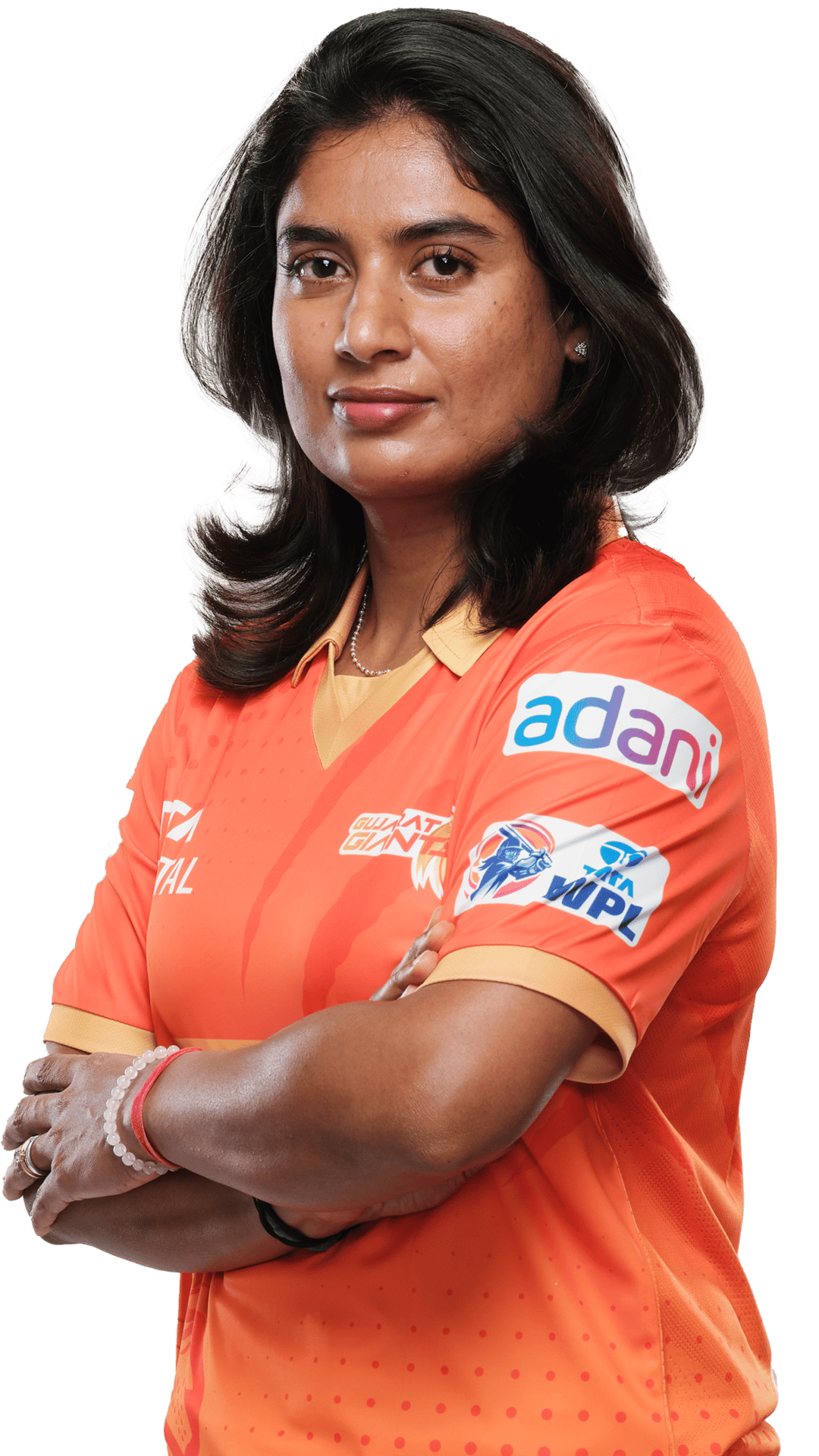
She/Her/them
A Relentless Force
Standing up and owning her power in a man’s world.
editor’s note
Issue 12 | March 2024

“May their stories ignite a fire within you …”
In this special edition of a-connect, we are proud to dedicate our pages to the remarkable stories of hope, courage and inspiration embodied by women across diverse walks of life. As we commemorated International Women's Day on 8 March, it is only fitting that we shine a spotlight on the incredible achievements and journeys of women who inspire us all.
Through narratives, profiles and features, our endeavour is to illuminate the boundless opportunities available to women, often hidden beneath the surface. Our focus is on showcasing the resilience, determination and unwavering hope that characterise those who dare to dream and pursue their aspirations relentlessly.
Moreover, we delve into initiatives aimed at uplifting marginalised women, empowering them not just to dream, but to turn those dreams into tangible realities. These stories serve as a reminder of the transformative power of empowerment and collective support in creating a more equitable society.
As you immerse yourself in the narratives within these pages, we invite you, dear reader, to draw inspiration from the indomitable spirit of the women featured herein. May their stories ignite a fire within you—a passion to envision a world where equality reigns supreme and to actively contribute to its realisation.
In addition to our celebration of women's achievements, this edition also embraces the vibrant hues of the festival of Holi. From traditional Indian delicacies to sustainable ways of celebrating, we present a colourful array of stories aimed at promoting health and happiness during festive seasons.
We extend our warmest wishes to you for a fulfilling and enriching reading experience. May the stories contained herein serve as beacons of hope, guiding us all towards a brighter, more inclusive future.
Happy reading! ●
contents
Newsmakers
Adani Electricity
Elevating Power Infrastructure In Mumbai
Adani Electricity launches India’s first Advanced Distribution Management System for enhanced power reliability in Mumbai.
Kandarp Patel
I
am thrilled to share with you the recent inauguration of India's first Advanced Distribution Management System (ADMS) at our state-of-the-art Network Operations Centre (NOC). This revolutionary technology powered by ADMS is set to redefine how Mumbai experiences electricity, ensuring a seamless and futuristic solution to power management.
Our NOC, equipped with ADMS, represents a significant leap forward in ensuring reliable power supply to over 31.5 lakh households and establishments in Mumbai. By harnessing real-time intelligence through a network of sensors and the latest Supervisory Control and Data Acquisition (SCADA) system, we can proactively predict and prevent outages, swiftly resolve disruptions, optimise network efficiency, and seamlessly integrate renewable energy sources for a greener tomorrow.
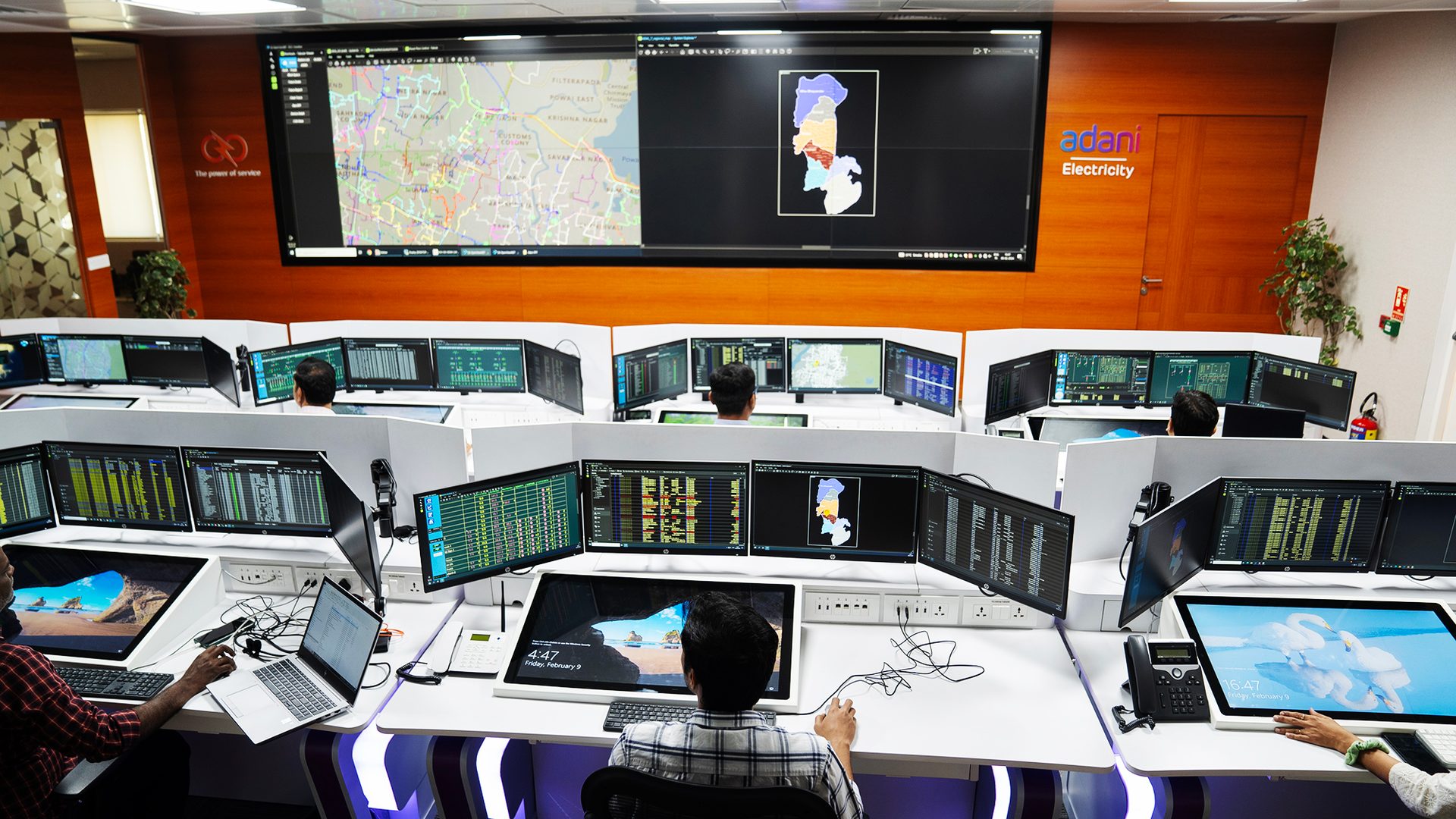
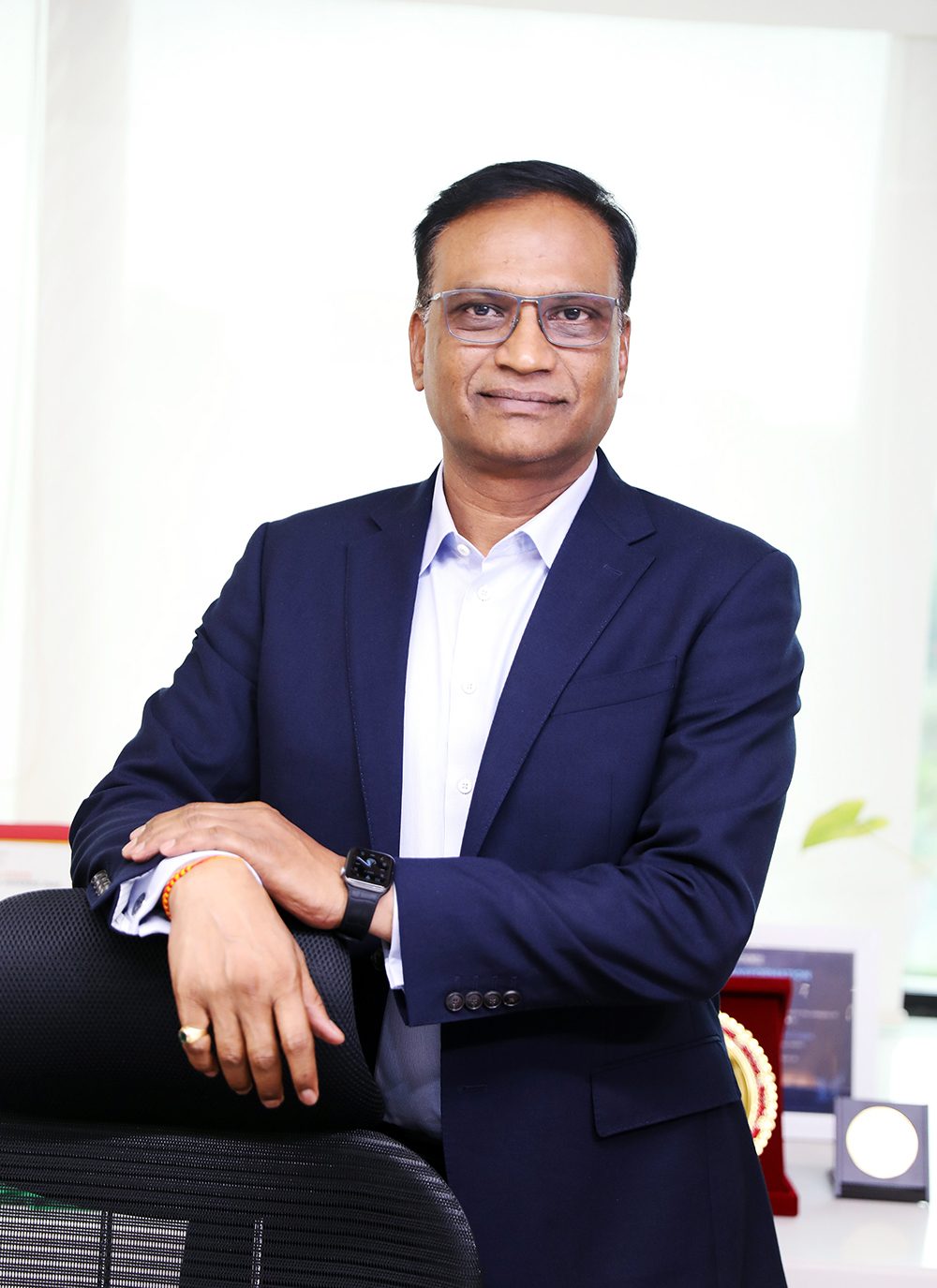
With our new NOC and ADMS, customers can expect reduced outages, shorter outage durations, and improved power quality, ensuring uninterrupted power for essential tasks and leisure.”
At Adani Electricity, we are committed to putting our customers first. With our new NOC and ADMS, customers can expect reduced outages, shorter outage durations, and improved power quality, ensuring uninterrupted power for essential tasks and leisure. Moreover, our network is fortified with robust cybersecurity measures and offers interactive visualisation tools for real-time monitoring and decision-making.
This milestone underscores our commitment to technological leadership and innovation. As we move forward, Adani Electricity remains unrelenting in our pursuit of excellence. Join us as we continue to innovate and shape the future of power reliability in Mumbai and beyond! ●
The writer is MD of Adani Electricity.
rights
Empowering Consumers
World Consumer Rights Day: Celebrating and raising awareness about consumer rights and needs.
Pankaj Kapoor
W
orld Consumer Rights Day was first observed on 15 Mar 1983, by Consumers International, a federation for consumer groups. Every year on 15 Mar, the global community comes together to celebrate World Consumer Rights Day, a day dedicated to raising awareness about consumer rights and advocating for consumer protection. This significant day, initiated by Consumers International in 1983, commemorates US President John F Kennedy's pivotal speech to Congress in 1962, where he outlined four fundamental consumer rights: The Right to Safety, Information, Choice and Voice.
Each year, World Consumer Rights Day adopts a specific theme spotlighting a particular facet of consumer protection. Throughout its evolution, this day has served as a platform for highlighting diverse themes crucial to consumer welfare. Past themes have included:
2023: "Empowering consumers through clean energy transitions"
2022: "Fair digital finance"
2021: "Tackling plastic pollution"
From empowering consumers through clean energy transitions to advocating for fair digital finance, each theme underscores the importance of safeguarding consumer interests in an ever-changing marketplace. In 2024, Consumers International has chosen "Fair and responsible AI for consumers" as the focal theme for World Consumer Rights Day. As artificial intelligence (AI) continues to permeate various aspects of our lives, from personalised recommendations to automated decision-making processes, ensuring ethical AI practices becomes paramount.
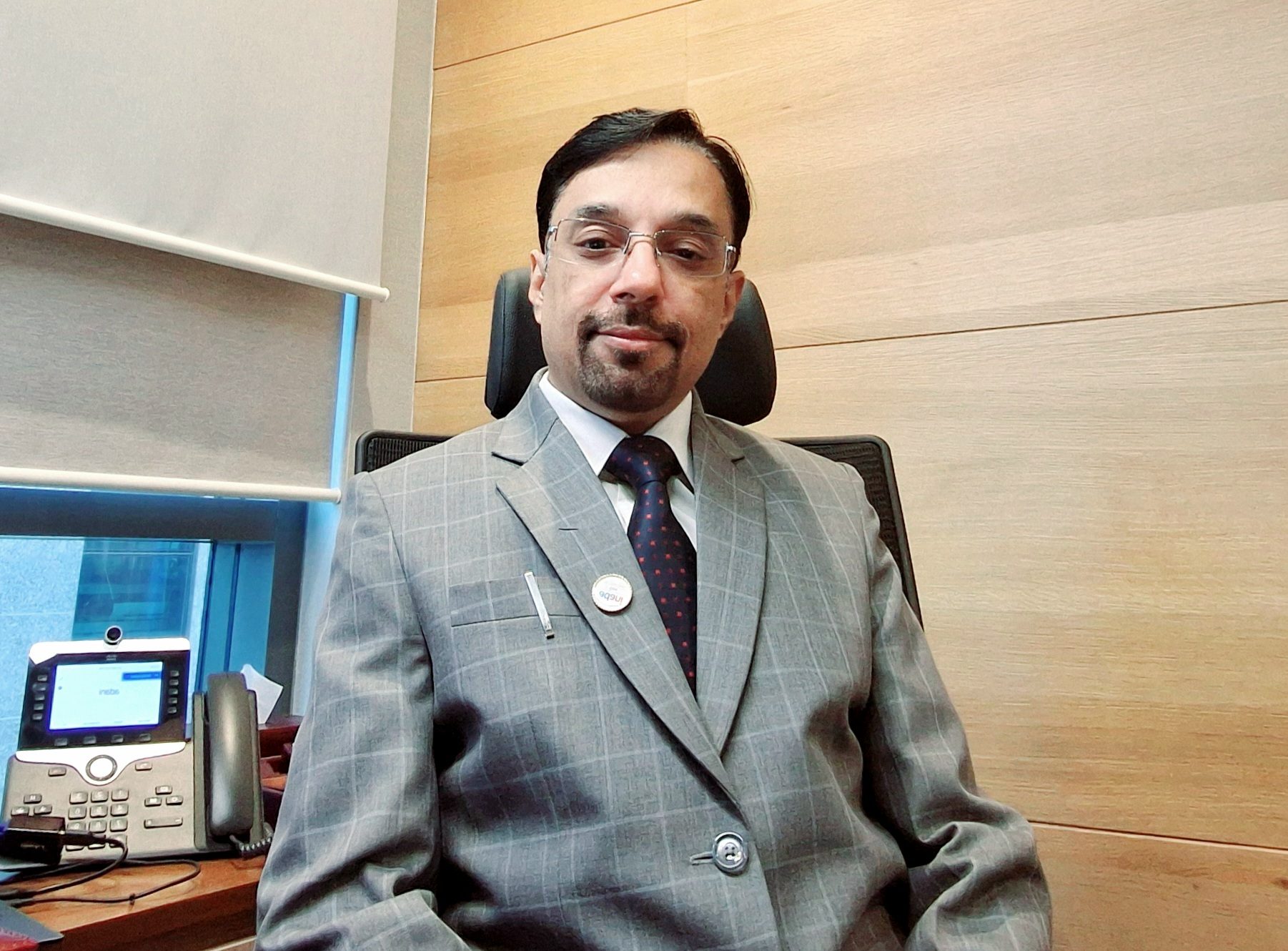
World Consumer Rights Day is an opportunity to celebrate the power of consumers and demand that their rights be respected and protected.”
The rapid advancement of generative AI technology brings both opportunities and challenges. While AI holds the potential to revolutionise industries and improve efficiency, it also poses risks to consumer safety and digital fairness. Concerns such as misinformation dissemination, privacy breaches, and algorithmic biases underscore the urgent need for regulatory frameworks and ethical guidelines to govern AI development and deployment.
Consumer advocacy groups, policymakers and industry stakeholders must collaborate to address these emerging challenges and promote fair and responsible AI practices. Transparency in AI algorithms, accountability for AI-driven decisions, and mechanisms for redress in case of harm are essential components of ensuring consumer trust and confidence in AI technologies.
By advocating for fair and responsible AI, consumers can harness the transformative power of AI while safeguarding their rights and interests. Through awareness campaigns, policy advocacy and collaborative initiatives, World Consumer Rights Day serves as a catalyst for driving positive change in the digital landscape.
As we reflect on the significance of World Consumer Rights Day, let us not forget the crucial role of legislation in safeguarding consumer interests. In India, the Consumer Protection Act originally implemented in 1986 (now the Consumer Protection Act 2019) stands as a testament to the nation's commitment to protecting consumer rights. With its guarantee of six basic rights to consumers, reinforced annually on National Consumer Day i.e. 24 Dec (date when the 1986 act received the Presidential Assent), India exemplifies the importance of legal frameworks in ensuring fair and ethical practices. As we navigate the complexities of the digital age and the advent of AI, let us draw inspiration from both global initiatives and local endeavours to create a future where consumer empowerment, protection, and advocacy remain paramount.
As we celebrate World Consumer Rights Day 2024, let us reaffirm our commitment to promoting consumer empowerment, protection, and advocacy in the era of AI. Together, we can shape a future where AI serves the common good and upholds the principles of fairness, transparency, and accountability for all consumers worldwide and we continue to champion the cause of consumer rights, shaping a world where fairness, transparency and accountability prevail for all.●
The writer is VP - Legal, Adani Total Gas Ltd.
impact
Adani’s Female Vanguard
This International Women’s Day, we take a dive into the vibrant tapestry of the Adani Group, where women are not just welcomed but celebrated.
Juhi Chakraborty
I
n today's world, the clarion call for diversity and inclusivity reverberates across industries. At the heart of this movement lies the Adani Group, a beacon of progressive values and equal opportunities. Join us as we hear firsthand from the trailblazing women of Adani, scattered across the nation, about their experiences, aspirations and the boundless opportunities they encounter within the company. Their stories echo the Group's unwavering commitment to fostering a culture of empowerment and growth for all.

Jyothi D
Nurturing Sustainability at Adani Ports, Gangavaram and Krishnapatnam
“Since joining Adani in 2021, my journey has been nothing short of remarkable. The positive work culture resonates with integrity at every turn. Here, the opportunities for women are boundless, devoid of any discrimination. Your success hinges solely on talent. Efficiency is rewarded, and equal rights are not just a notion but a reality we live by.”
Rosalin Pradhan
Pioneering Operations at Adani Ports, Mundra
“Having joined the Adani Group just last year, I've witnessed a heartening shift towards inclusivity. More and more women are being welcomed into our department, marking a progressive stride towards gender balance. The tide is turning, and inclusivity is becoming our new norm. Hiring more female employees is a testament to our commitment to fostering a diverse and equitable workplace.”


Madhumita Bal
Scripting Success in Documentation at Adani Ports, Dhamra
“Since 2010, I've found solace in the safe, supportive environment that Adani fosters for women. Despite being outnumbered in my location, my voice carries weight, and leadership opportunities are encouraged. A decade-long tenure speaks volumes about feeling valued and recognised within this organisation.”
Archana Sinha
Catalyst for Change at Adani Foundation, Godda
“Over four and a half years with the Adani Foundation, I've experienced consistent growth and invaluable learning opportunities. Despite the challenges of working in Godda, the company's unwavering commitment to my safety and well-being is palpable. From providing secure travel arrangements to facilitating a nurturing work environment, Adani stands as a beacon of support for its female employees.”


Aabha Didwania
Spearheading Growth at Container Terminal Operations, Adani Ports, Mundra
“My journey since joining in June last year has been defined by unwavering support from my team and manager. Gender is no barrier here; equal opportunities abound for all. Discrimination finds no home in this female-friendly organisation, where talent and dedication are the only metrics that matter.”
Palak Saxena
Designing Dreams at Adani Realty, Gurgaon
“Though relatively new to the company, I've already experienced a workplace where my voice is valued and heard. Discrimination is nonexistent, and the work-life balance afforded to female employees is a breath of fresh air. Unlike my peers elsewhere, late-night work hours are not a norm, enabling us to strike that elusive balance between work and life.”


Ridyani Rathore
Prospering in Adani's Logistics Hub, Vapi
“I have been with Adani for two years now post the acquisition. The work experience has been good. We are learning new things on the job everyday and that has been very encouraging. My career has seen an upward graph and I feel that I have the same rights and opportunities as my male colleagues.”
Smita Brid
Orchestrating Operations at MIAL, Mumbai
“Adani's recognition of my efforts has been a driving force behind my journey. The trust reposed in me by seniors has empowered me to spearhead technological innovations, driving the company towards digital transformation. Collaboration with an exceptional team ensures seamless operations, epitomising Adani's ethos of empowerment.”


Pooja Negi
Soaring to New Heights at Liquid Terminal, Adani Ports, Hazira
“I joined Adani last year. I was with Indian Air Force for 15 years prior to that. I have received a lot of support from the team members, my seniors and superiors. My one year has been very fruitful and good. There is a lot of encouragement. I do feel that if you have the zeal and work hard, the opportunities are endless here.”
Neelam Vyas
Thriving in Adani's Logistics Hub, Vapi
“I have been with this company for 4 years. I was with Navkar Corporation before the takeover in October 2022. Post that, my experience has been very good, in fact way better than my previous experience because there is equality. The facilities provided by the company for its female employees is commendable especially when it comes to safety and security.”

As the world celebrates International Women's Day, the Adani Group stands as a shining example of empowerment and inclusivity. Through its unwavering commitment to fostering a culture of equality and opportunity, Adani not only empowers its female workforce but also paves the way for a future where gender disparities are but a distant memory. In the tapestry of Adani's success story, every thread—irrespective of gender—finds its rightful place, weaving a narrative of empowerment, growth and boundless possibilities. ●
insights
The Relevance Of Schooling In The Modern Age
Adani International School is beginning to carve a unique model of education.
Dr Sergio Pawel
I
n the digital era, where information is readily available, the focus of education has shifted from mere acquisition of facts to the organisation and application of knowledge. Central to this shift is the concept of relevance, which has empowered students to take a more active role in their learning.
The acquisition of factual knowledge has been displaced by the priority given to the organisation of data and facts as a focal point of education. We have rapidly mastered the skills hinged on organisation to climb further up in our aspirations for a school fitted to the 21st-century world.
Today, the concept that dominates academic discussions about the purpose of schooling is the concept of ‘relevance’.
It is through the concept of relevance that the students have finally managed to dislodge the school leaders and the teachers from their pedestals to occupy a centrestage.
Nowadays, if a teacher cannot immediately and overtly recognise the students’ relevance in a school activity or concept being studied, one can no longer justify its existence in the educational programme.
It is within this modern conception of education that I would like to describe my recent experience while attending the science fair exhibition at the Adani International School.
Last week the middle school building also known as the STEAM building because it congregates the specialist classrooms of Science labs, Technology workshops, Art studio and Maths classrooms was transformed into a living gallery of the future thanks to the student led science fair, which was intriguing in the level of ingenuity displayed, diverse in the range of projects and solutions and vibrant thanks to the excitement of the young entrepreneurs.
The young scientists demonstrated the extent to which they are perfectly capable of engaging with real-life issues that are troubling their immediate surrounding as well as some issues of a global scope.
For instance, Darsh Makadia, Vihaan Binaykia, Jai Patel, and Krish Tandon of Grade 8 created prototypes of edible cutlery. A simple, creative solution for our ever-growing affinity with disposal of utensils that are piling up in waste lands. The way in which such a simple and creative idea could only emerge in the minds of young scientists capable of combining subjects like physics and biology in the context of environmental transformation is a hallmark of student’s agency in modern age.
However, great ideas were not the monopoly of one group. Yug Parikh and Aarush Shah of grade 8 tackled the excessive packaging generated by online retail giants like Amazon, demonstrating a keen awareness of global environmental concerns.
Being the recipients of these packages, the students were fully aware of the magnitude of the carbon footprint one single company is responsible for. It is rewarding to hear students embracing global issues and taking personal interest in what was once ‘someone else’s problem’.
Projects like the research on producing biogas from algae by Mohanraj Khanna, Dhairya Gupta, Dhwanil Shah, and Vihan Shah of grade 8, and investigations into greenhouse gas emissions by Nishil Dudhwewala, Jay Parekh, and Prakhar Mahajan of grade 7, demonstrated collaborative efforts and a commitment to addressing environmental challenges. The demonstration of Solar Irrigation by Vani Adani, Dhruv Rai, and Vansh Ratadia of grade 7 through a functional model was commendable, effectively addressing the pressing concerns of energy and water conservation.
The science fair also highlighted emerging technologies, with students exploring innovations like solar-powered drones, indicating a promising future for scientific research and development.
It is tremendously exciting and a real privilege to head a school that is prepared to incorporate an educational landscape where the children are genuinely placed at the centre of the schooling project and have the opportunity to drive their own learning process through meaningful projects that are addressing real-world issues. In a magical way, the alchemy of combining learning with the development of a sense of common responsibility towards our and planet and society is manifested through all the passionate presentations I witnessed. ●
The writer is Head of Adani International School.
innovation
Harnessing Solar Power
As India charts its course towards renewable energy dominance, Adani Solar emerges as a beacon of innovation and progress, catalysing the nation's transition to a sustainable future powered by the sun.
Cecil Augustine
D
uring recent years, India has emerged as a key player in the global solar energy revolution, securing its position as the fourth-largest market for solar energy, as per a recent report by MNRE. The Indian solar industry has witnessed a significant transformation, with installed capacity skyrocketing from 21,651 MW to 70,096 MW in 2023, as reported by INVEST INDIA.
This remarkable growth is propelled by ambitious targets set by the Government of India's MNRE and initiatives like the Production Linked Incentive (PLI) schemes, KUSUM scheme and the recently introduced PM Surya Ghar Mufti Bijli scheme. With a steadfast commitment to achieving 500 GW of renewable energy capacity by 2030, India is not only advancing sustainable energy but also paving the way for a greener future, crucial for the nation's energy security and the decarbonisation of its power generation sector.
Adani Solar, the solar manufacturing arm of the Adani Group, envisions harnessing the power of the sun to bring hope and prosperity to billions across the nation. Through its renewable and sustainable energy initiatives, the company aims to realise India’s aspiration of becoming a global leader in Solar PV Manufacturing. Adani Solar is focused on building the world’s first fully integrated and comprehensive solar manufacturing ecosystem, encompassing MG silicon, Polysilicon, Ingots, Wafers, Cells and PV Modules, each with a capacity of 10GW, alongside ancillary units like Glass, Aluminum frames, and POE (EVA & Backsheets), all located in Mundra. This commitment to manufacturing expansion embodies the spirit of atmanirbhar Bharat, addressing the challenges in the solar PV supply chain.
Employing cutting-edge technology sourced from top-tier suppliers, Adani Solar ensures cost leadership, scalability and reliability benchmarked against global standards. With India's solar installations projected to soar in the next five years, Adani Solar stands ready to support this exponential growth while maintaining its dominant market position.
As India's premier vertically integrated solar company with a manufacturing capacity of 4 GW, Adani Solar pioneers indigenous manufacturing capabilities, recently achieving a milestone by producing India’s first large-sized monocrystalline Ingots and wafers from its pilot line. The company's Ingot & Wafer manufacturing facilities are designed to accommodate potential future technological changes, such as an increase in wafer and module sizes.
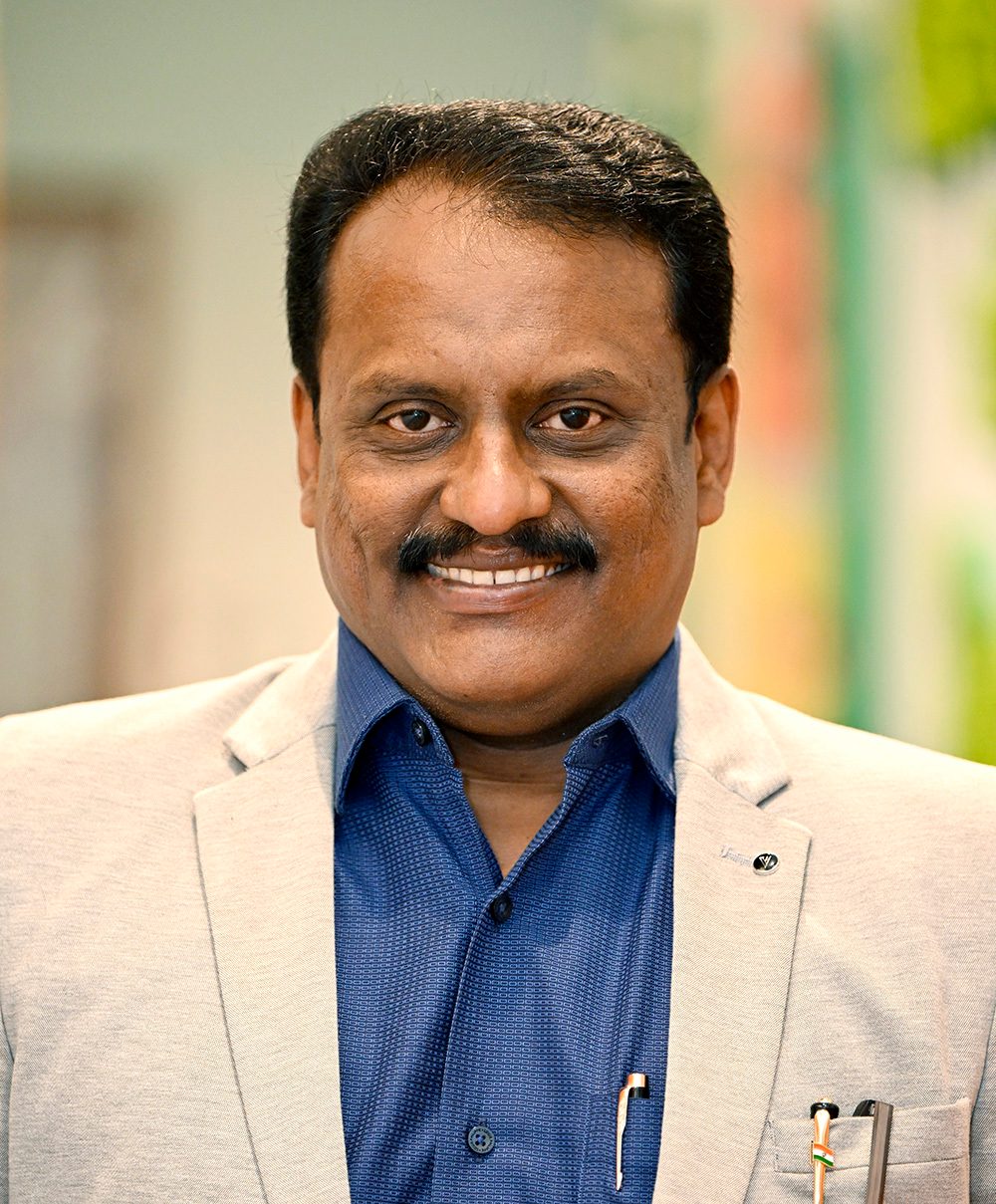
Our commitment to sustainable energy is not just about harnessing the sun’s power; it’s about empowering billions across our nation with hope and prosperity.”
Moreover, Adani Solar's introduction of the groundbreaking TOPCon PV module underscores its commitment to adopting advanced solar technologies. Outperforming PERC modules in both Watt-peak (Wp) and efficiency, the TOPCon module is well-suited for India's diverse weather conditions. The company remains dedicated to embracing advanced solar technologies to enhance competitiveness and contribute to a greener and more sustainable future.
In terms of India’s retail market presence in Solar, Adani Solar has rapidly expanded its retail footprint across the nation. Through its retail channel partners, the company has established a significant presence in multiple states, including Rajasthan, Uttar Pradesh, Delhi, Haryana, Maharashtra, Gujarat, Madhya Pradesh, West Bengal, Kerala, Tamil Nadu, Telangana, Andhra Pradesh, Odisha, Sikkim, Assam, Manipur, Mizoram, Arunachal Pradesh, Meghalaya, Nagaland and Tripura. Globally, Adani Solar has consistently been one of India’s largest exporters of Solar PV modules to the USA for the past 3 years.
Spurring India’s journey of Growth with Goodness and Solar’s journey for India to GetSUNplugged, Adani Solar is well poised to embark on an industrial revolution. ●
The writer is National Head - Sales & Marketing of Adani Solar.
community
Ripples Of Change


From grassroots engagement to sustainable solutions, the Adani Foundation is uniting communities for a future where water sustains life and livelihoods.
Arpita Vadgama
A
s the impacts of climate change intensify and the global population expands, it becomes imperative for us to unite in safeguarding and conserving our most precious resource – water. This year's theme, 'Water for Peace', underscores the pivotal role that water plays in ensuring stability and prosperity worldwide. In India, which harbors 18% of the world's population but only possesses 4% of its water resources, the challenge of water scarcity looms large.
Groundwater is a vital resource for India's agriculture, industry and populace. In rural regions, community wells and borewells serve as primary sources of drinking water, indispensable for farmers and industries alike. Therefore, sustainable groundwater management becomes paramount to secure its long-term availability.
Equitable access to safe water and sanitation can reverse many problems in rural India – not by just enhancing the health and hygiene status of people but also their quality of life – it gives communities the freedom to focus on work, education and nutrition. The conceptual prescriptive solutions include prudent utilisation, replenishing groundwater by watershed management and afforestation.
The Adani Foundation, privileged with the responsibility of working alongside communities in water conservation and management, is committed to fostering engagement and convergence at the grassroots level. By collaborating with governmental departments, Gram Panchayats, farmers' groups, and community members themselves, the Foundation facilitates the implementation of highly localised, comprehensive programs, ensuring smooth execution and impactful outcomes.
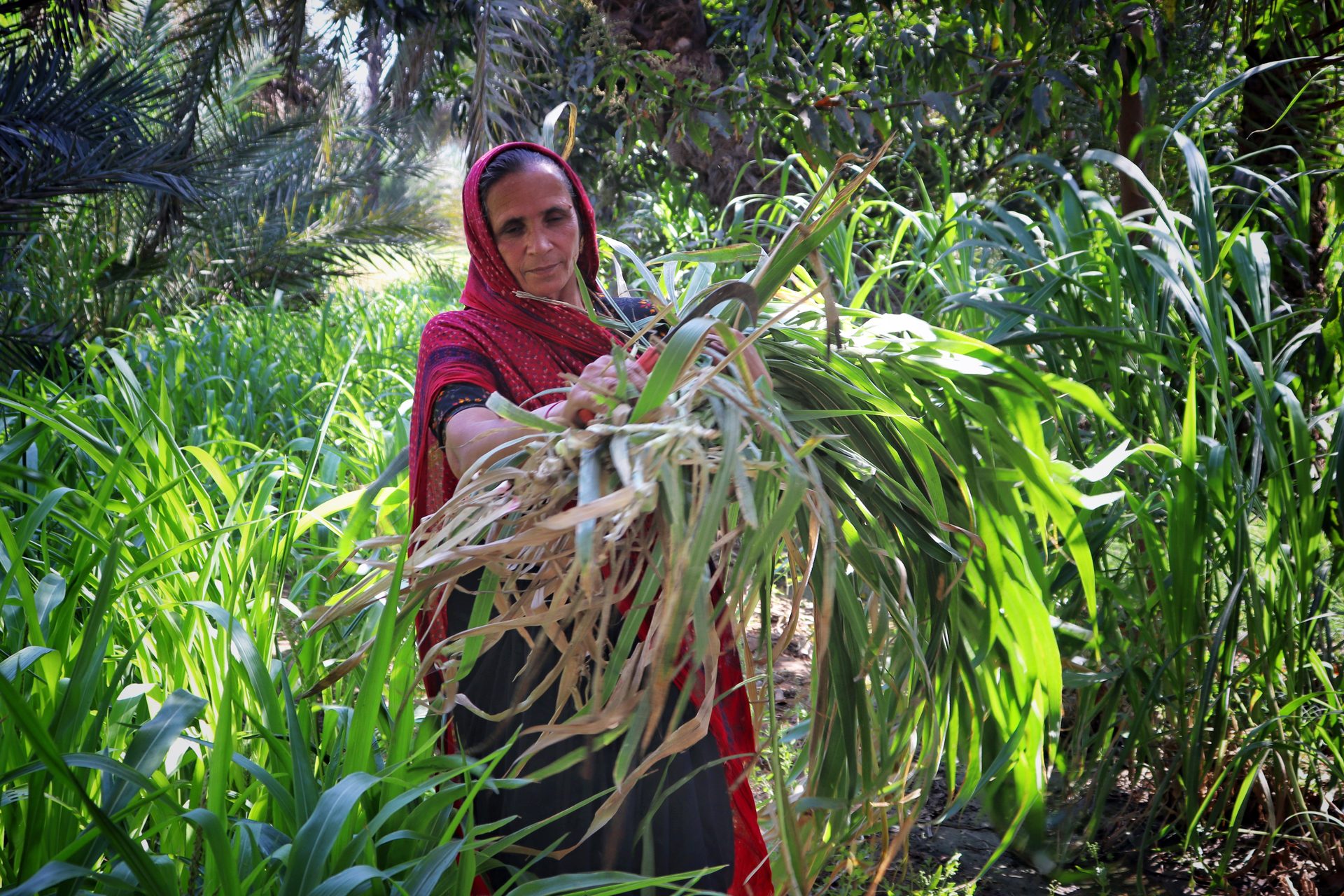
While building check dams in water stressed areas is indispensable, the Adani Foundation has been implementing practices of recycling and re-utilisation of water. This was not possible without entering the backyards and farms of the people. The CSR teams have held community meetings, soliciting partnership to introduce rooftop rainwater harvesting, pond deepening and bore-well recharge methods. These are affordable, easily implementable and highly replicable techniques. The Foundation is also promoting user efficiency through drip irrigation, providing support for expansion of horticulture and encouraging reduced water intensity in agriculture by influencing cropping pattern.
Illustrating this further, let us journey to Mundra in Kutch, India's westernmost tip, where the Adani Foundation initiated water conservation efforts under Project Swajal in the face of water scarcity. Take, for instance, Virbai Seda from Zarpara village, who, with the installation of a rainwater harvesting structure, now enjoys a steady supply of drinking and cooking water for her family, along with utilising recharged borewell water for domestic and irrigation purposes. Earlier, every single day her family would have to either buy filtered water bottles or travel to get 20 litres water from the Panchayat. With a rainwater harvesting structure installed prior to the monsoon season last year, a 10,000-litre tank is filled, enough to fulfil the drinking and cooking water requirements for her family of five members until the next monsoon. Virbai’s home uses water from a recharged borewell for other domestic and irrigation purposes – they employ the drip irrigation method extensively. The family grow dates for commercial sale and alongside the NB21 grass for good quality and copious fodder for the cattle. An adjacent kitchen garden makes enough seasonal vegetables and fruits available for the household. The family benefits from the home biogas connection, the slurry from which is used as manure for the fields. This ‘model farm’ is a result of collaboration between the Seda family and the Foundation team.
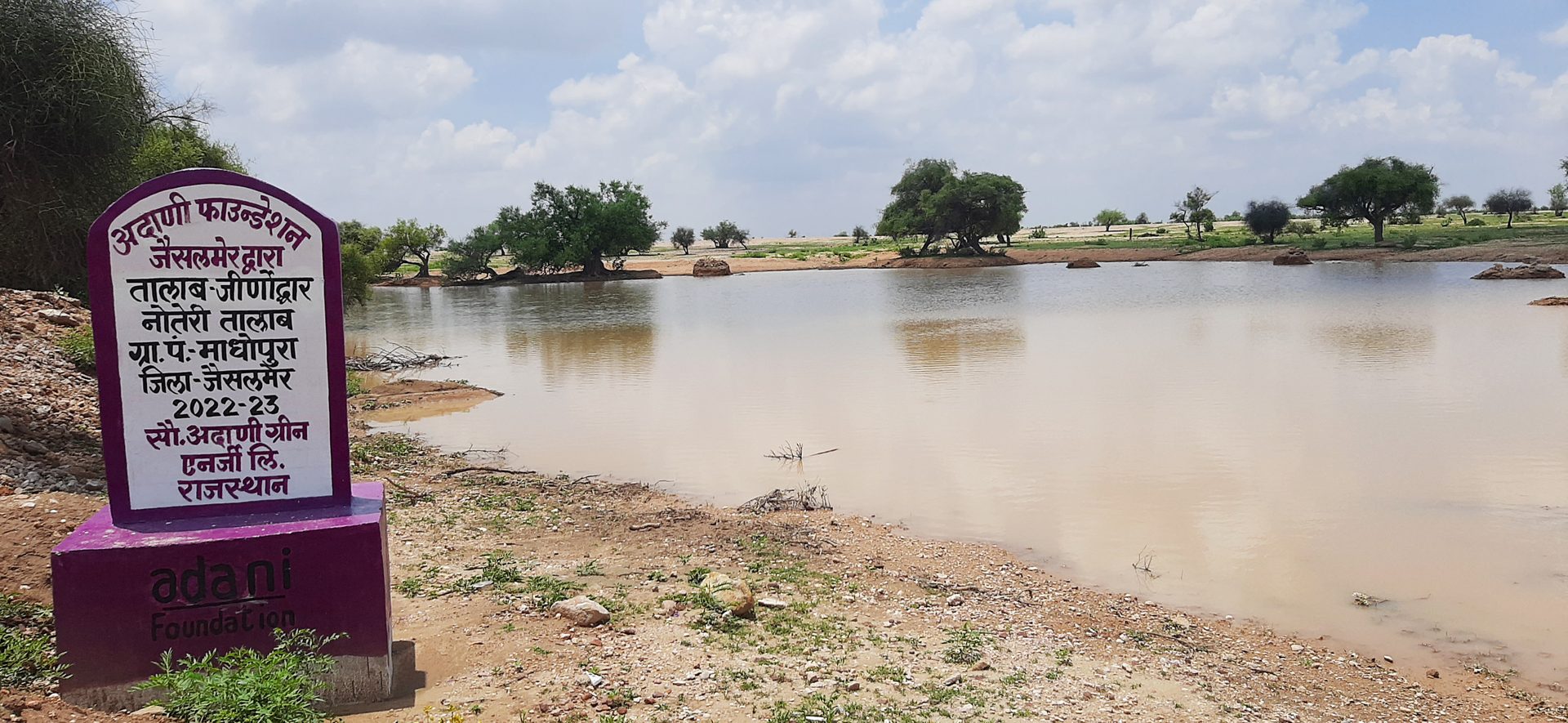
Further north, in Thar desert of Rajasthan, people have relied on an ancient and wise practice – the construction of village ponds. These ponds are their lifelines. The ponds just not provide drinking water for people but also support animals and sometime crops. Despite the modern facilities and popularity of tubewells and canal water, elders recognise the ponds as their identity. Ponds are deeply ingrained in culture. Understanding the critical need for water conservation in these dry landscapes, the Adani Foundation aimed to revive the heritage of the ponds. Gaffur Khan, the Sarpanch of Madhopura village says the importance of the Noteri pond for people of the nearby villages cannot be stressed enough. He acknowledged the Adani Foundation's remarkable work in reviving the ponds. The success of these water conservation efforts goes beyond resource management. These ponds are cultural symbols, and the Adani Foundation's dedication has not only rejuvenated water bodies but also secured a promising future for resilient villages.
Upon travelling to the centre of India, we reach Gondia district, which falls in the arid zone of Vidarbha in Maharashtra. The annual rainfall is sufficient, but it is the erratic nature of monsoon which is a cause of concern as the area experiences long dry spells. To address the scarcity of drinking water and lack of irrigation sources, the Adani Foundation took the first steps in 2011 with the construction of pond and pond deepening at Ramatola village. Collectively, water conservation endeavours like check dam construction, borewell recharge and pond deepening have not only supported agriculture but also contributed to raising the water table by 3-4 feet in the surrounding villages, effectively addressing the issues of drinking water scarcity and inadequate irrigation sources in the region.
Through various water management and conservation works, the Adani Foundation has increased water storage capacity to 13.78 million cubic metres. This is equal to the yearly drinking water requirement of 75.5 lakh people! Water literacy bolstered by sound practices in communities has cultivated good health, good crop as well as immense value, translating well into economic prosperity.
In conclusion, on this World Water Day, let us reaffirm our commitment to collective action in safeguarding this invaluable resource, recognising that engagement and convergence are indispensable in forging pathways toward peace and prosperity for all. ●
Breaking Boundaries
cover story
Dive into the dynamic world of women's cricket with the trailblazing Mithali Raj, as she shares her remarkable insights on empowerment, leadership and the enduring legacy of the game.
Juhi Chakraborty
I
n a nation where cricket is more than just a sport, Mithali Raj has shattered stereotypes, proving that female athletes can be icons too. With a stellar career in cricket, she has transcended boundaries to become not just a sporting legend but also a cultural icon, inspiring countless young girls to pursue sports as a career. Currently, as the mentor of the Gujarat Giants in the Women’s Premier League (WPL), Ms Raj continues to blaze a trail for women in cricket.
In an exclusive interview, former Indian women’s cricket team captain and mentor of the WPL team Gujarat Giants, Mithali Raj, discusses her journey as a female sporting icon, the future of women’s cricket and her pivotal role in empowering women through sports.
As we celebrate Women’s Day in March, what message do you have for women everywhere?
Let us celebrate the strength, resilience and achievements of women in every sphere of life. May we continue to strive for equality, empowerment and opportunities for women in sports and beyond.
What does your association with Gujarat Giants mean to you?
Being associated with Gujarat Giants fills me with pride and a sense of responsibility. It is an honour to mentor such a talented team that embodies the vibrant spirit of Gujarat.
As a mentor, what is your key message to your team before every match?
Before every match, I emphasize the importance of self-belief, playing with passion and embracing the joy of the game. Trust in your abilities and give your best on the field is what I tell them every time.
How do you believe tournaments like WPL enhance women's cricket and its popularity?
Tournaments like WPL provide a vital platform for players to showcase their skills and talent, elevating the visibility of women's cricket. They inspire more girls to pursue cricket professionally.
As a cricket legend, how do you ensure young girls stay grounded amid fame and fortune?
It is crucial for young girls to remain grounded despite fame and fortune. True fulfillment comes from a genuine love for the game and dedication to continuous improvement.
How do overseas players impact the Indian players in such tournaments?
The presence of overseas players like Laura Wolvardt, Ashleigh Gardner, Phoebe Litchfield brings valuable experience and adds depth to the competition, pushing Indian players to elevate their game. It fosters a culture of learning and growth within the team.
With corporate investments like the Adani Group, do you believe women’s cricket is now receiving the recognition it deserves?
Absolutely. Investments from corporate entities like the Adani Group signal a significant shift in the perception of women's cricket. Mr Pranav Adani's support for the Women’s Premier League and the set-up of the Gujarat Giants' women's cricket team underscores a genuine commitment to advancing the sport. It reflects a growing recognition of its potential and importance in talent development.
What more can players and organisers do to attract more fans to the ground?
The enthusiasm for women's cricket is evident, with recent matches witnessing full stadiums. As players, our focus should be on entertaining the fans, and the rest will naturally follow. As Ms Raj continues to inspire and lead by example, her journey serves as a beacon of hope for aspiring female cricketers across the nation. With her unwavering dedication, she paves the way for a brighter future for women in sports. ●
From Young, Wondering Women To WONDERWOMEN!
go beyond
Amid the cacophony of super-achievers, let us pause to marvel at the quiet resilience and remarkable triumphs of ordinary women turned WonderWomen.
Arpita Vadgama
W
e are often captivated by tales of super achievers – the best, the first, the fastest, the strongest, and so on. They dominate news headlines and social media feeds, representing clear vision, unwavering determination, and the realization of dreams. But what about those who navigate through life with sheer resilience, finding their way despite the odds? Those who, against all odds, make it to the top? This Women’s Day, we celebrate the triumphs of these unsung heroes.
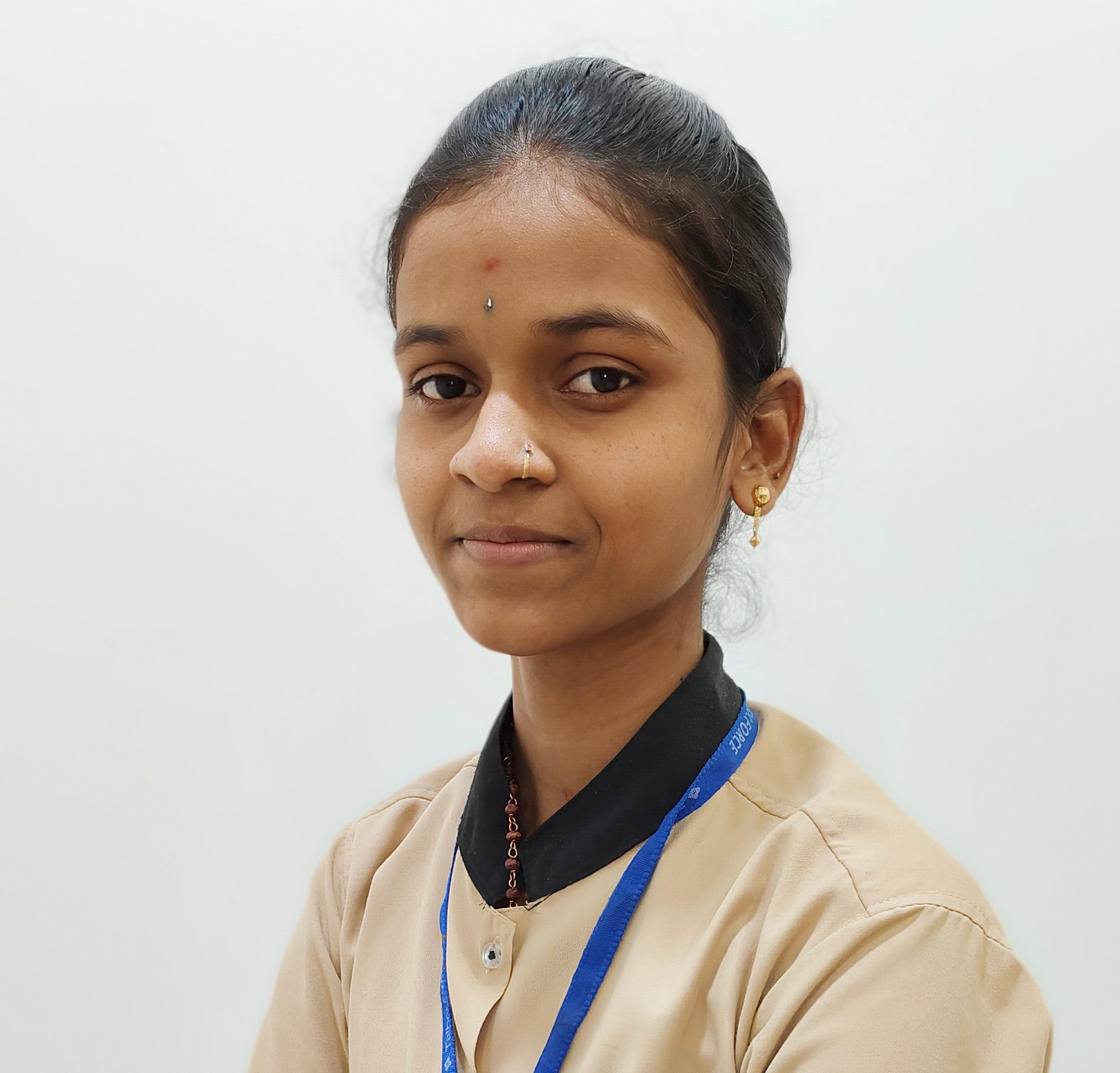
Suma – A Touch of Care
Hailing from the village of Halkatta, nestled in the Gulbarga district of Karnataka, Suma's educational journey halted at grade XII. Born into a family reliant on seasonal agriculture for sustenance, higher education seemed an unattainable dream. Undeterred, Suma harboured an inner drive for financial independence. Guidance from the Adani Skill Development Centre in Wadi town led her to enroll in the General Duty Assistant (GDA) course.
Enduring an intensive 3-month training regimen encompassing online, offline, and Virtual Reality (VR) sessions, Suma mastered anatomy, CPR, BP monitoring and essential IT and soft skills. Her diligence and dedication bore fruit when she received three job offers. Opting for AIG Hospital in Hyderabad, Suma seized the opportunity for personal and professional growth, securing a competitive monthly package of INR 20,500. Today, as a Patient Care Assistant, she not only supports her family but also extends compassionate care to numerous patients
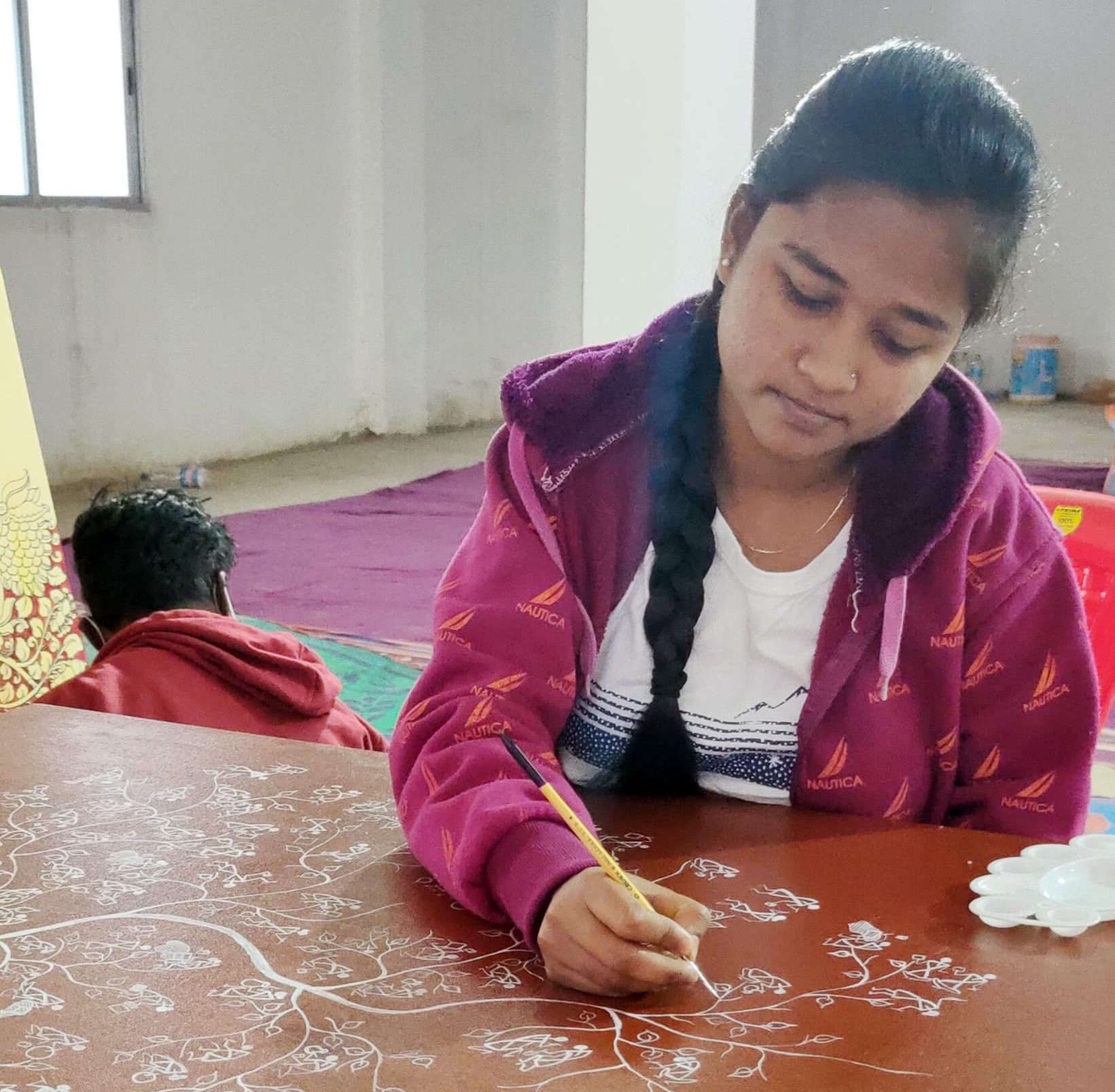
Urmila Vayeda – Artful Living
Urmila Vayeda, a Warli artisan from Dahanu, Maharashtra, inherited her craft from her mother, Minakshi, who learned Warli painting from her father. Despite completing her education at grade VIII, Minakshi devoted herself entirely to Warli art, sustaining the family as both an artist and teacher. Urmila, following in her mother’s footsteps, ventured into the world of Warli art after graduation.
Accompanying her mother to exhibitions and art camps from a young age, Urmila immersed herself in the art form, infusing her unique style into traditional designs. Collaborating with the Adani Foundation's project Sathwaro, Urmila and Minakshi found not only new artistic opportunities but also avenues for growth and skill enhancement. At 25, Urmila's dedication was recognised with the Sanmaan Award for “Young Artisan 2024” by the Crafts Council of Telangana. With unwavering commitment, she envisions a future where Warli art continues to uplift her family.
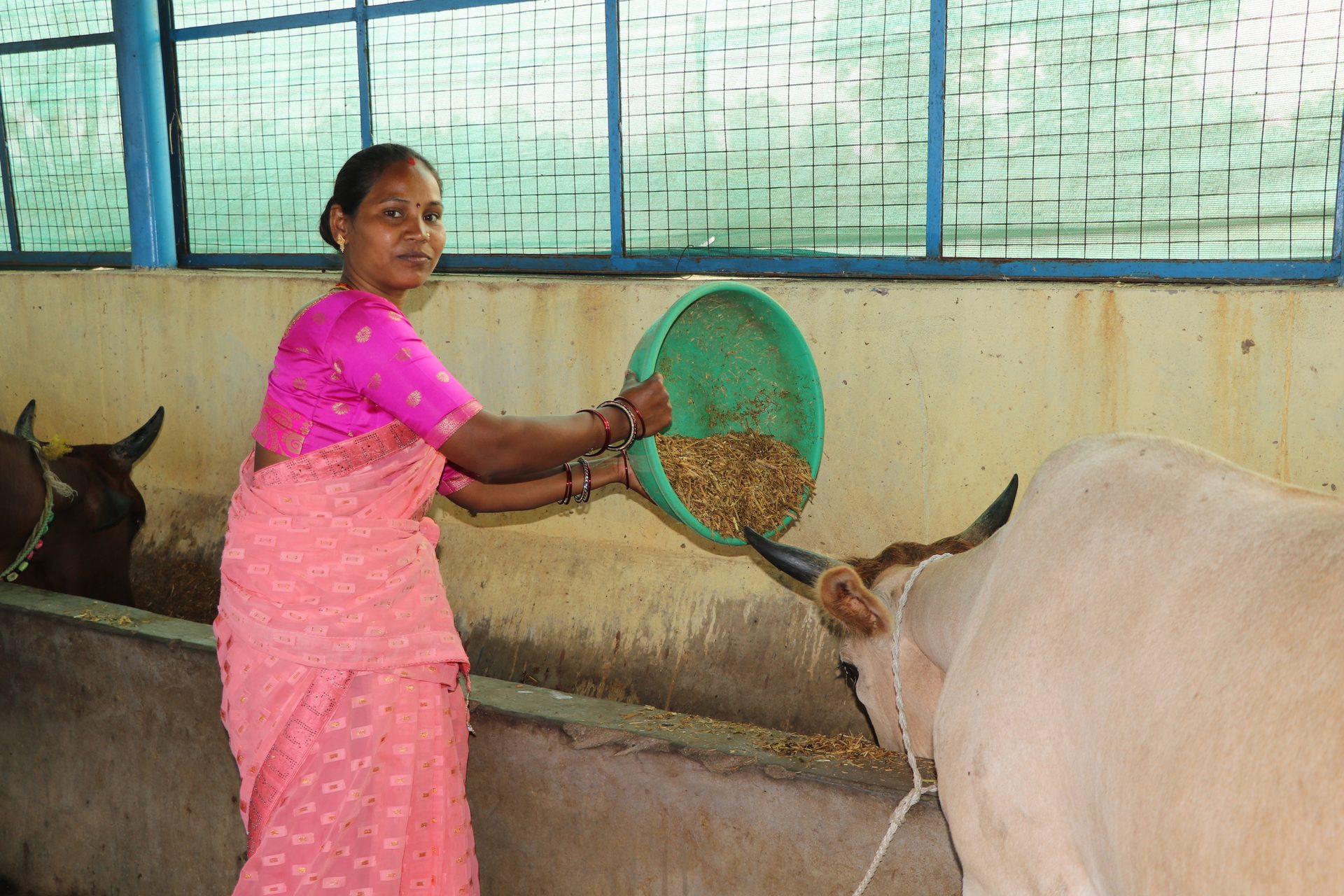
Anaso Porte – Enterprising Her Way
Anaso Porte, a tribal woman from Salhi village in Surguja district, Chhattisgarh, epitomises resilience and determination. Hindered by domestic responsibilities and societal constraints, Anaso's life transformed when she joined the Mahila Udyami Bahudeshiya Sahkari Samiti (MUBSS), a rural cooperative supported by the Adani Foundation.
Empowered by MUBSS, Anaso assumed management of the dairy unit in her village. Overcoming initial hesitation, she embraced the challenge, bolstering her confidence and augmenting her income. Her newfound empowerment not only elevated her status within the household but also inspired fellow women to embark on their journeys toward self-reliance.
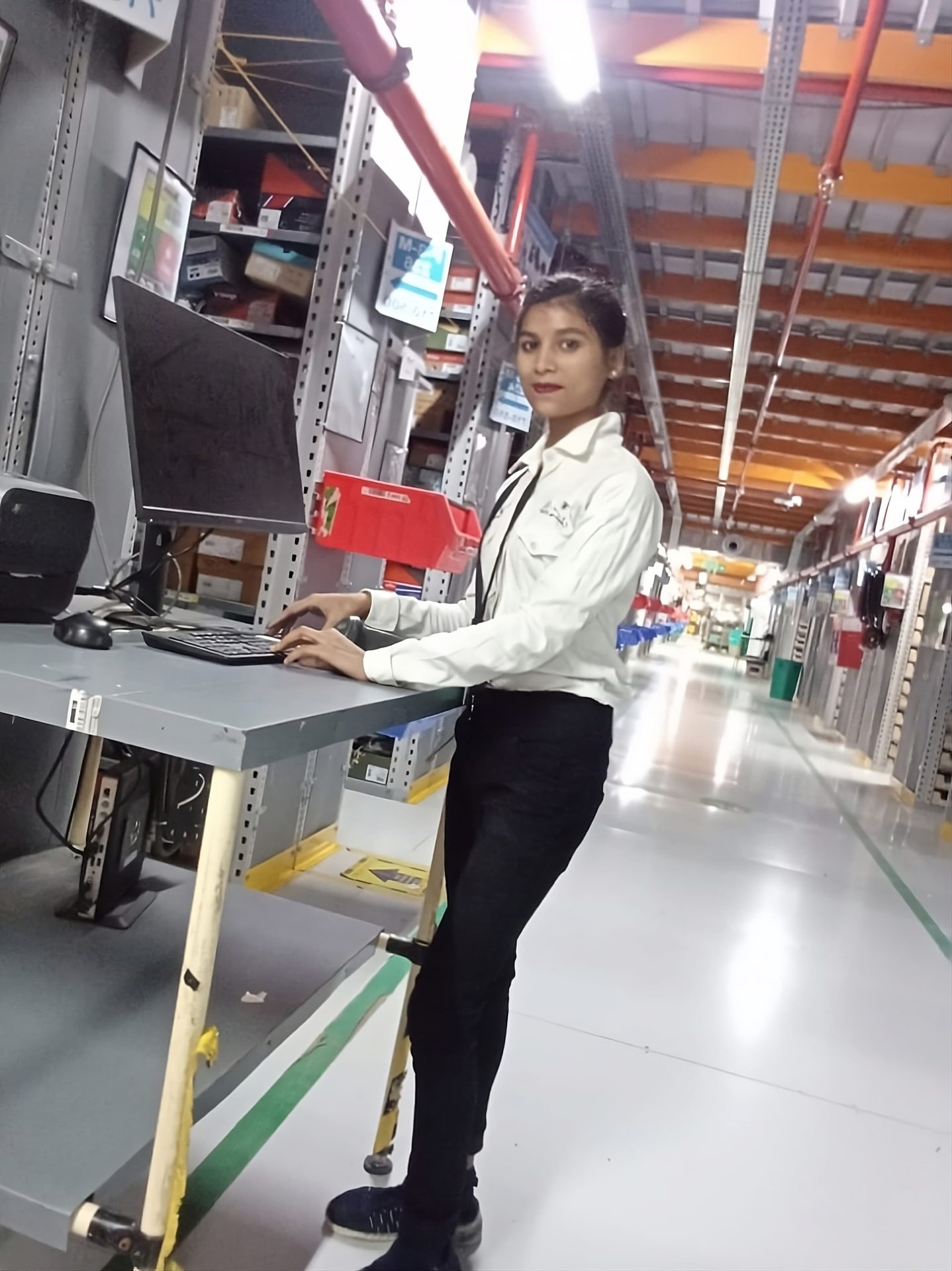
Nisha Dahiya – The Will to Skill
Nisha Dahiya, a 22-year-old resident of Bhaiswahi village in Katni, Madhya Pradesh, refused to let financial constraints hinder her aspirations. Forced to halt her education after schooling, Nisha's determination led her to the Adani Skill Development Centre (ASDC), where she enrolled in the Warehouse Packers course at the Saksham centre in Kymore.
Completing her training in Sept 2023, Nisha secured a position as a warehouse executive at Amazon's Ahmedabad facility, starting with a salary of INR 13,500 per month. Today, earning around INR 18,000 monthly, Nisha attributes her success to the transformative training at the Saksham centre. With her newfound stability, she eagerly anticipates renovating her family's home in Katni, ensuring their comfort and security during the monsoon season.
These remarkable stories of resilience and triumph serve as a testament to the indomitable spirit of women, proving that with determination and opportunity, they can transform dreams into reality. This Women’s Day, let us celebrate these unsung heroes – the true WonderWomen of our society. ●
She, The Enabler
opinion
The writer is Chairperson of the Adani Foundation.
Addressing gender gaps in employment makes for more resilient and healthy society.
Dr Priti Adani
H
arsha Sidar, a determined girl from a tribal village, realised her dream of becoming a doctor by successfully qualifying for medical studies in 2023, a remarkable feat for a first-generation learner in her community. Despite the challenge of studying in Hindi and overcoming significant eye health issues, Harsha never wavered. She compensated for lost time, juggled NEET preparation with her 12th grade curriculum, took advantage of free online coaching classes, and secured admission to Raipur Medical College. Her success, alongside 16 other girls who gained admission to prestigious schools, paves the way for future aspirants in her community.
In Tamnar, Chhattisgarh, seven tribal women aged 20-25 seized a transformative chance with a free six-month training program for careers in Fire Safety and Disaster Management in Vadodara. Their courageous action to step out of their village for education led them to become guards at Gare Palma mines, significantly improving their lives.
These stories of transformation in the lead up to International Women’s Day provide an occasion to consider where we stand as a society on women’s empowerment, to acknowledge the progress made, and to reflect on what will accelerate the pace of change given the enormity of the challenge.
India’s ambition to be a developed economy by 2047, to mark the 100th anniversary of our independence, is an exciting prospect. But neither our nation nor our people can achieve that goal without the inclusion and involvement of India’s women, who make up nearly half the population.
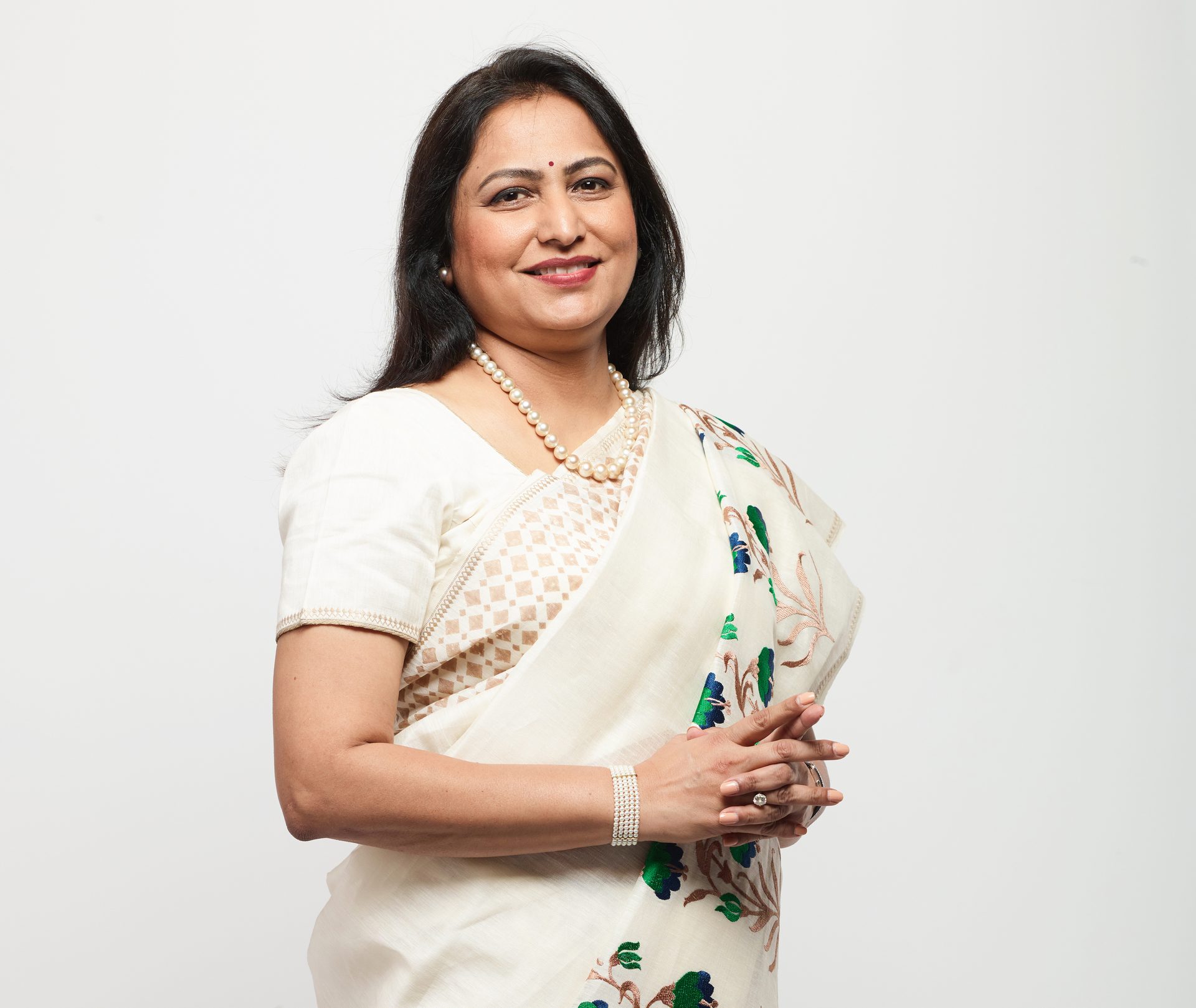
Much of the discussion has focused on the achievement of economic indicators, and rightly so, as GDP growth with consequent employment creation is a critical enabler of broader social progress.
Much has also been written about how society and the economy can leverage the untapped human potential of India’s female population. A 2018 report by McKinsey noted that women contributed only 18% to the GDP of India, despite constituting 48.4% of the population. The report further noted that bridging the gender gap in employment could potentially elevate India’s GDP by 30%. The case is as compelling today as it was then.
There is growing evidence of social and health benefits to the family unit when women are economically engaged. More importantly, employed women are role models for their daughters – a critical factor as closing the gap is a multi-generational effort.
The Statistics: Where do we stand?
To understand the scale of the problem, it is worth looking at how India compares with the global and the OECD averages in terms of percentage of women in the labour force– defined as the number of women, ages 15 and older, who are in employment or looking for employment. The figure for India in 2023 was 37%, the global average being 48.7% and the corresponding OECD figure at 66.7%. In comparison, the corresponding figures for men are 78.5% for India, the global average being 73% and 80.9% for the OECD.
What is being done?
Prime Minister Modi’s aspiration of achieving 50% women’s participation in the workforce by 2047 is both ambitious and laudable. The recent trajectory of improvement is very encouraging – as the 2017-18 figure for women’s participation was only 23.3%. This improvement is a result of government policies to ensure that women go to school, learn skills, start their own businesses and feel safe at work.
The story of Harsha Sidar and that of the tribal women from Tamnar are examples of interventions by the Adani Foundation as part of a multi-generational commitment to improving the lives of women in the communities where our businesses operate. Given our growing business footprint, our activities now span 19states and 33 sites.
Our women’s wellbeing activities focus on three critical enablers – education, health, and economic empowerment/entrepreneurship. Of all the interventions, education is key to increasing women’s participation in the formalized sector of the economy.

Collaboration and Cooperation: What needs to be done?
Collaboration – between government, corporate and social sectors – will be key. Each has a vital role to play. At the Adani Foundation, we have tailored our interventions to making government programs more effective – in a sense, addressing the last mile in the intervention.
Bhumika Sidar, a class 12 student and the daughter of a daily wage worker, persevered to hone her kabaddi skills with the Adani Foundation’s ‘Utthan Khelkumbh Kabaddi Training’ despite many challenges and the untimely demise of her father. The training enabled her to be selected to represent Chhattisgarh in the Khelo India Rural Indigenous National Games 2023, organized by the Government of India and the Ministry of Culture. Bhumika quickly became one of the top players on the team and secured the 3rd rank in the National Games 2023, winning a trophy and a cash prize for the Chhattisgarh Team.
These are all inspirational examples of resilience, of striving against odds and of boundless aspiration. Many organizations are doing similar work. I strongly believe there is a great opportunity for us to collaborate, learn from each other’s best practices and encourage each other to do more. A repository of proven and tested interventions will go a long way in accelerating the work of women empowerment.
Our young women have overcome the shackles of past thinking and are ready to take their place as full contributors to a developed India. The enormity of the problem and the benefit to the nation demand that we lend them a helping hand. ●
leaderspeak
In Pursuit Of Happiness


From candid insights to invaluable career tips, this interview promises inspiration, empowerment and a glimpse into the visionary leadership driving a young institute to new heights of fineness.
Dipika Rathi
D
r Rama Moondra’s journey is a testament to resilience, strength and unwavering determination. Born in Kolkata and raised across diverse regions of India and London due to her father’s transferable job, Dr Moondra found her heart and home in Ahmedabad, where she has resided for the past 31 years. She cherishes the city for its safety and the warmth of its people.
Emerging from an 11-year-long unhappy marriage, Dr Moondra embarked on a transformative journey of self-discovery. Guided by her father’s mantra to fight her own battles, she reclaimed her independence and pursued her academic and professional aspirations with remarkable determination. Additionally, her practice of Vipassana has provided invaluable lessons in self-esteem and the art of letting go. Rooted in the values of discipline and self-reliance instilled by her traditional Marwari upbringing, Dr Moondra forged her own path despite initial apprehensions from her family.
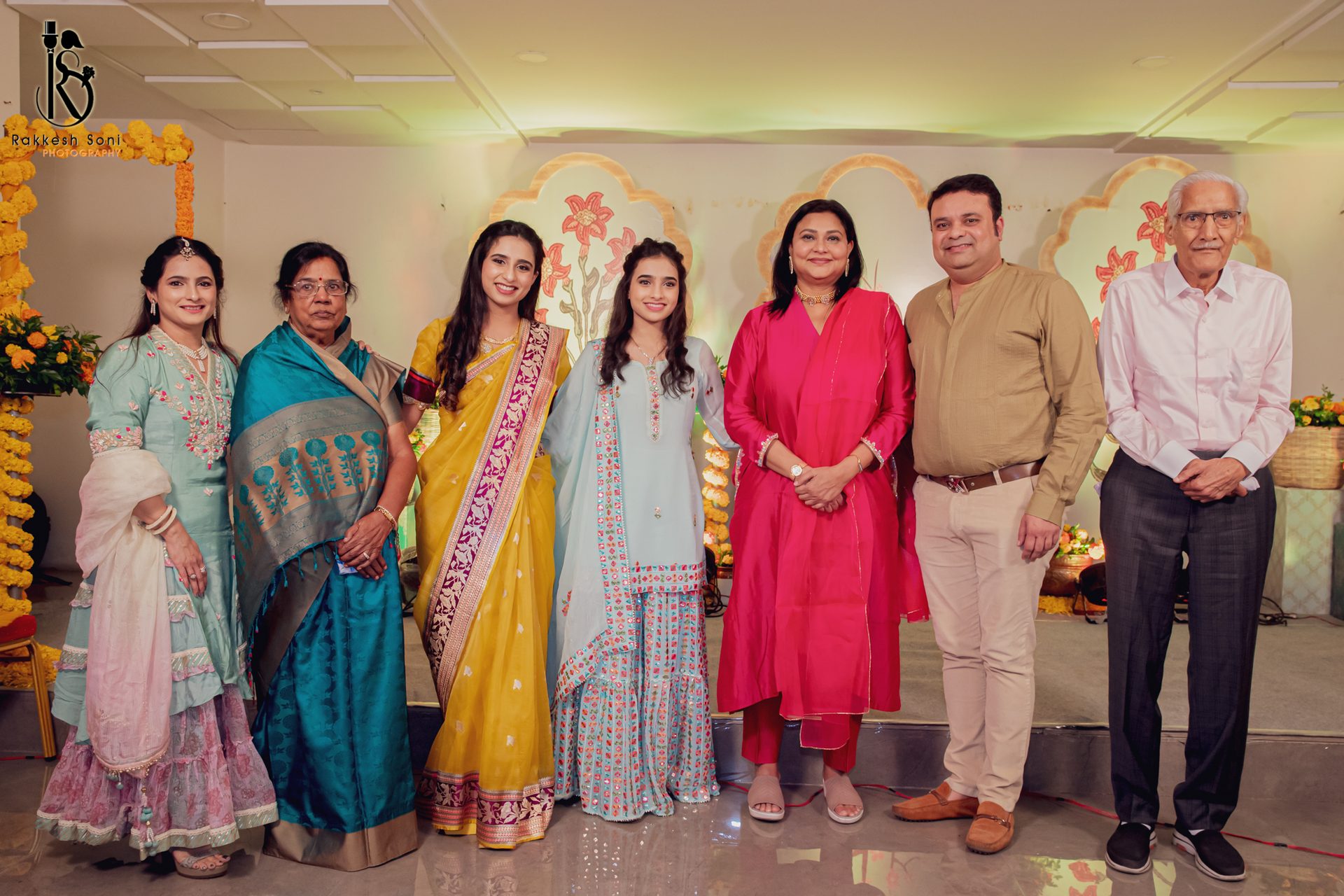
Dr Rama Moondra surrounded by her loving family: her parents, brother, sister-in-law and two adorable nieces.
With a deep bond with her family, including her brother Ritesh, Bhabhi Shruti, and nieces named Nitya and Devanshi, she finds strength and support in their unwavering pride and understanding. Driven by her love for travel, Dr Moondra has set her sights on acquiring 100 passport stamps, already amassing 37 through her global explorations. Her experiences backpacking and working across continents have enriched her perspective, shaping her into the formidable leader she is today.
As the distinguished Dean of the Adani Institute of Digital Technology Management (AIDTM), Dr Moondra brings a wealth of experience and a dynamic vision to her role. Her academic pursuits, including a PGPX from IIM Calcutta, a master’s in Psychotherapy and a PhD in startup economics, reflect her commitment to excellence and innovation.
Dr Moondra’s journey serves as an inspiration, showcasing the power of perseverance and the ability to overcome challenges in pursuit of one’s dreams. As she continues to lead at the forefront of digital technology management education, her story stands as a testament to the transformative power of resilience and determination.
In a candid conversation with a-connect, Dr Rama Moondra shares her experiences, her journey and what keeps her learning and teaching in life.
What has your journey been like with the AIDTM?
In one word, magical. Witnessing the institute’s evolution from its inception to its current stature has been nothing short of phenomenal.
What challenges have you faced in your career, and how have you overcome them?
A significant challenge was inaugurating AIDTM during the peak of the COVID-19 pandemic. Convincing students to enroll in a new course at a young institute with no established placement track record presented a formidable obstacle. While the reputable Adani brand lent credibility, the most effective strategy for surmounting this challenge involved providing personal assurances to each parent. I pledged to be readily available for any concerns or assistance, thereby instilling confidence in both students and parents alike.
Can you discuss a particularly difficult obstacle you encountered and how you navigated through it?
Convincing talented people from outside Gujarat to join a new institute was challenging. However, promising a conducive environment and research freedom helped overcome this obstacle.
Could you share some highlights or pivotal moments in your career at the institute?
A pivotal moment was receiving acknowledgment from Dr Priti Adani, chairperson of the Adani Foundation, during her first visit to the institute which affirmed the efforts invested in the institute. Her recognition motivated me to strive for greater heights.
What makes AIDTM exclusive, in comparison to other educational colleges?
Both Oyo and Taj exemplify successful business models, each catering to distinct segments: mass and class, respectively. Similarly, AIDTM is meticulously crafted for excellence, focusing on personalised attention, holistic development and nurturing future industry-ready professionals from day one. As a testament to this commitment, I and the AIDTM faculty personally engage with each of the 95 students, knowing them by name, understanding their unique traits and tracking their academic progress. Following every term, we provide individual counseling sessions, ensuring comprehensive support and guidance for every student’s journey.
Could you share a memorable success story involving the institute’s alumni, faculty, or any instance that left a lasting impression on you?
I will share a heartening story about one of our students, Rohit Varma. Hailing from a farmer’s family in a small village, Rohit initially grappled with nervousness and lacked confidence in public speaking during his first year. However, during his summer internship, under the guidance of the Adani Group’s CTO Sudipta Bhattacharya, he exhibited remarkable improvement. This progress culminated in an opportunity to present in front of our Chairman Gautam Adani. I vividly recall Rohit’s apprehension when he called me at 9:30 pm, only to later jubilantly report at 11:00 pm that his presentation had gone exceptionally well. Such moments truly warm the heart. Today, Rohit proudly serves as an employee of the Adani Group—a testament to the transformative impact we have had, not just on individuals, but on entire families.

With Dr Priti Adani during her inaugural visit to AIDTM.
Is there a specific accomplishment or achievement that you are particularly proud of during your tenure?
We have successfully expanded the institute threefold within a span of three years. What began with 20 students in the inaugural year has now grown to accommodate 95 students on campus. With a full capacity of 240 students, a milestone we aim to achieve within the next two years, our journey of growth is truly remarkable. I take great pride in the meticulous attention to detail and pursuit of excellence that have become hallmarks of our institute. This commitment to quality has garnered praise from numerous seniors within the Adani Group as well as external visitors, reaffirming our dedication to setting and maintaining high standards in everything we do.
How do you foster collaboration and innovation within your team?
Innovation is deeply ingrained in our culture, thanks to the strong meticulous Head of Operations, Ritesh Soni, and esteemed faculty member Professor Dr Ankit Shah. Our faculty engages in extensive research, benchmarking against other academic institutions and staying abreast of global trends. Drawing from diverse perspectives, we tailor our initiatives to suit the unique needs of our institute. Collaboration is fostered through a range of engaging activities, including fun events such as team fashion shows and culinary fests, which promote camaraderie and creativity among our staff.
How do you keep your team’s morale high, especially during challenging times?
Being associated with the prestigious Adani brand serves as a significant source of motivation for our team. However, during quieter moments, I encourage our staff to envision their potential and explore avenues for personal and professional growth. At AIDTM, we are committed to designing a clear path for the future development of every employee, ensuring that they feel valued and supported in their journey towards success.
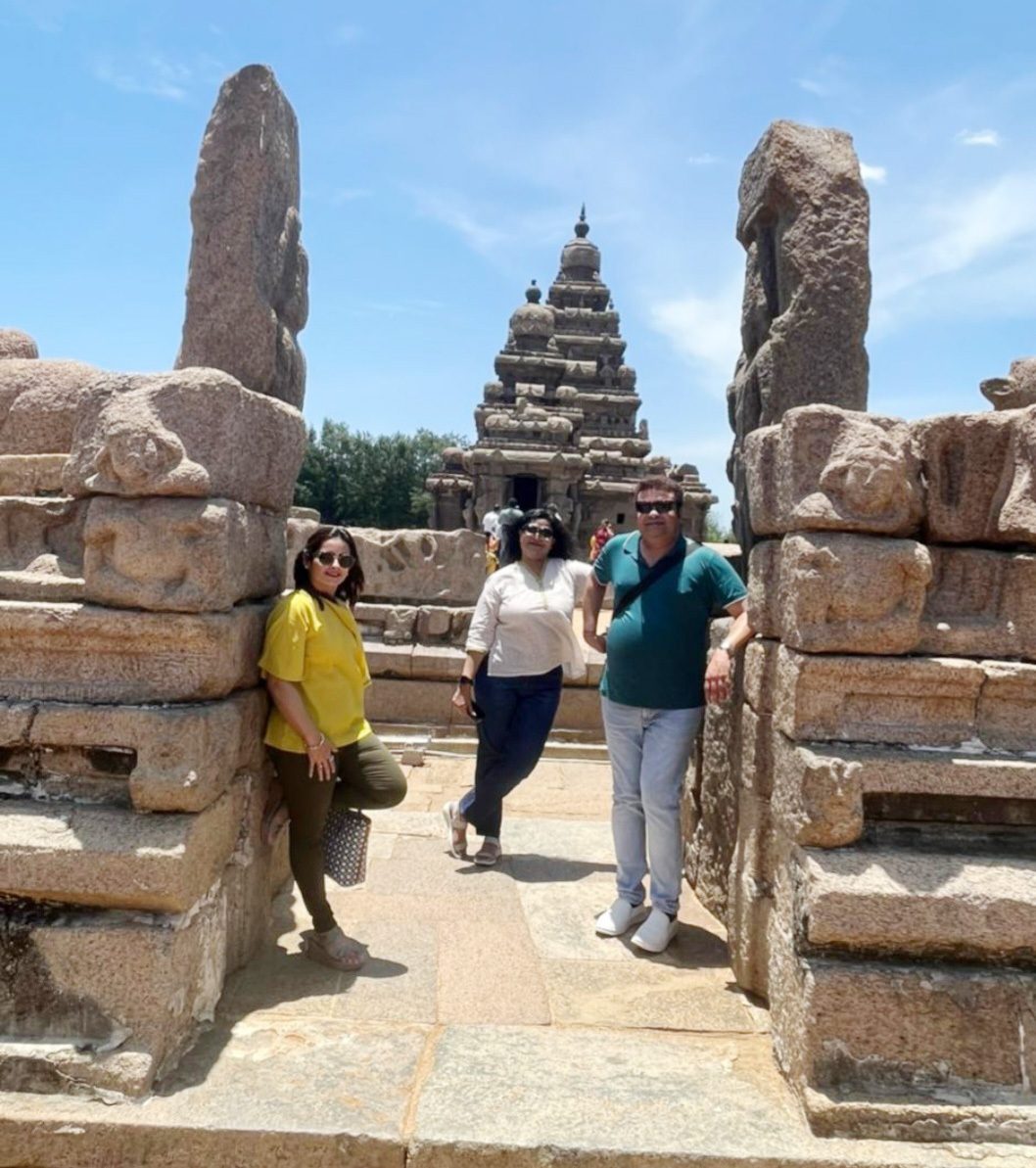
Vacationing with brother, Ritesh Toshniwal and his wife, Shruti Toshniwal.
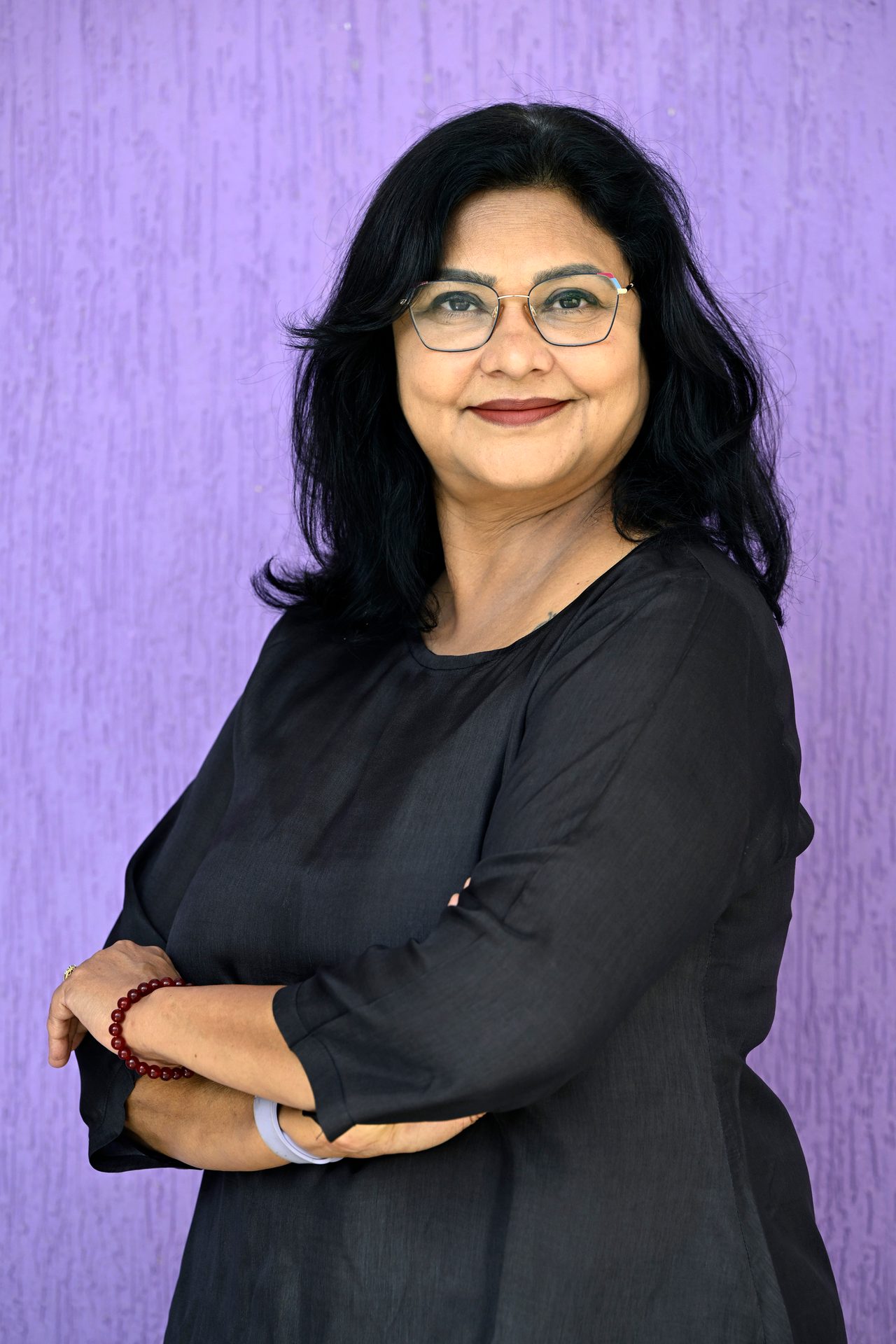
“Always prioritise your professionalism above all else, regardless of your gender. Our struggles and achievements as professionals run deep and should be acknowledged as such.”
What motivates and drives you to work passionately every day?
The opportunity to make a profound difference in the lives of our students and to leave a lasting legacy drives my passion. The ability to add value to the institute daily and witness the growth of our students and faculty are the most motivating aspects of my role.
What strategies or initiatives do you implement to support your team’s well-being and motivation?
We organise various activities such as theatre, sports events and meditation camps to promote employee well-being. However, at AIDTM, we prioritise work-life balance and ensure that every staff member has ample time to spend with their families. This commitment to fostering a healthy balance between work and personal life is a cornerstone of our approach.
What aspect of your role brings you the most satisfaction and fulfillment?
When Dr Malay Mahadevia approached me to spearhead the establishment of this institute, I was initially apprehensive. Despite my extensive involvement with esteemed institutions such as IIM A, IIM Raipur and IIM Shillong, I lacked prior experience in building an academic institute. Coming from a background in core consulting, I expressed my reservations to Dr Mahadevia. However, he reassured me with a smile, highlighting that my fresh perspective and absence of preconceived notions were precisely why I was chosen for the role. The journey of building AIDTM from scratch and witnessing its daily growth has been immensely gratifying, serving as the greatest source of satisfaction and fulfillment in my career.
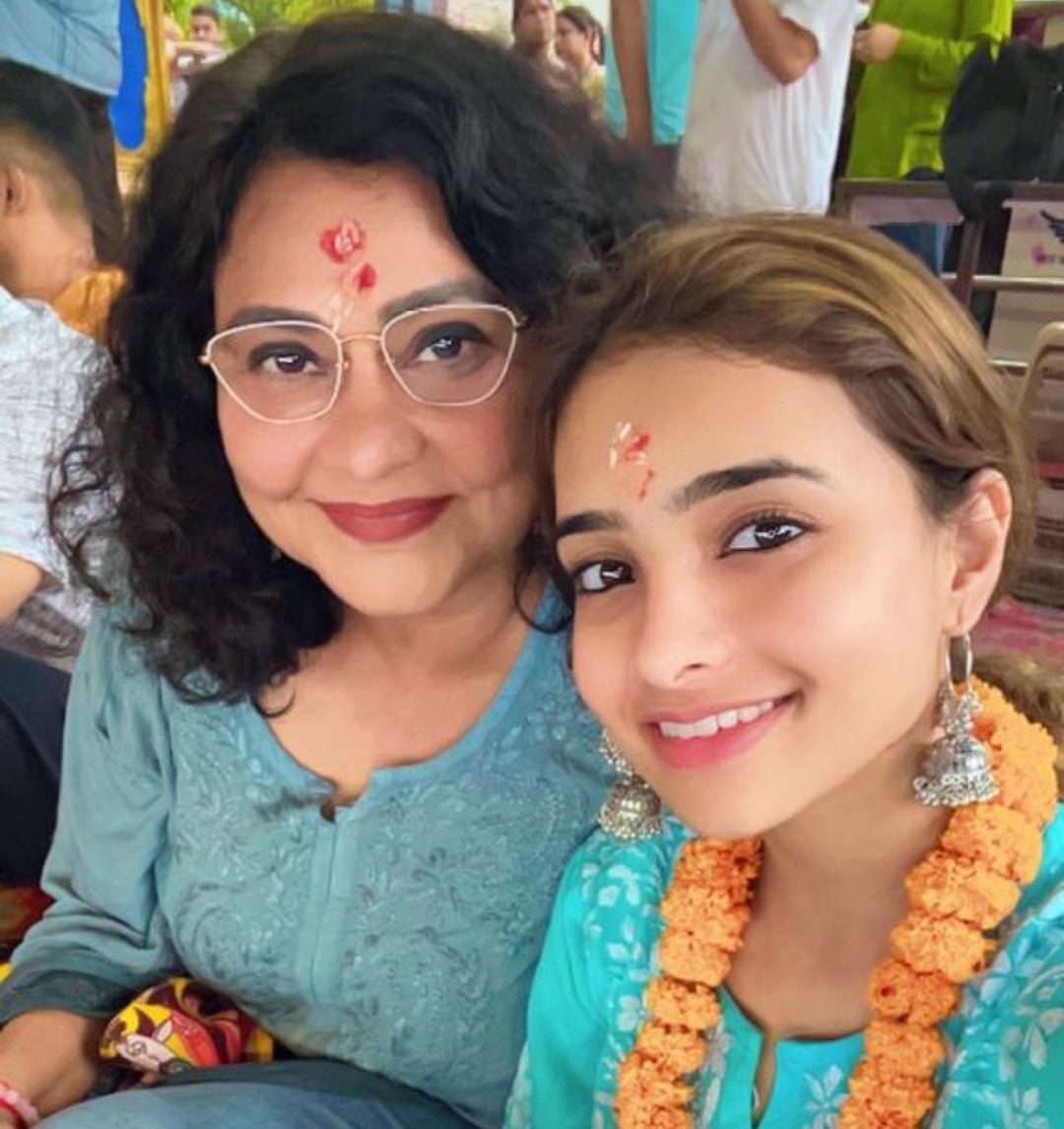
Attending the Ganga Aarti with Devanshi in Rishikesh.
Any career tips you could share for your younger colleagues, especially women aspiring to leadership roles?
The initial step is to refrain from engaging in gossip, which can be detrimental to professional relationships. Secondly, it is essential not to squander valuable time at work; instead, focus on tasks that contribute to personal and organisational growth. Lastly, taking ownership of one’s responsibilities and seizing every opportunity for additional tasks is paramount. By embracing a proactive approach, continuously learning and embracing challenges, one can ascend to greater heights professionally.
What advice would you give to women who aspire to break into leadership positions in academia or other male-dominated fields?
Stay abreast of not only academic research but also the latest industry trends to remain relevant and competitive. Foster connections by networking with peers and industry professionals. Show appreciation to your colleagues and provide equal opportunities for growth. It is crucial to recognise that men may not always respond to sentiments in the same way women do; therefore, adapt your communication style accordingly when interacting with male colleagues. Keeping this in mind fosters effective collaboration and communication within the workplace
You are a role model for many women. Please share a message for other aspiring women.
Always prioritise your professionalism above all else, regardless of your gender. Our struggles and achievements as professionals run deep and should be acknowledged as such. While men may respect strong women, they may also find them challenging to engage with. Therefore, strive to cultivate a friendly and collaborative atmosphere while maintaining discipline and professionalism as guiding principles. Remember, talent is admired, but it is one’s character that truly defines their worth in the world.
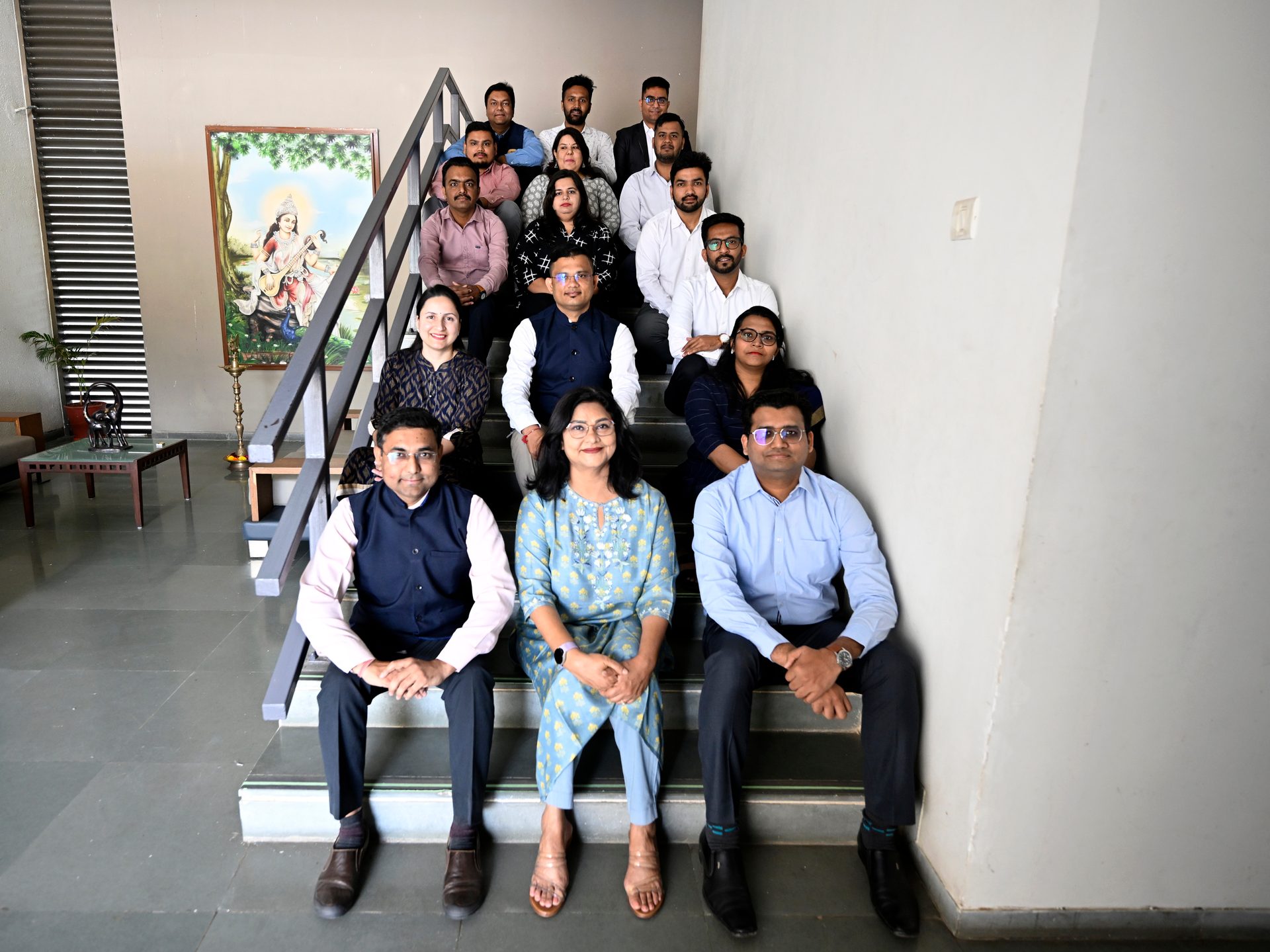
Dr Moondra with the core team at AIDTM.
- Your typical daily schedule?
I rise at 5 am, engage in a morning workout, prepare for the day, and commence work at 9 am until the day’s tasks are completed.
- What do you enjoy doing in your spare time?
I am blissfully single and relish spending time immersed in books, occasionally socialising with friends, and maintaining regular communication with my family in Hyderabad.
- Hobbies that help you unwind and relax?
Swimming and indulging in Sci-Fi entertainment are my go-to activities for relaxation.
- Food that uplifts your mood?
Hot steaming idli and also rasgulla.
- Favourite local restaurant?
TG’s – The Oriental Grill.
- All-time favourite movie?
“The Shawshank Redemption” remains an enduring favourite for its profound storytelling and timeless themes.
- Book that has inspired you the most?
“The Buddha and The Badass” by Vishen Lakhiani.
- Any message or advice for the readers?
Remember to prioritise upgrading your digital skills, and rest assured, we are here to support you every step of the way. ●
Quick Talk

Cargo Efficiency Ahoy!
Newsmakers
Adani Ports & Special Economic Zone
APSEZ’s Mundra Port hits historic highs.
Jaydeep Shah
I
n the bustling world of maritime trade and logistics, Adani Ports & Special Economic Zone Ltd (APSEZ) has emerged as a beacon of excellence. Recently, APSEZ achieved a remarkable milestone at its Mundra Port facility, underscoring its dominance in the industry and setting new standards for efficiency and innovation. Here we delve deeper into this extraordinary feat and explore the journey of APSEZ towards success.
APSEZ is India's largest integrated transport utility, playing a pivotal role in facilitating maritime trade and logistics across the nation. Renowned for operational excellence and a staunch commitment to sustainability, APSEZ operates cutting-edge port facilities that exemplify its dedication to advancement. Among these facilities, Mundra Port shines as a beacon of APSEZ's capabilities and unwavering commitment to progress.
In a momentous feat, Adani Ports, Mundra, surpassed the significant cargo handling milestone of 155 million metric tons (MMT) in Feb 2024. What sets this achievement apart is the remarkable timeframe within which it was accomplished – a mere 326 days, showcasing exceptional efficiency and agility in cargo handling operations. This milestone not only solidifies Mundra Port's position as a premier port facility in India but also highlights APSEZ's steadfast dedication to excellence.
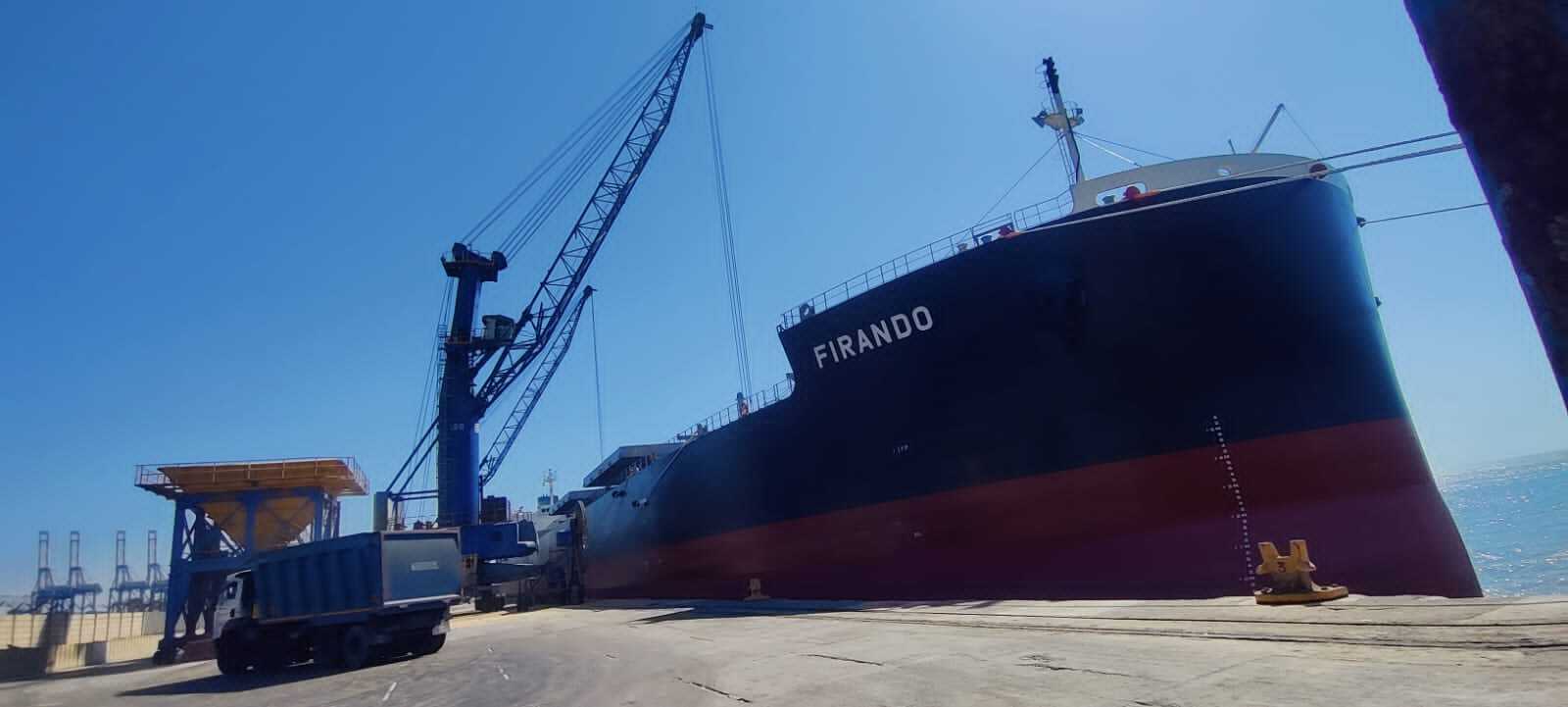

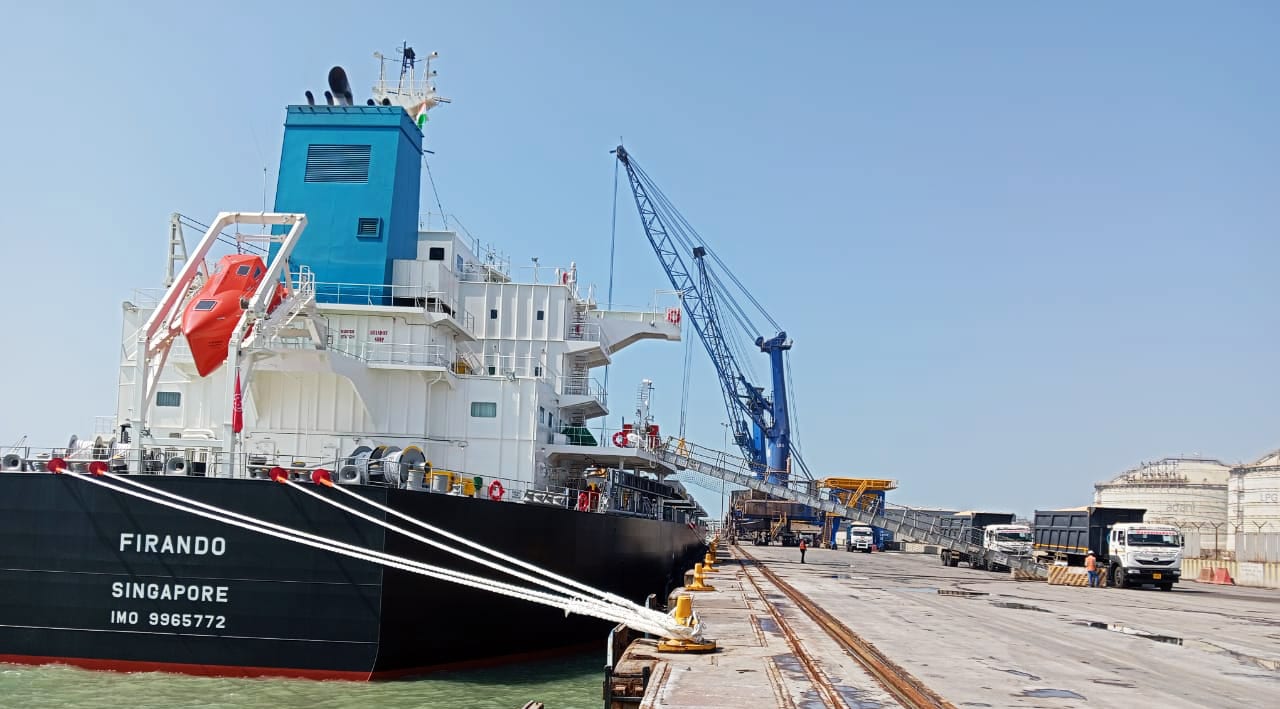



Adding to its accolades, Mundra Port also set a record-breaking dry cargo shipment during this period. The vessel MV Firando arrived at Adani Ports, Mundra, laden with an astounding cargo load of 77,000 metric tons. This surpasses the port's previous record of handling 70,365 metric tons, further demonstrating Mundra Port's capability to handle diverse cargo types efficiently and effectively.
Behind these remarkable achievements lies the dedication and proficiency of the Mundra Port’s operation team. Their expertise in managing complex logistics operations has been instrumental in propelling Mundra Port to new heights of success. Moreover, APSEZ's unwavering focus on innovation, sustainability and technological advancement has been pivotal in shaping the future of India's port infrastructure and global trade connectivity.
The story of Adani Ports' historic milestone at Mundra Port is not just about surpassing numbers; it is a testament to the company's unwavering commitment to excellence and innovation in the maritime and logistics sector. As APSEZ continues to sail towards greater heights, its achievements serve as inspiration for the entire industry, reaffirming its position as a leader in shaping the future of maritime trade in India and beyond.
●
reflections
Anchored In History
Abbot Point Operations celebrates 40 years of safe ship loading at NQXT.
Andrew Strutton
A
bbot Point Operations (APO) is celebrating four decades of safe and responsible operations at the North Queensland Export Terminal, Australia’s most northern deepwater export port.
It was in the last week of Feb in 1984 when the Fukukawa Maru arrived at the Terminal, located north of Bowen in Queensland, to load 60,000 tonnes of coking coal from the Collinsville mine, destined for Hong Kong.
The BBG Liuzhou was the 6,902nd ship to safely berth at the Terminal and load high-quality coal from Bowen or Galilee basin mines for export to the world.
Abbot Point Operations General Manager Port Operations Allan Brown said the milestone was a credit to the hundreds of local workers who had maintained the Terminal for more than a generation.
To celebrate, the 400-strong APO team held a special morning tea, complete with themed cake, and gave out APO gift packs to train drivers and mariners visiting the Terminal.
“Our people are our business, and they are the foundation of 40 years of dedicated best practice in operating and maintaining this critical piece of national infrastructure,” Mr Brown said.
“From the production crew to the pilots, the tradespeople to the train drivers, and the engineers to the enviros, each member of our dedicated team has played a vital role in shaping the success story of the North Queensland Export Terminal.
“We’re proud of our role in helping transport high-quality Queensland metallurgical and thermal coal to the world where it advances development and provides affordable and reliable energy that lifts people out of poverty.
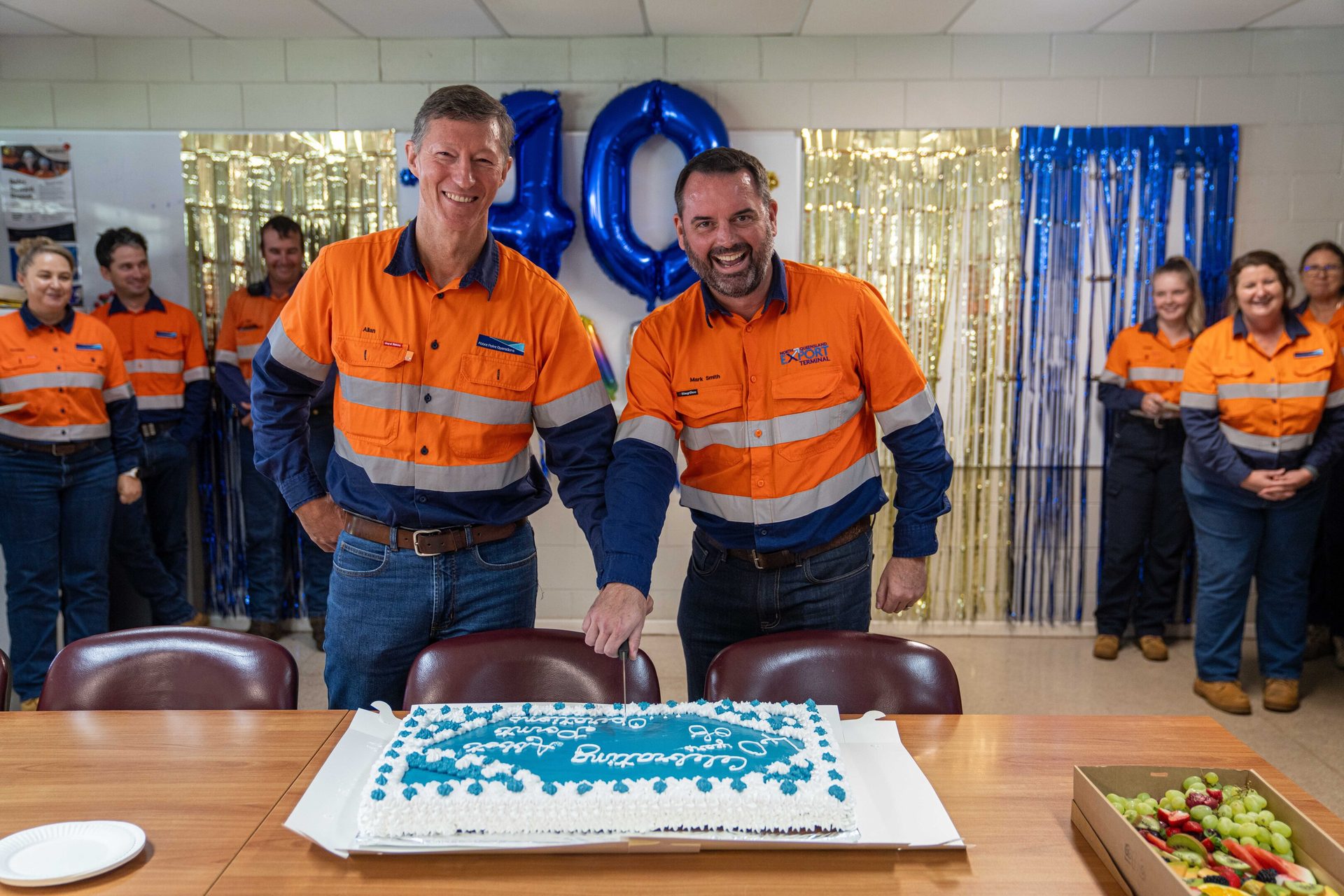
APO General Manager Port Operations Allan Brown and NQXT General Manager Mark Smith cut the 40th anniversary cake.
“And as Bowen locals we are equally proud of our efforts to ‘Grow Local’ and provide jobs, training, and corporate giving that contribute to the economic and social fabric of our community.
“It’s been wonderful to come together as a team to celebrate this milestone, reflect on the journey so far, as well as chart a course for the next 40 years.”
APO manages world-class water monitoring, marine sediment, air quality, pests and weeds, and workplace safety programs at the Terminal. The business also partners with North Queensland Bulk Ports and First Nations traditional owner business, Juru Enterprises Ltd, to deliver initiatives like the Collaborative Turtle Monitoring Program.
The business has a more than 30-year training tradition in educating apprentices to maintain a future workforce, as well as build skills locally, and APO’s Community Support Program provides more than AUD 300,000 a year in donations and partnerships to eligible community groups, organisations, and initiatives in the Whitsunday Regional Council communities of Bowen and Collinsville.
The North Queensland Export Terminal (NQXT), then called the Abbot Point Coal Terminal, opened in 1984 with an annual export capacity of 6.5 million tonnes per year. The Terminal was built in partnership between Mount Isa Mines and the Harbours Corporation of Queensland to open export access for coal producers in the Bowen Basin*.
Today, the NQXT has a nameplate capacity of 50 million tonnes per year following upgrades over the Queensland Government undertook over the years, and services mines in both the Bowen and Galilee basins.
Bravus** took stewardship of NQXT in 2011 after acquiring a 99-year lease over the Terminal and its supporting infrastructure from the Queensland Government for $1.8 billion.
In 2016, the Queensland Government declared the Port of Abbot Point, which the Terminal is located within, a Strategic Port, noting its role as an essential element of national and state transport networks and supply chains.
The same year, Bravus acquired APO and the operating rights for the Terminal. ●
*For more on the history of the Terminal visit: https://nla.gov.au/nla.obj-306078823/view?partId=nla.obj-306162987#page/n13/mode/1up
**Then Adani Australia
“Will build on your vision to transform Madhya Pradesh into India’s ‘Mukhya Pradesh’.”
conclave
Mr Pranav Adani’s address at the Regional Industry Conclave 2024 in Ujjain, Madhya Pradesh on 1 Mar 2024 in the presence of Chief Minister of Madhya Pradesh, Dr Mohan Yadav, Minister of MSME, Government of Madhya Pradesh, Mr Chetanya Kasyap and many other distinguished leaders.
आज के इस गरिमामय और महत्वपूर्ण आयोजन के अवसर पर मैं सर्वप्रथम प्रदेश के ऊर्जावान माननीय मुख्यमंत्री डा. मोहन यादव जी, आपका और आपकी टीम का दिल से धन्यवाद देना चाहता हूं। आपने हम सबको देवों के देव भगवान महाकाल की धरती पर आने का सुखद अवसर, इस इनवेस्टर समिट के माध्यम से प्रदान किया है। मैं चाहूंगा कि एक बार आप सभी जोरदार तालियों से माननीय मुख्यमंत्री जी का अभिनंदन करें। मैं उज्जैनकी देवभूमि को प्रणाम करता हूं। भगवान कृष्ण के द्वारा पांच हजार साल पहले दिया गया गीता का ज्ञान, आज भी हम सबका मार्गदर्शन कर रहा है। भगवान कृष्ण ने भी अपनी शिक्षा इसी उज्जैन कें सांदिपनी आश्रम में आकर ग्रहण की थी। मध्यप्रदेश देश का ह्दय है और मुझे यह कहने में कोई हिचक नहीं है कि आने वाला समय, मध्यप्रदेश का है। हमारे यशस्वी प्रधानमंत्री नरेंद्र मोदी जी इस राष्ट्र को परम वैभव के शिखर पर ले जाने के लिए मेहनत कर रहें हैं।यह साफ दिखाई दे रहा है कि इस संकल्प को पूरा करने के लिए डा. मोहन यादव जी के नेतृत्व में मध्यप्रदेश महत्वपूर्ण भूमिका निभायेगा।
Hon’ble Chief Minister,
I am excited to share the confidence of our nation’s business community that you will enable more growth and prosperity for Madhya Pradesh than ever before. And assembled here today are the some of our nation’s brightest business minds – the team that will build on your vision to transform Madhya Pradesh into India’s ‘Mukhya Pradesh’.
Looking at the range of supportive multi-sectoral policies, schemes and reforms that your government is now pushing forward, it is clear that the infinite potential of Madhya Pradesh is rapidly emerging into the light.
I see infinite possibilities for infinite growth – especially in energy and infrastructure – and the Adani Group is excited about investing in Madhya Pradesh.
Currently, our presence in Madhya Pradesh spans a wide range of sectors – from roads, cement and natural resources to thermal power, renewable energy and power transmission. Our cumulative investment in the state amounts to almost INR 18,000 crore – and we have created almost 11,000 employment opportunities across the state.
I am delighted to announce that not only will the Adani Group continue investing in these diverse sectors but we will also more than double our investment in Madhya Pradesh, and contribute in our own humble way to the state’s all-round development.
Our faith in your visionary leadership will see us investing close to INR 75,000 crore in Madhya Pradesh.
Of this, INR 5,000 crore will be utilised to build the Mahakaal Expressway from this great city Ujjain, to Bhopal, through Indore.
We will also invest another INR 5,000 crore to set up a 4-million-tons-per-annum clinker unit in Chorgadi and two cement grinding units, in Dewas and Bhopal, with a combined capacity of 8-million-tons-per-annum.
In the natural resources sector, we will invest over INR 4,000 crore – and another INR 600 crore to expand our presence in food processing, logistics and agri-logistics, and defence manufacturing.
Our investment in fuel distribution, which includes CGD, LNG, EV and BIO, will exceed INR 2,100 crore, the bulk of which will be used to strengthen our city gas distribution network in 5 geographical areas: Bhind, Burhanpur, Anuppur, Tikamgarh and Alirajpur.
The Adani Group’s biggest investment will be in enhancing your state’s access to plentiful, reliable and affordable power. We will invest close to INR 30,000 crore to ramp up the power generation capacity, at our Mahan Energen plant in Singrauli, from its current 1,200 megawatts to a massive 4,400 megawatts. We will also invest close to INR 28,000 crore to set up 3410 MW capacity Pumped Storage Projects.
In all, our total planned investment of nearly INR 75,000 crore will generate over 15,000 direct and indirect employment opportunities in a wide variety of industrial sectors across Madhya Pradesh.
The vision of our Honourable Prime Minister Narendra Modi-ji is reflected in your ambitious growth and development plans for Madhya Pradesh.
I believe I speak for everyone present here today that, under your decisive and inspiring leadership, this state will accelerate faster than ever before on its mission of transformation, industrial development and prosperity-for-all.
The Adani Group is privileged to be a part of this incredible journey you are leading.
Thank you.
Jai Hind. ●
From Personal Loss To Collective Hope
awareness
An intimate window into the world of Parkinson’s Disease.
Dr Vonita Singh
I
n 2003, Papa uttered the poignant words, “My body is not listening to me, beta.” For years prior, we sensed something was amiss, but could not understand what. Upon receiving the diagnosis of Parkinsonism, we thought we had reached a turning point, but little did we know, the battle had just begun. From the onset until his passing in 2009, life was a rollercoaster of dealing with the unexpected, with little body of knowledge readily available on how to deal with it.
Reflecting on Papa’s journey, I could not shake the question: What could we have done differently to support him better? Regrettably, our lack of understanding and mismanagement of symptoms meant that, despite our best intentions, we could not provide the optimal care. This realisation haunted me, driving home the importance of awareness and education in dealing with Parkinson’s Disease (PD).
PD is a neurodegenerative and progressive condition. Its symptoms are a combination of ‘Motor’ (tremors, shuffling gait, rigidity, balance etc.) and ‘Non-motor’ (constipation, incontinence, depression, sleep issues etc.) challenges. Interestingly, no two cases are the same. Each journey is unique in terms of its manifestation and pace of progression. Michael J. Fox’s words resonate deeply here: “We may each have our own individual Parkinson’s, but we all share one thing in common. Hope.”
In Papa’s case, the symptoms were varied and debilitating, yet our knowledge gaps led to suboptimal care. Sadly, this pattern is all too common among PD patients and caregivers, resulting in rapid deterioration that could have been slowed with proper intervention and medication.
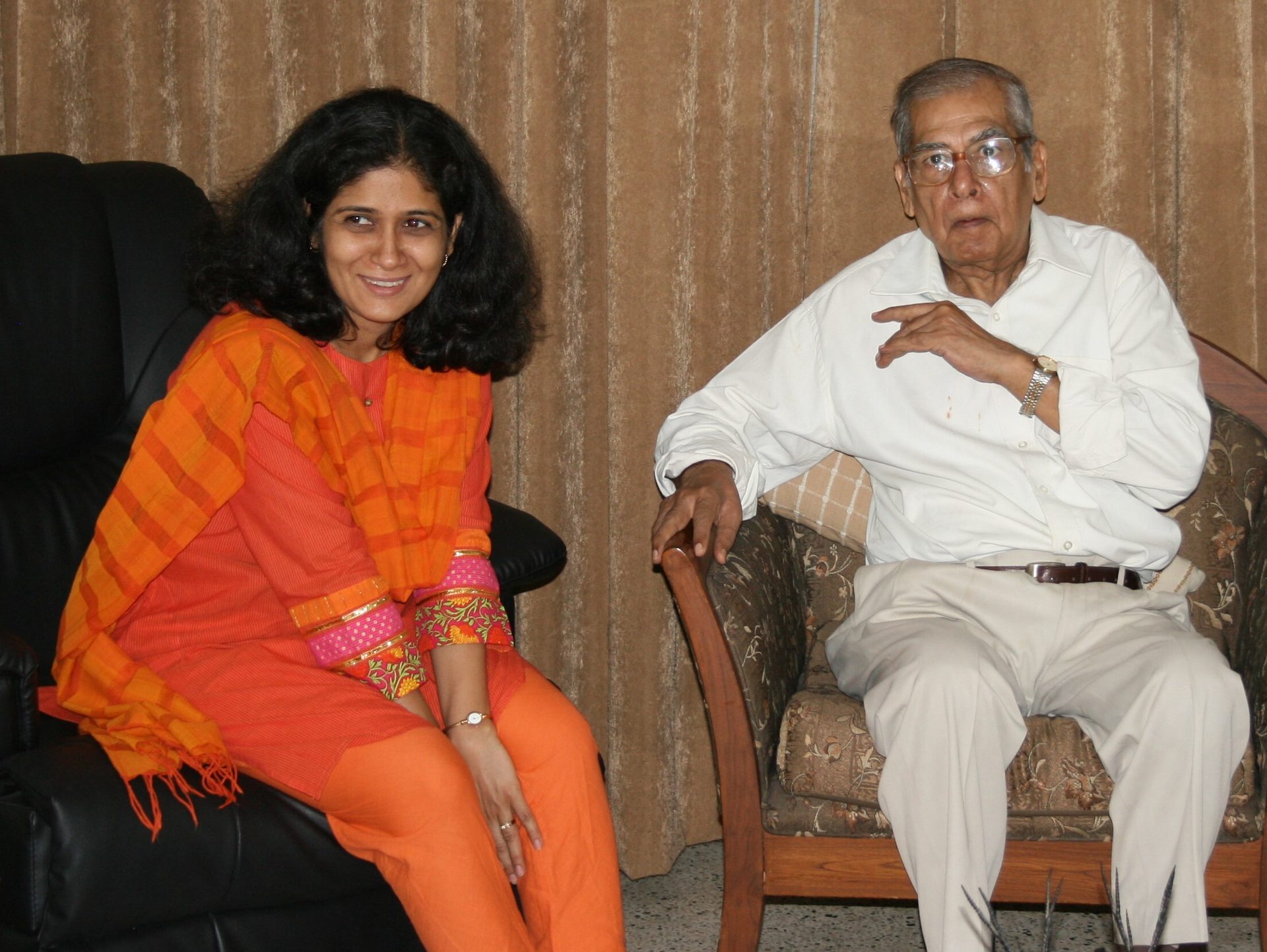
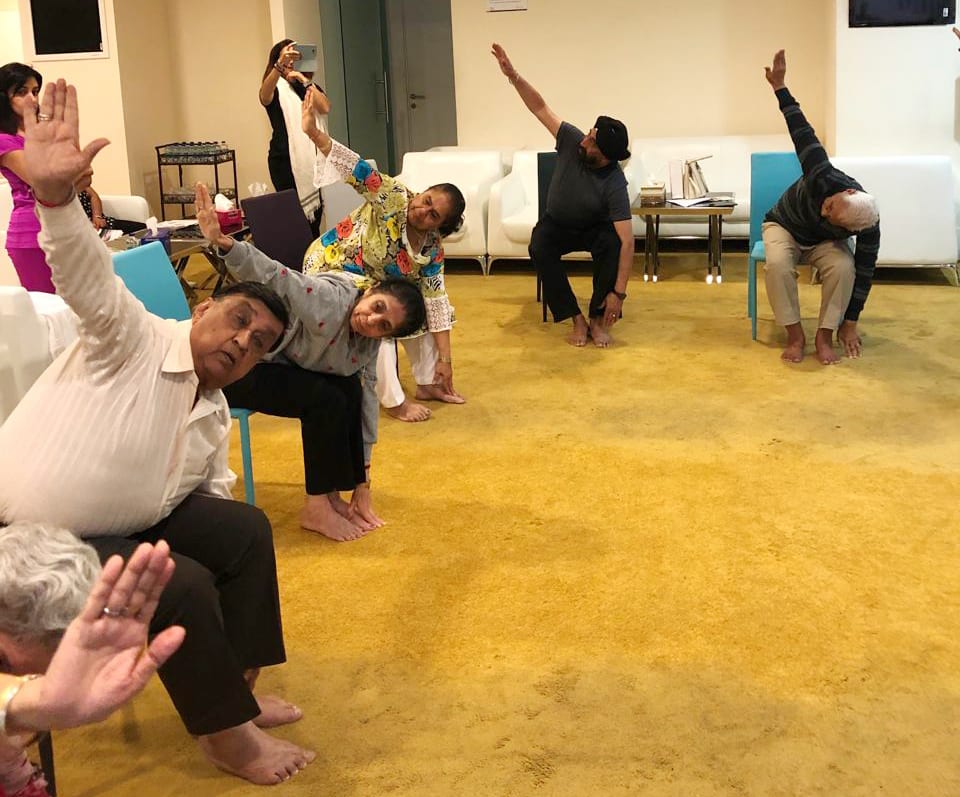
Witnessing Papa’s gradual loss of independence and functionality was heart-wrenching. PD strips away mobility and autonomy, leaving the individual trapped in a body that no longer obeys their commands.
PD is the second most prevalent neuro degenerative disorder globally with leading medical journal, Lancet, calling it the next avoidable pandemic. The numbers are frightening – India is expected to see 2 to 3x rise in cases by 2050 (The Times of India, 11 Apr 2022). When one overlays on top of this data, the relative lack of awareness amongst the population of the progression and management of this phantom, the urgency in increasing awareness amongst patients, care givers and the general population is clearly established.
When Papa’s bank cheques started to bounce, we were all surprised and wondered why it was happening. Today, we understand that Micrographia (small, cramped handwriting) is part and parcel of the PD spectrum. Looking back and with my current day to day experiences with the PD community, it is seen that non-motor symptoms gravely impact those affected and most times, more than them, the families and loved ones. We do not easily talk and share these challenges, which often leads to mis-diagnosis or a delay in diagnosis.
The stress of caring for Papa took its toll on Ma who passed on to cancer in 2008, just a year before Papa. Their absence left a void that propelled me into action. Drawing upon my background in Kathak dance and anthropology, I recognised the therapeutic potential of movement in PD management. I instinctively felt that Indian dance has such profound wisdom built into it – the mudras, footwork, bhavas and storytelling – all blend in an amazing kaleidoscope that provide a physiotherapy like intervention at a different level altogether. This realisation led me to train with the Dance for PDTM institute in Brooklyn, New York.
Empowered by my training and my own conviction, I founded a social enterprise – Movement Mantra in Dubai (we were posted there then), in 2013. In addition to the therapeutic physical impact that our mindful movements had on members, it was humbling to see how this helped them at social and emotional levels too. The journey from 2013, with one PD hero, till date has been challenging and gratifying. Through this time, I have had the privilege of working hand in hand with over 200 PD heroes, their families, medical fraternity, corporates and many other stakeholders.
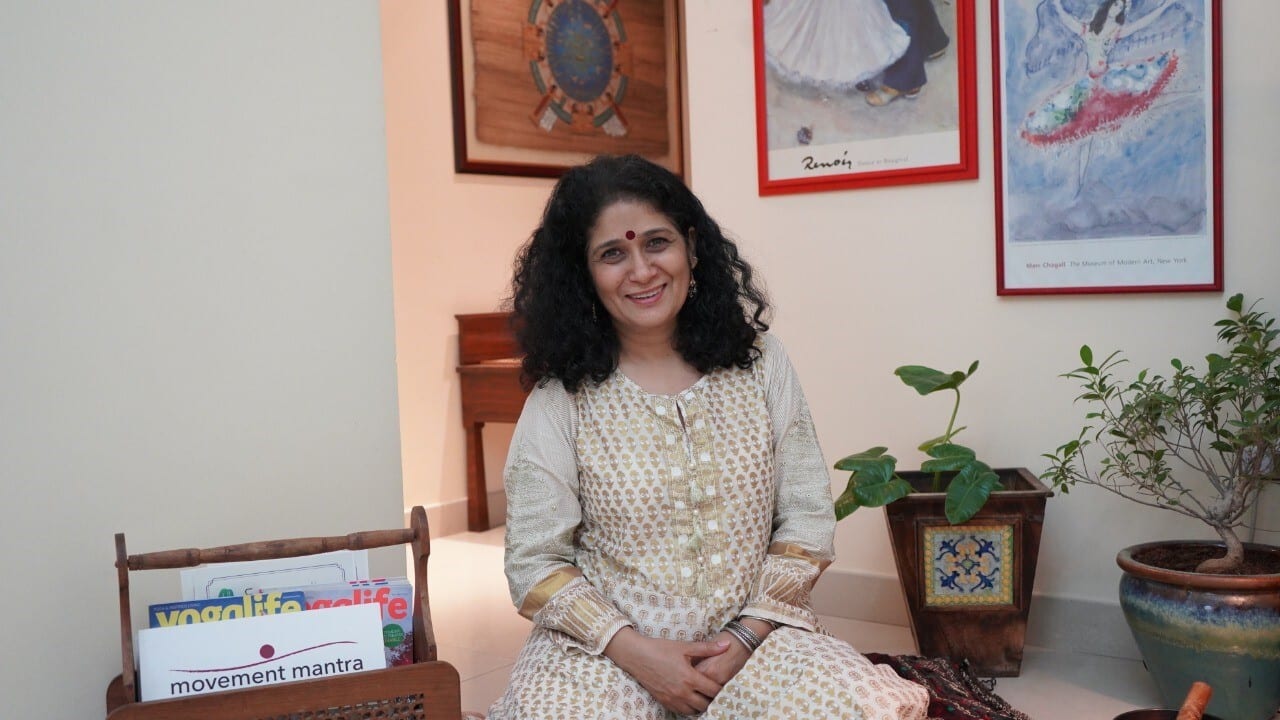
Drawing upon my background in Kathak dance and anthropology, I recognised the therapeutic potential of movement in Parkinson’s Disease management.”
Whilst Movement Mantra became a safe, comfortable zone for all those afflicted by the condition, there is this gaping gap in awareness levels in the larger community. Acceptance of the diagnosis becomes more challenging when the society around us is not aware and does not talk about it. There still exists a social stigma to such conditions.
With the aim of unmasking this ‘Mask Faced Syndrome’ (as PD is often referred to), I have produced a theatre piece, called ‘Still Dancing’ which is a thought-provoking amalgamation of music, dance and drama, showcasing the realities of living with PD. Written and directed by Sanjeev Dixit, founder of Third Half Theatre, this play was staged in 2019 and restaged in 2023 – both in Dubai.
This original production is dancing its way into India and shall be premiered in Mumbai on World Parkinson’s Day, 11 Apr at the NCPA, followed by Royal Opera House on 13 Apr. We also have two shows in Ahmedabad at The Forum Club 07, on 19-20 Apr. We invite you to experience “Still Dancing” and stand with us in solidarity on this journey. ●
The writer is the founder of Movement Mantra. Dr Singh started it with an aim to help spread awareness and support people with PD through movement. She and her social enterprise have been the recipient of several citations and an award-winning documentary on her work was released in 2017. She can be reached at vonita.movementmantra@gmail.com
Fitness Made Simpler
wellness
Set yourself up for success - To do this think about planning a healthy diet in the form of few small, manageable steps rather than one drastic change.
Simplify - Instead of being overly concerned about counting calories or measuring portions think in terms of colour, variety and freshness.
Start Slow - Trying to make your diet healthy overnight is not realistic. Make minor changes like switching from butter to olive oil, chips to nuts, burgers to salads and so on. Do not eliminate foods at one go, reduce the intake.
Eat in moderation - We all need to have a balance of carbohydrates, proteins, fats, vitamins and minerals to sustain a healthy body, each has a particular function in the body. All of us are used to having three heavy meals a day - breakfast, lunch and dinner. This is the easiest way to ensure fat loss, as digestion itself is a calorie burning activity. While you may not be able to see the furious digestive activity going on at any point of time, the body is working hard. In fact, it is the internal workout. The key here is what and how much to eat. Use smaller bowls and spoons to eat, as this helps you to eat in moderation. Make the portion size smaller
It is not just what you eat but how you eat - Healthy eating is much more than the food on your plate - whatever you eat, consider it as a source of nourishment for the soul as well as the mind rather than just gulping it down the system. Eat with peace along with others whenever possible, it has social and emotional benefits. Listen to your body - eat when you are hungry, do not mix thirst with hunger. Take time to chew, enjoy the flavours by chewing well for better absorption.
Have a blast at breakfast - It is really the most important meal of the day! It refuels your glycogen stores and kick starts the metabolism. The right breakfast foods can help you concentrate, give strength and even help you maintain a healthy weight. Breakfast gives you a chance to get a good dose of vitamins and nutrients from healthy foods like dairy, grains, eggs and fruits. Have a good combination of proteins and carbohydrates; include oats, porridge (homemade), omelettes, paushtik parathas, whole grain toasts with avocado & vegetable spreads, upma, poha, idli, whole fresh fruit, buttermilk and so on. Avoid juices. Add dates and nuts to your cereals or munch it after the breakfast to get the natural sugar and iron for the day. If your body does not get the fuel from food in the morning, you may feel zapped of energy, and you will overeat later in the day.
Be a fan of vegetables and fruits - Fill up on colourful vegetables. Eat less sugary fruits. Try to have a rainbow diet, the brighter and the darker the better. Prefer vegetables, as they are low in calories packed with antioxidants and fibre. Remember to eat the seasonal ones as they are fresh.
- Eat greens - peas, beans, broccoli, spinach, methi, lettuce, cucumber.
- Eat sweet vegetables - beetroot, sweet potato, carrots to reduce sweet cravings.
- Boost up your immune system by eating apples, guava, papaya, mango, berries, cherries, oranges, bananas, watermelon and several types of melons.
Enjoy healthy fats - Eating nuts & seeds which include almonds, walnuts, cashew, pistachios, flax seeds, pumpkin seeds, sunflower seeds are a fantastic way to add good fat in our diet. All these provide omega three fatty acids, vitamin E, calcium, iron, potassium, and a whole lot of antioxidants to us. It is believed nut eaters live longer and have a low incidence of cancer & cardiovascular diseases. Do not let concerns about gaining weight prevent you from enjoying the health benefits of nuts! Use in salads, dessert, cereals and so on. Eliminate processed foods and trans-fat from the diet. Use ghee, coconut oil, butter, olive oil. It is important to add pure ghee to diet as it provides the medium for absorption of fat-soluble vitamins A, D, E & K.
Balance your food choices over time - Not every meal has to be perfect, when eating food high in fats, salt, and sugar, select other foods which are low in these ingredients or balance it the other day. Your food choices over several days should fit together into a healthy pattern. Do become your own food guru and remember the mantra – Eat mindfully not mindlessly. Remember foods are not good or bad, we need to understand our body, lifestyle and then go for it.
Add more proteins to your plate - They are the building blocks of our body; needed as we grow in age for the repair of worn-out tissues. Proteins along with calcium & magnesium provide strength to the bones; improve the alertness of the mind by increasing body’s dopamine levels. Hence a protein rich breakfast is essential to start the day. Go for dairy, eggs, lentils, soya and chicken preparations. Try having a bowl of sprouts as a mid-afternoon snack; it fills up the stomach along with the additional advantage of providing the body with superior quality proteins, vitamins and minerals.

Health is a journey not a mission, we need to adopt it as a lifestyle in our routine, the fitter we are the better we feel.”
Go for the grains -Eating whole grains and millets is an effortless way to add a layer of health insurance to your life but in moderation. Whole grains are packed with protein, fibre, B vitamins, antioxidants and whole lot of trace minerals. A diet rich in whole grains has shown to reduce the risk of heart disease, type 2 diabetes and obesity. They also improve bowel health by helping to maintain regular bowel movements and promote growth of healthy bacteria in the colon. Believe in eating home preparations rather than readymade muesli or flakes loaded with sugar and fats. Go for fresh wholesome foods and make changes gradually. Do not overboard your body by eating rice and chapattis together, be wise in choosing.
Water and lots of water - It is the best drink for the body! Regularly drinking water speeds up our metabolism and makes us feel fuller while promoting physical, mental and emotional health. Drink water between the meals or before the meal. When the body is dehydrated, blood becomes thicker resulting in high blood pressure as this is the body’s natural response to prevent water loss from the cells. Dehydration could also make the skin look sagged and wrinkled. Go for coconut water, green tea and vegetable juices. Drink up daily to reverse the aging process.
Go ahead; eat your water – It is plain drinking water to which pieces of real fruits are added, is touted as the most effective way to hydrate the body. Drink up a glass with strawberries, apples, cucumber slices, ginger pieces and lemon slices infused into it. Enhance the flavour by adding basil or mint leaves. This helps to regulate the body temperature and flushes out the toxins.
Exercise is the key to fitness - Be sure to give your body a start by going for walk, doing yoga, or hitting the gym. If all this does not suit you, play your favourite sport. Exercise stimulates neuro- chemicals in the brain and sweating kick starts the production of endorphins or happy hormones in the body, thereby boosting the mood, increasing the energy levels, and improving the concentration. Hence it is important to indulge in any form of workout three to four times a week for thirty to forty minutes. This keeps the metabolism going and builds up well on body’s strength, flexibility and balance.
As we navigate the complexities of physical and mental well-being, understanding the fundamentals of healthy eating and exercise becomes essential. Join us on a journey to holistic wellness as we unravel practical tips and strategies for optimal health.
Kavita Sardana
F
itness, the most important realisation has ignited all the human minds especially post COVID. Multiple demands and challenges confront us both physically as well as mentally. Many people do take fitness seriously but what exactly constitutes optimal fitness is confusing. You may be conscious of dressing up according to age but are you eating as per your age and needs. Is eating correct a priority? As you grow older, eating plays a key role in making you age gracefully or otherwise succumb to the lethargy bug called SICKNESS.
Health is a journey not a mission, we need to adopt it as a lifestyle in our routine, the fitter we are the better we feel. Here I take you through a simple routine based practical approach to healthy eating that not only improves your well-being but also boosts your self-confidence.
Healthy eating is not about strict nutrition philosophies, staying unrealistically thin or depriving of the foods you love, rather having more energy and maintaining a balance. To achieve this, consider the following healthy eating tips.
Aim to become a better version of yourself, few quick action tips to follow with the above ones,
Best definition of success - grow old with grace.
Best way to let go - smile and humour.
Best stimulant for brain – exercise.
Best way to extend life - walk, eat pure and sleep well.
Best time to meditate - just after worrying …Just get started, you will begin to see the results that you want. ●
The writer is the Health & Nutrition Advisor at the Adani Foundation.
Holi-some Food!
food
Experience the colourful delights of Holi through a tantalising journey of traditional Indian delicacies.
Sneha T S
C
olours in the air, smiles all around, trees blossoming, aromatic flowers blooming, and the weather is warm and sunny– the best time of the year is here. Yes, Spring has sprung! Holi is around the corner, waiting to celebrate the spirit of spring. No celebration is complete without food. Here is a list of scrummy delicacies that you can relish this Holi.
Divided By States, United By Gujiya
Gujiya is a pan-India delicacy. A significant part of Holi celebration – it is a flaky pastry, filled with a mixture of dry fruits, nuts, grated coconuts. The filling varies from region to region. It is also known as Ghughara (Gujarat), Karanji (Maharashtra), Pedakiya (Bihar), Somas (Tamil Nadu), Kajjikayalu (Andhra Pradesh) and Karigadabu (Karnataka). There are several stories behind the origin of this sweet course, the popular one being that Turkey ‘s Baklava might be the inspiration behind it. Baklava is also a dessert made of wheat wraps and crushed nuts. There are also theories that it belongs to the Bundelkhand region and the Braj region and rose to popularity in the 13th century. It is believed that it was first prepared as a sweet imitation of samosa. The earlier preparation method was different than the recent times recipes. The composition was made with jaggery and honey. Unlike today, the outer covering was sun-dried and not fried. If you are looking for a healthier alternative, it would be a great idea to bake it instead of frying. It tastes as scrumptious as the fried ones.

Malpua - Our Own Pancake
Malpua is one of India’s most popular and oldest desserts. Malpua is a fluffy and delicate pancakes dipped in sugar syrup and ghee. Malpua is popular in Uttar Pradesh, Bihar, Rajasthan, Maharashtra, Odisha and West Bengal. The origin of this delectable dish can be traced back to Vedic times. The earliest mention of Malpua goes back to Rig Veda which addresses it as ‘Apupa’. The early Aryans used barley to prepare ‘Apupa’– it was the main crop cultivated during that period. They would fry the flattened barley cakes in the ghee and served it with a honey dip. ‘Apupa’ evolved into Malpua as an outcome of cultural influences and culinary experiments. As time went, people began to use wheat flour, milk, butter, sugar, jaggery, spices and many other ingredients to make this ancient dish. In the second century CE the Rajputs introduced the tradition of eating Malpua during Holi festivities. Today they are even prepared using refined flour. The other innovative recipe of preparing Malpua is by adding mashed bananas and grated coconuts in the batter. You can also top it with chilled rabri and crumbled nuts. The healthier way of enjoying it would be opting for whole wheat and jaggery to make the batter.

Dahi Bhalla - Tangy Dumpling Delight
Dahi Bhalla or Dahi Vada is one of the most famous members of the savoury snacks family called ‘Chaat.’ It is prepared by dunking fluffy lentil fritters in creamy curd. These dumplings are served with spicy green sauce (prepared with coriander leaves, cumin seeds and green chillies) and sweet tamarind sauce. It is one of the few dishes which is the combination of sour, sweet and spicy flavours. This snack is rich in protein and fibre. Curd is a great appetite booster. If you are hosting a Holi meal party, then Dahi Bhalla is an excellent choice for appetiser.
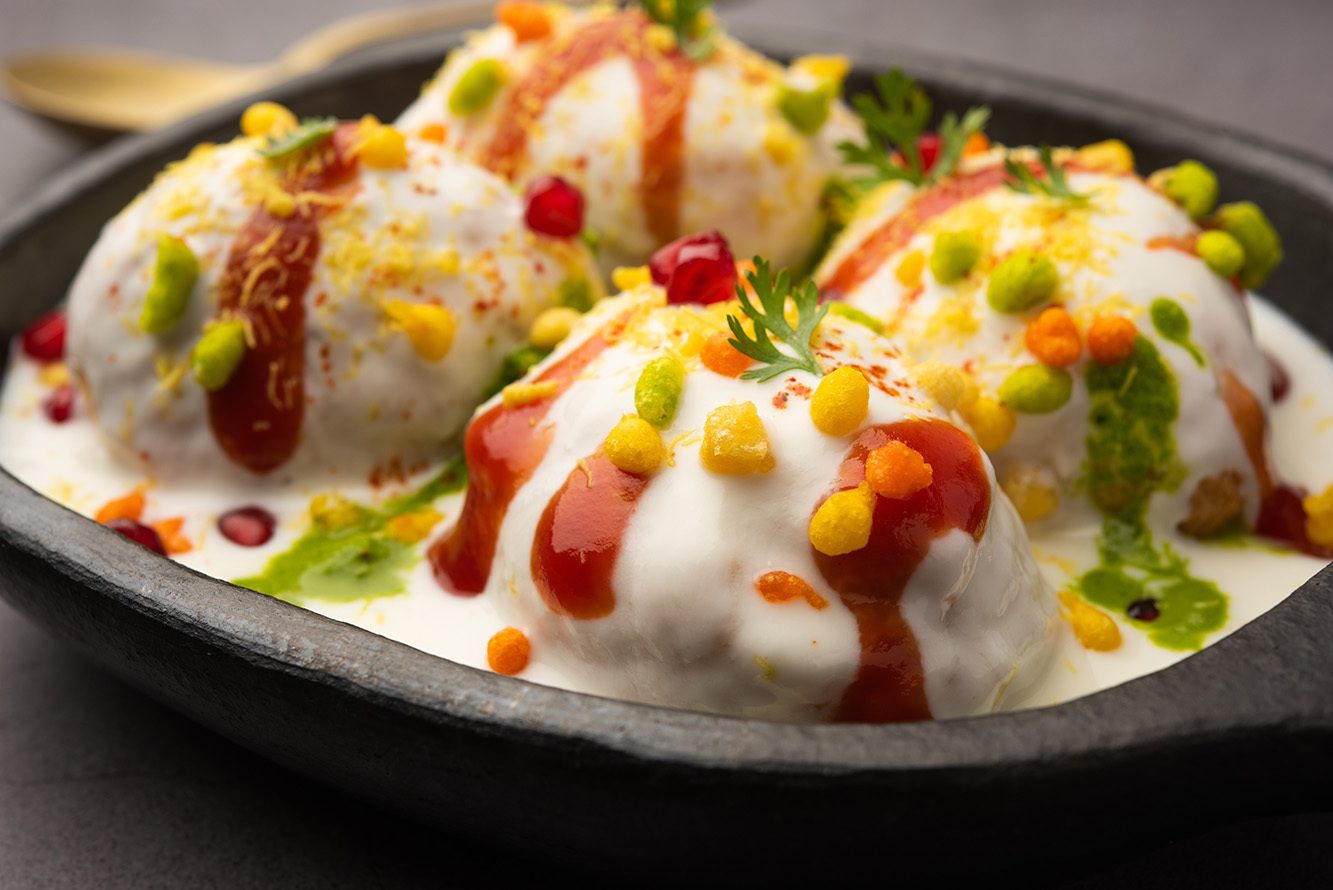
Crack It With Mathri!
Mathri is a Rajasthani snack. It is crackers made with wheat flour, gram flour, semolina, carom seeds and asafoetida. It is made in a triangular or circular shape by rolling each portion of dough. Then it is fried in medium-hot oil till it turns crispy. Mathri is one such snack that can stay edible for a long time. It can be stored at a room temperature and can be enjoyed as a tea-time snack. If you are planning to travel this Holi, then this is an ideal snack to carry along. Enjoy it with mango or lemon pickle. This is also the absolute snack for people who crave for spicy foods in the midst of desserts.
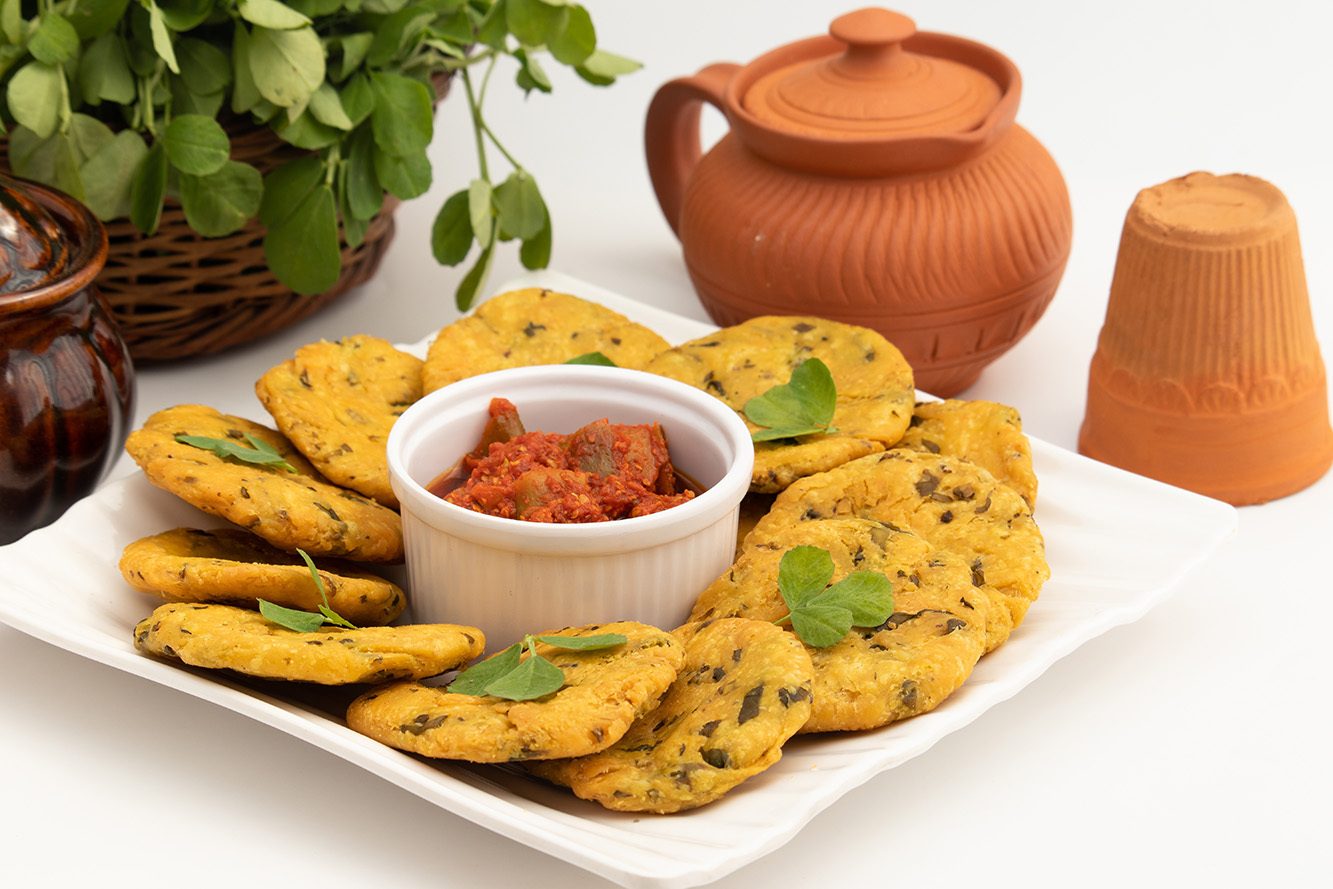
Thandai - Cool Sips of Tradition
Spring awaits Summer, seasonal transition makes our immune system prone to weakness. It is time to cool your body down and make it immune to tolerate the scorching heat. What could be the best way to do it? Sip a glass of Thandai! Thandai is a popular traditional Indian beverage. It is prepared with chilled-milk, nuts, saffron, rose petals, fennel seeds, cardamom and sugarcane extract. It has the ability to instantly hydrate your body while also improving gut health. The initial mention of Thandai dates back to 1000 BCE, this makes it one of the oldest drinks in the world. It is a major part of the street-food culture of one of the oldest cities – Varanasi. Holi celebrations in Varanasi is incomplete without Thandai. Ring in the festival of colours in ‘Banaras style’ with this cool drink.

As you gather with loved ones to celebrate the joyous occasion of Holi, let these scrumptious delicacies add an extra layer of happiness and flavour to your festivities! ●
A Sustainable Celebration Guide
sustainability
This Holi, let us embrace eco-conscious practices by saying no to water wastage, plastic and artificial colours, while still infusing our celebrations with joy and vibrancy.
Juhi Chakraborty
S
pring is here and so is the time to celebrate the most vibrant festival. This year, let us embark on a journey of celebrating Holi in an eco-friendly manner, ensuring that our joyous revelry does not harm the environment. As we gear up for the festivities, it is essential to prioritise sustainability. So, this Holi adopt the following eco-friendly ways to celebrate the festival while taking care of the environment and Bura Naa Maano, Holi Hai!
Keep It Dry
It is essential to be mindful of water wastage. Instead of indulging in water-intensive activities like water balloons and pichkaris, opt for dry colours. Not only does this conserve water, but it also reduces unnecessary garbage and pollution.
Ditch The Plastic
Traditional Holi accessories like water balloons and pichkaris are often made of plastic, contributing to environmental pollution. This year, make a conscious effort to ditch plastic and opt for eco-friendly alternatives. Use fabric pouches or recycled paper bags for carrying colours, minimising plastic waste.
Be Kind To Animals
Animals are often most targeted during festivals and people involve them for fun. But remember to celebrate an animal-friendly Holi. Do not throw colours on pets and other stray animals. And stop those that are doing so.
Choose Organic Gulaal
Embrace the tradition of playing Holi with natural colours, which are not only safe for your skin but also gentle on the environment. Look for organic gulal options available in the market, free from harsh chemicals and heavy metals. Alternatively, consider using flower petals for a sustainable and picturesque celebration.
Embrace Minimalist Decorations
Bid adieu to plastic decorations during Holi and choose environmentally friendly ways. Decorate your home with paper or environmentally friendly products. Fold origami decorations, craft colorful garlands from recycled paper, or paint designs on fabric scraps. Use leaves, flowers and branches to create simple yet beautiful centerpieces and accents.
Let us make this Holi a memorable and sustainable one by incorporating these eco-friendly practices into our festivities. By taking small steps towards environmental conservation, we can enjoy a vibrant and joyful celebration while respecting the planet we call home. ●
Enhancing Search Experience
partnerspeak
a-connect search powered by Google Cloud Vertex AI.
Murari Ramuka, Nitin Nyati & Vishal Soni
I
n our pursuit to foster a digital-first culture within Adani and amid the digital transformation of a-connect magazine, a pivotal business need emerged - enabling users to seamlessly search through relevant articles across our monthly newsletters.
The objective was clear: to provide users with a frictionless search experience, facilitating easy access to any information within a-connect. This challenge, resonant with many organisations today, demanded solutions that spanned various aspects:
- A fully managed, scalable and readily available search service.
- AI-powered semantic search, capable of understanding user intent and delivering a next-gen search experience.
- Capability to search across text, images, and video within our enterprise ecosystem.
- Leveraging LLM-based summarisation, corresponding citations and chatbot integration for enhanced functionality.
A fitting ally was found in Google Cloud Vertex AI - an end-to-end platform offering a comprehensive suite of tools for generative AI and traditional AI applications. With access to over 130 foundation models and advanced features like Gemini multimodal models, Vertex AI presented itself as the ideal platform to address the needs.
At the heart of this platform lies Vertex AI Search, a component powered by Google Cloud, designed to empower organisations in building Google-quality search capabilities on their own data. Leveraging Google's unparalleled expertise in search technology, Vertex AI Search promises superior search functionality, coupled with GenAI capabilities, tailored for enterprise data.
What sets Vertex AI Search apart is its low-code/ no-code platform, enabling organisations to deliver relevant, personalised search experiences within minutes, whether for enterprise applications or consumer-facing websites.
Gemini being multimodal is capable of understanding virtually any input, combining different types of information, and generating almost any output.
In addressing the challenges, Vertex AI Search offered a host of capabilities:
- Quick setup of Google-quality multi-modal, multi-turn search experiences for both customers and employees.
- Groundbreaking search results, combining enterprise data with LLM knowledge.
- Implementation of enterprise access controls to ensure information is surfaced only to authorised users.
- Highly scalable vector embedding search through Vector Search.
- Invaluable features such as summarisation, citations, relevance scores and flexible LLM style prompting to facilitate knowledge discovery.
- Blended Search functionality, allowing users to run a single query across structured data, unstructured data, and public web pages.
Partnering with Google Cloud, Adani Media and Communications embarked on a journey to build an AI-enabled search experience powered by large language models and generative AI, aimed at finding the most relevant information on our platform, https://connect.adani.com.
Vertex AI Search on the a-connect website is meticulously crafted to power user queries across a diverse range of content, aimed at streamlining knowledge discovery and access for both customers and employees.
With Vertex Out-Of-The-Box (OOTB) Search, the process has been streamlined, simplifying search applications into just a few clicks. It is a full-fledged OOTB Search Engine, equipped with parsing, chunking, embedding, indexing/storage, semantic+token-based search, and advanced query understanding.
Moreover, Vertex AI Search provides specialised tools for website indexing, going beyond basic keyword search to offer features such as semantic understanding, faceted search and question answering capabilities.
Enabling advanced website indexing is a straightforward process, requiring activation at the time of Data Store creation, with domain verification being a prerequisite for utilising advanced indexing features.
Today, powered by Google Vertex AI search with GenAI capabilities, a-connect offers a rich and personalised search experience, marking a significant milestone in our digital journey. ●
The writers are Customer Engineers at Google Cloud.
entertainment
The Big ‘O’ Moment At Oscars 2024

Christopher Nolan’s Oppenheimer, an unsettling look at the dawn of the atomic era, dominated the 96th Academy Awards, winning seven prizes, including best picture and best director.
Juhi Chakraborty
C
oming into the Oscars 2024 ceremony, anticipation was high for filmmaker Christopher Nolan’s intense biopic Oppenheimer, which had the most nominations – 13. And as expected, the toast of all the Hollywood awards season of the year, the film took all top prizes, including best film, best director for Nolan, best actor for Cillian Murphy’ for his haunting lead performance as J Robert Oppenheimer and best supporting actor for Robert Downey Jr for his turn as a vengeful bureaucrat.
Murphy’s performance as J Robert Oppenheimer in the biopic about the creator of the atomic bomb has vaulted the 47-year-old a fixture in Nolan films and a household name in the UK and his native Ireland, into Hollywood stardom.
Oppenheimer was a change of pace for Downey, who spent much of the past two decades playing Iron Man in Marvel movies. “Here’s my little secret: I needed this job more than it needed me,” Downey said in his acceptance speech. The film also won Best Original Score and several technical awards.
Hosted by Jimmy Kimmel for the fourth time, the ceremony saw La La Land star Emma Stone earning her second-best actress Oscar, this time for Poor Things. She thanked her director Yorgo Lanthimos, with whom she just made another movie, Kinds of Kindness. Stone’s win was one of four victories for Poor Things, which also earned statuettes in several technical categories.
Da’vine Joy Randolph earned best supporting actress for her role as a grieving cafeteria manager grappling with the death of her son in The Holdovers. Tearing up, Randolph thanked voters for “seeing me,” adding, “for so long, I’ve always wanted to be different, and now, I realise, I just need to be myself.”
American Fiction, a satire that explores race and art, won best adapted screenplay, while the courtroom drama Anatomy of a Fall, earned best original screenplay.
Barbie may have been snubbed majorly at the Oscars nominations list, singer Billie Eilish made history, becoming the youngest two-time Oscar recipient at age 22 after winning best song for her “Barbie” ballad “What Was I Made For?” She co-wrote the song with her brother, Finneas O’Connell — the pair previously won for writing the theme to 2021 Bond theme No Time to Die. On the other end of the age divide, Hayao Miyazaki became the oldest winner of best animated feature for The Boy and the Heron. The 83-year-old Japanese animation maestro previously won for 2002’s Spirited Away.
While India’s official entry, Malayalam film 2018: Everyone Is A Hero, did not make it to the nominations stage, To Kill A Tiger, a documentary set in India, competed for Best Documentary Feature, but eventually lost to 20 Days In Mariupol. However, stills from RRR in a video celebrating stunt performers and a mention of art director Nitin Chandrakant Desai in the In Memoriam segment Memoriam, saw an India connect. ●
The Great Indian Diet
lifestyle
Discover the holistic path to vibrant health through the time-honoured wisdom of the Great Indian Diet, where nourishment transcends mere weight loss goals.
Dhara Vala
I
n today’s fast-paced corporate world, maintaining a healthy lifestyle is paramount for optimal performance and well-being. The Great Indian Diet, with its rich culinary heritage and diverse flavours, offers a holistic approach to nutrition, emphasising the importance of a balanced diet and incorporating all five food groups. However, amid the hype surrounding diets in recent years, many individuals find themselves trapped in cycles of depression and compromised health. Contrary to popular belief, a diet is not merely a temporary eating plan but rather a crucial component of a broader lifestyle framework.
The term ‘diet’ often evokes connotations of rigid eating regimens and deprivation. However, it should be viewed as a reflection of one's daily food routine within the context of their lifestyle. A comprehensive approach to health encompasses various factors such as work commitments, sleep quality, exercise routines, stress levels, culinary preferences and individual personalities. Designing an effective food plan necessitates consideration of these elements to ensure it aligns with both physical and mental well-being.
A healthy diet should not induce feelings of deprivation or hardship. Instead, it should be manageable, enjoyable and seamlessly integrated into one’s daily routine. Here are some key attributes of a good and healthy diet:
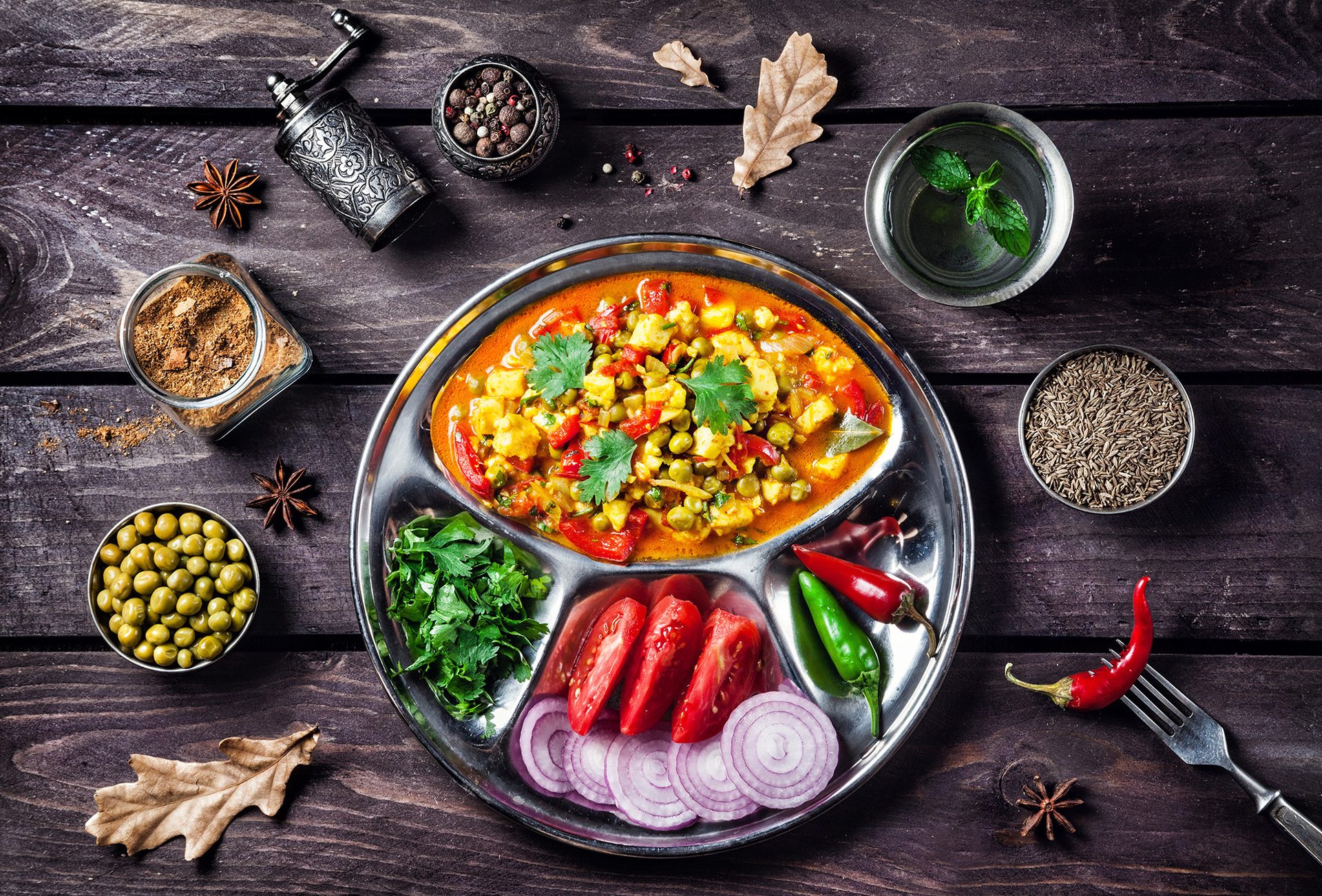
- Is easy to do and sustain.
- Keeps you excited and interested.
- Gives your body nutrition.
- Enables your body to absorb nutrition.
- Fits into your lifestyle, no matter how hectic it is.
- Works on the principles of moderation and compensation.
- Helps you achieve and maintain a healthy weight.
- Looks after the health of your hair and skin.
- Prevents or cures disease.
- Builds strong immunity.
- Keeps your vital organ and cellular system healthy.
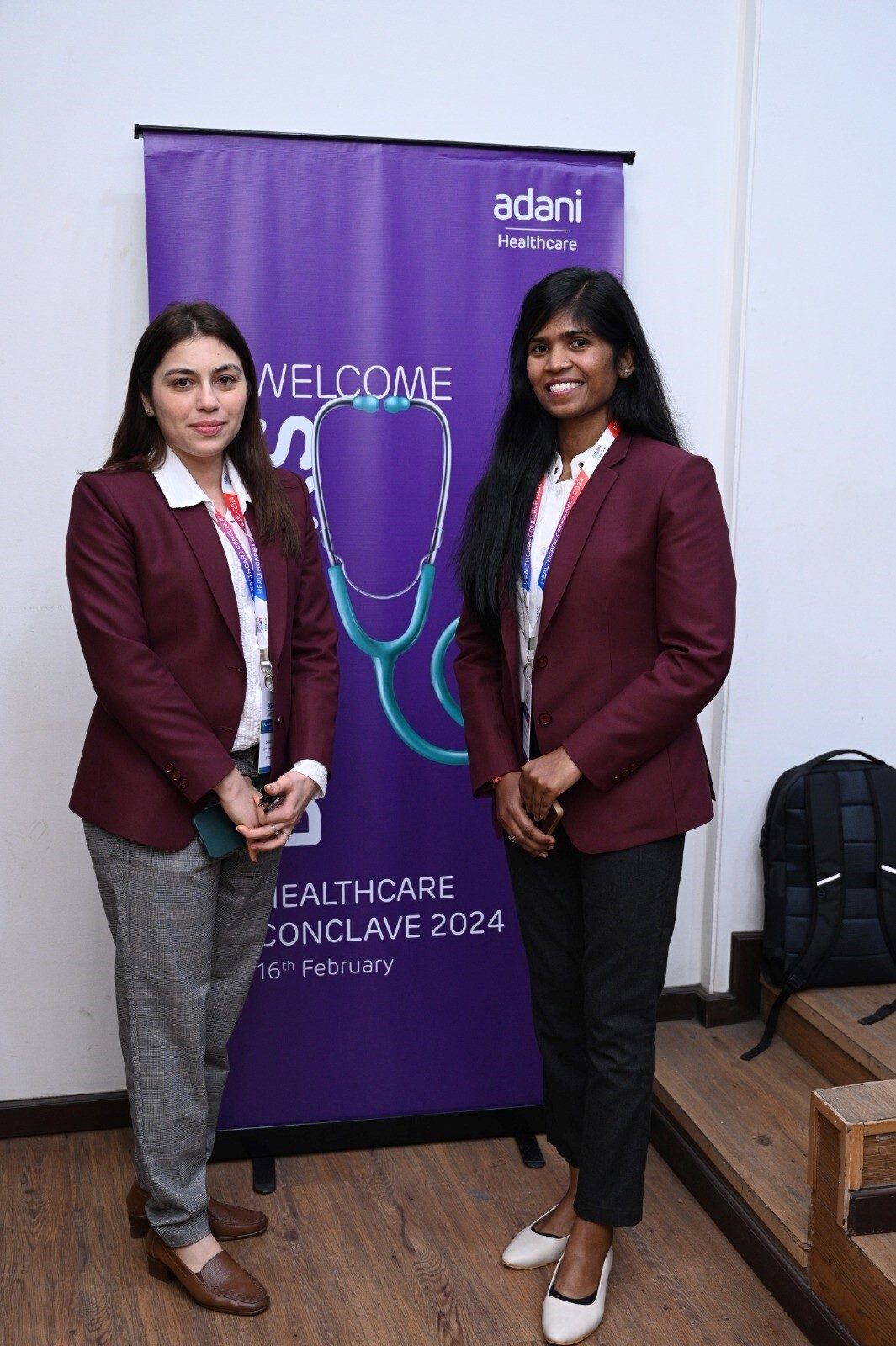
Being healthy is not just about following a strict diet plan. It is about making smart choices every day. So, instead of chasing after quick fixes, focus on building a lifestyle that keeps you feeling great inside and out.”
Nevertheless, individual dietary needs vary based on diverse factors such as geographical location, body type, occupation, sleep patterns, physical activity levels, stress management, overall health status and personal habits. Therefore, blindly following generic diet plans or succumbing to the allure of trendy regimens can prove ineffective and potentially detrimental to health.
There are no shortcuts to achieving optimal health. Despite the proliferation of health clinics, specialty foods, fitness centres, and supplements, sustainable well-being ultimately hinges on lifestyle choices. While certain herbs, plants and spices may aid in weight loss, their efficacy is contingent upon a holistic approach encompassing adequate sleep, balanced nutrition, regular exercise and mental resilience.
In essence, the Great Indian Diet transcends mere weight loss aspirations. It embodies a philosophy of holistic nourishment, catering to the diverse needs and preferences of individuals seeking to optimise their health and well-being. ●
The writer is a Dietician at the Adani Health Services.
happenings
Adani Gangavaram Port Hosts INS Vikramaditya
The Adani Gangavaram Port has welcomed the Indian Aircraft Carrier INS Vikramaditya that berthed at the port ahead of its participation in Milan 24. This event not only underscored the port's strategic importance as a pivotal hub for naval operations but also highlighted its crucial role in enhancing maritime security. The arrival and departure of INS Vikramaditya on 17 and 19 Feb, 2024, respectively, marked a significant milestone for both the port and the nation, exemplifying the strong synergy between maritime infrastructure and defense operations.
The visit showcased Gangavaram Port's capacity to support critical maritime activities, emphasising its integral role in defense initiatives and advancing maritime security in the region. By facilitating such prestigious events, Gangavaram Port reaffirms its position as a vital asset in safeguarding the nation's maritime interests and promoting regional stability. ●
Adani Hazira Port Makes History With Record Yellow Peas Shipment
On 11 Feb 2024, Adani Hazira Port Dry Terminal achieved a monumental milestone by handling the largest-ever shipment of Yellow Peas at an Indian port. The arrival of MV PHAEDRA, carrying a staggering 77,000 Metric Tons of Yellow Peas, marked an unprecedented moment in the annals of Indian maritime history.
This remarkable accomplishment underscores the port's exceptional capabilities and operational efficiency. Through meticulous planning and state-of-the-art infrastructure, Adani Hazira Port has not only met but surpassed industry standards, setting a new benchmark for excellence.
The success of Adani Hazira Port serves as a beacon of inspiration for the entire maritime sector, urging others to aspire to greatness. It underscores the significance of innovation, determination, and collaborative effort in propelling progress forward. As Hazira Port celebrates this historic milestone, it is essential to recognise the dedication and hard work of all stakeholders involved, from port authorities to the diligent shipping crews. Their collective endeavors have propelled Adani Hazira Port to unparalleled heights and laid the foundation for future triumphs.
Adani Hazira Port remains committed to pushing boundaries and establishing even loftier benchmarks, reaffirming India's stature as a global leader in maritime trade and logistics. ●
PM Inaugurates Integrated Terminal T3 at Chaudhary Charan Singh International Airport
The inauguration of Terminal 3 at Chaudhary Charam Singh International Airport (CCSIA) in Lucknow on 10 Mar 2024, brings a new era of Aviation Excellence in Uttar Pradesh. Built at a staggering cost of INR 2400 crore, T3 stands as a testament to modern infrastructure and efficiency, boasting a capacity to handle 4,000 passengers during peak hours. With Phase I already operational, the terminal can serve 8 million passengers annually, featuring elevated pathways and state-of-the-art amenities to streamline the travel experience.Under the visionary leadership of Karan Adani, Managing Director of Adani Ports & Special Economic Zone Ltd, plans are underway to transform CCSIA into a global aviation hub, with ambitions to serve 38 million passengers annually by 2047-48, thereby catalysing economic growth and creating over 13,000 job opportunities. ●
AVMB Students Commit To Plant 25,000 Trees On Annual Day Celebration
The Adani Vidya Mandir, Bhadreshwar (AVMB), situated in the Kutch region of Gujarat, marked its annual day celebration on 5 Mar 2024. Themed ‘Utkarsh,’ this year’s event centered around the United Nations Sustainable Development Goals (SDGs).
In line with the theme, 600 students of AVMB pledged to plant 25,000 saplings over three years across the school premises and surrounding areas, including mangroves along the coast.
Jugeshinder (Robbie) Singh, CFO of the Adani Group, graced the occasion as the chief guest, with Chetan Misan, SDM, Mundra, as the guest of honour. The event, creatively organised by the school staff and teachers, showcased student projects emphasising the importance of living in harmony with nature, featuring models on environmental and water conservation, as well as dance, drama and poetry performances.
Under the Adani Foundation's patronage, AVMB has been offering free education since 2012 to children, many of whom are first-generation learners from socio-economically marginalised communities, particularly fisherfolk, in and around Bhadreshwar, Kutch. Affiliated with the Gujarat State Education Board (GSEB), the school provides free schooling from grade 1 to 10, covering tuition fees, textbooks, uniforms and nutritious meals.
AVMB's dedication to educating underprivileged children was recently recognised with the "Education Excellence - Empowering India Awards 2024”. ●


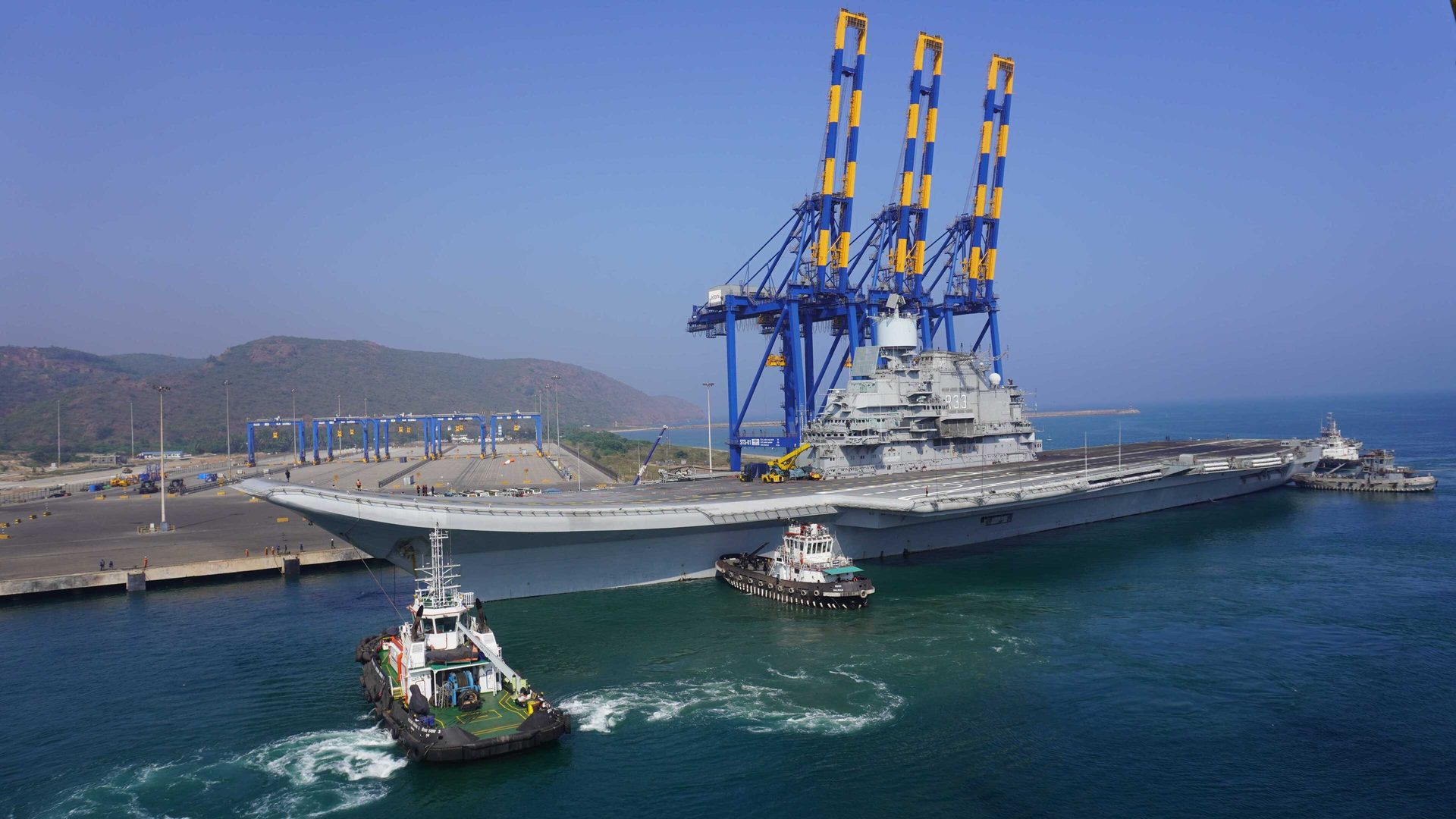



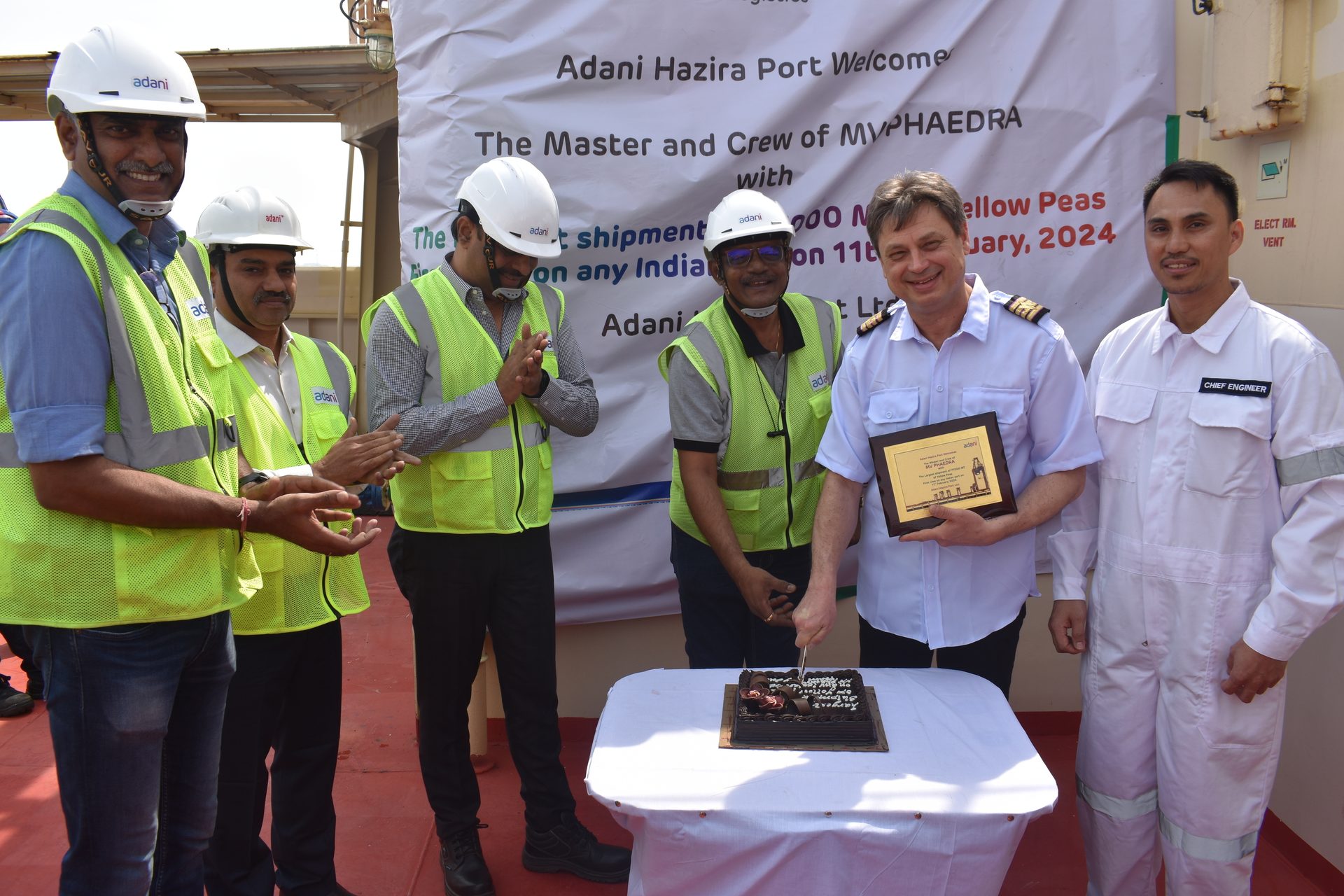
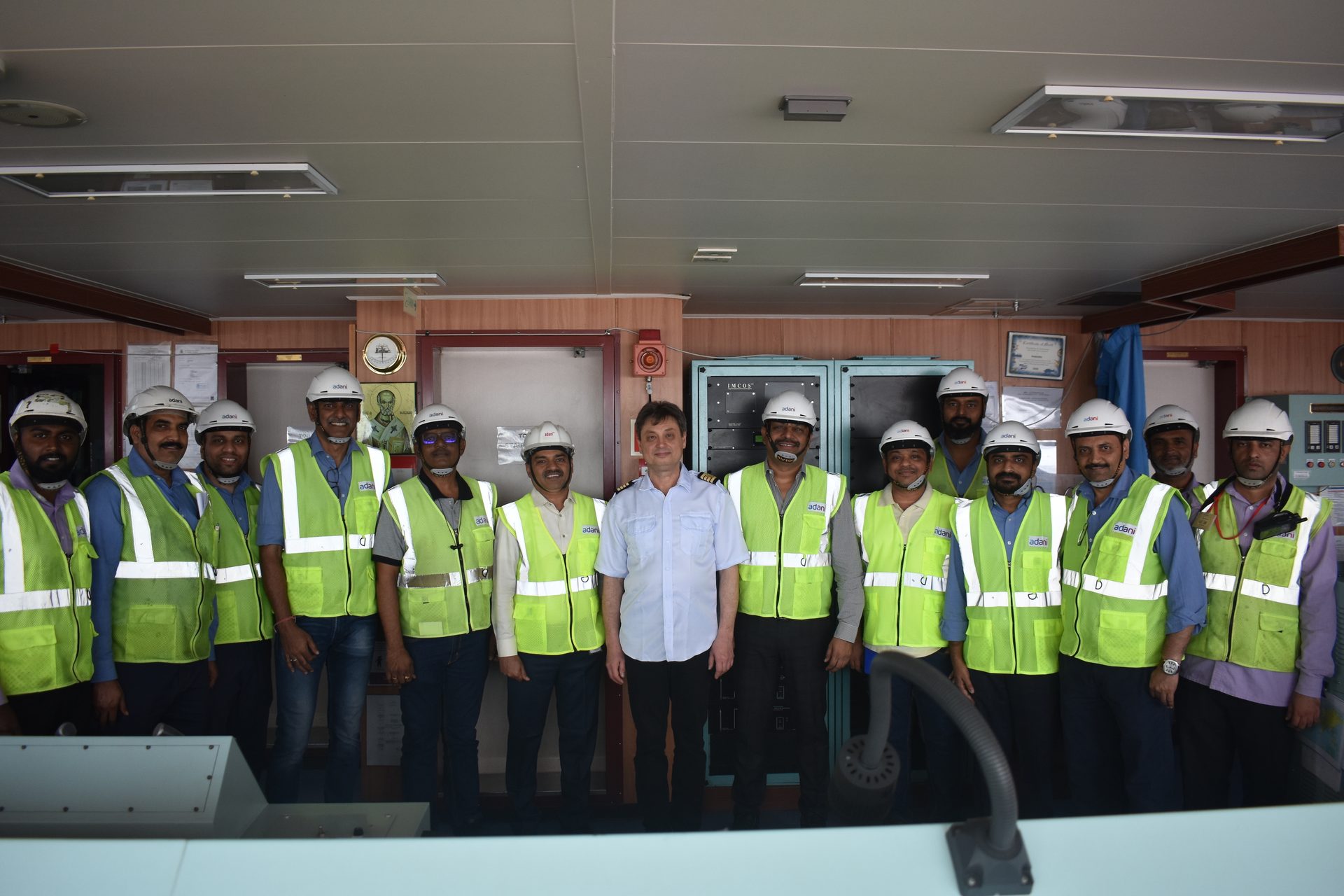
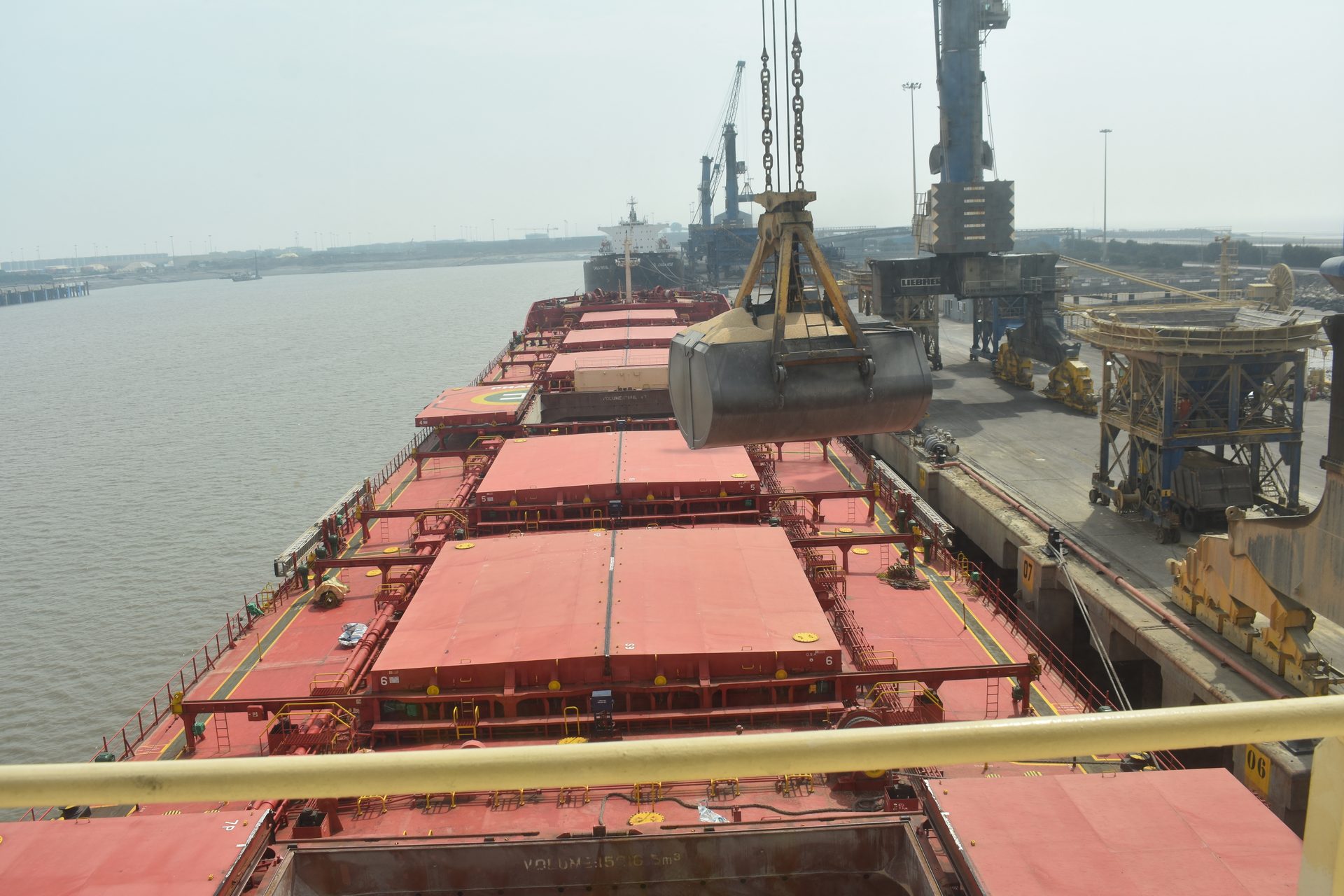
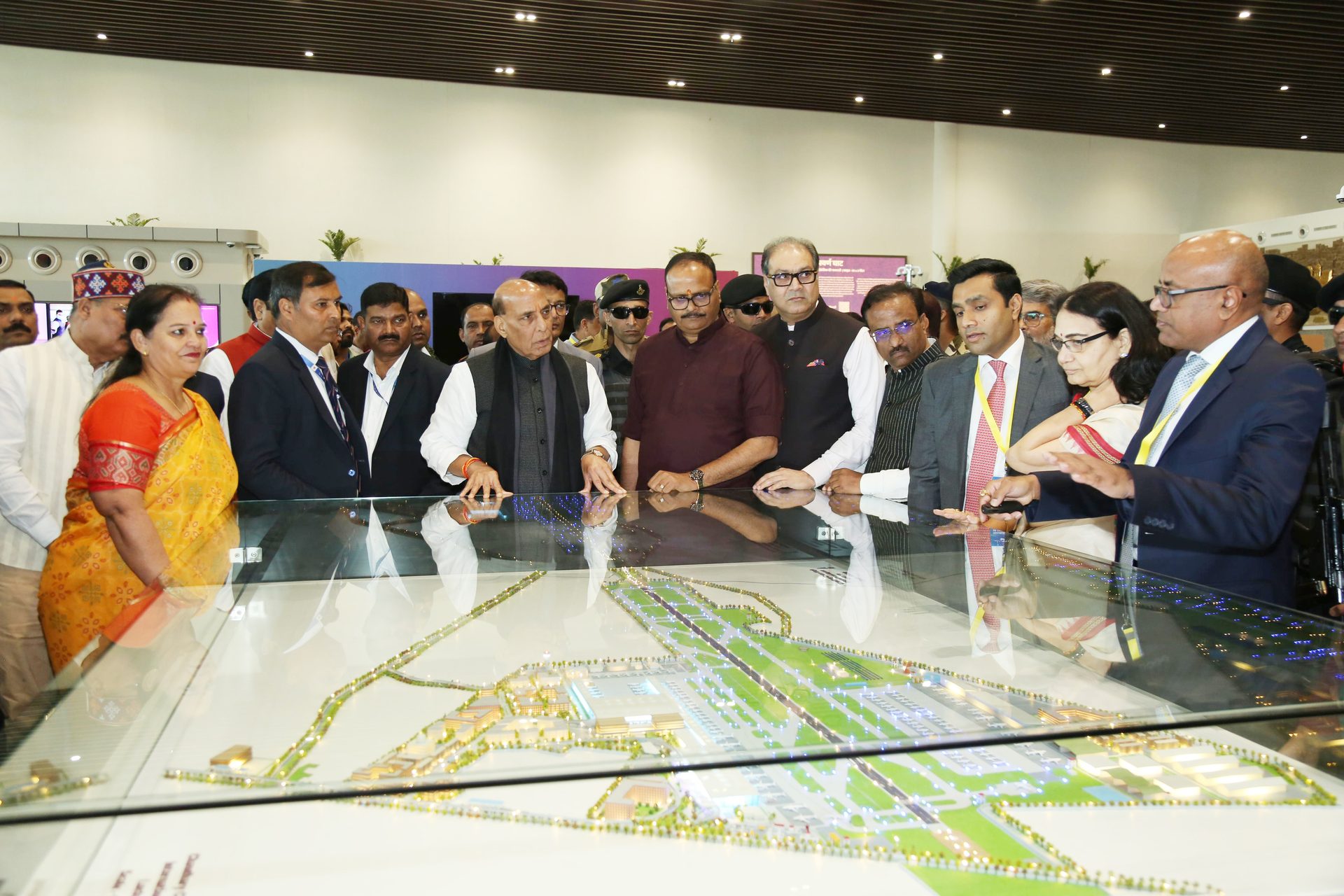
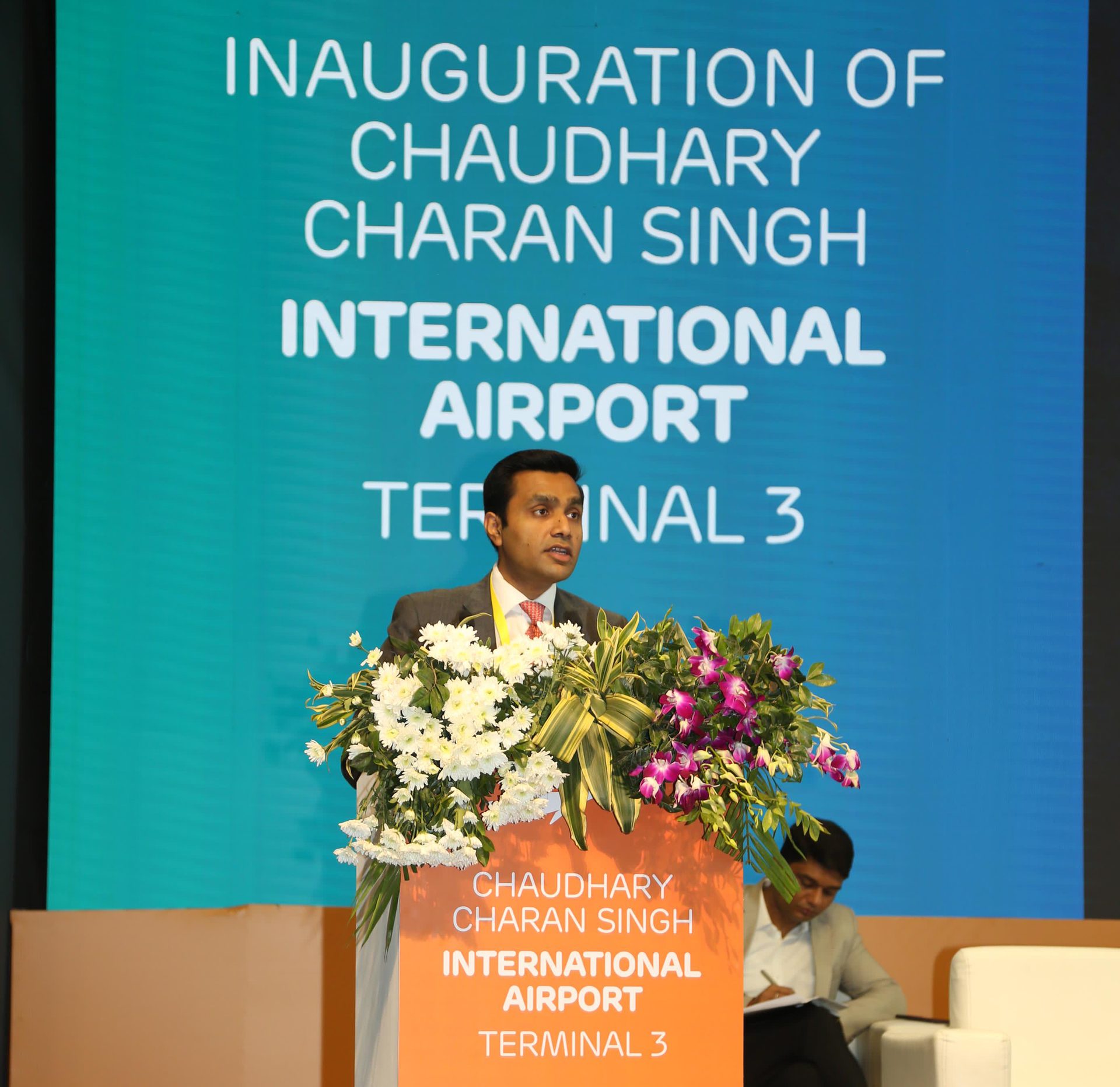
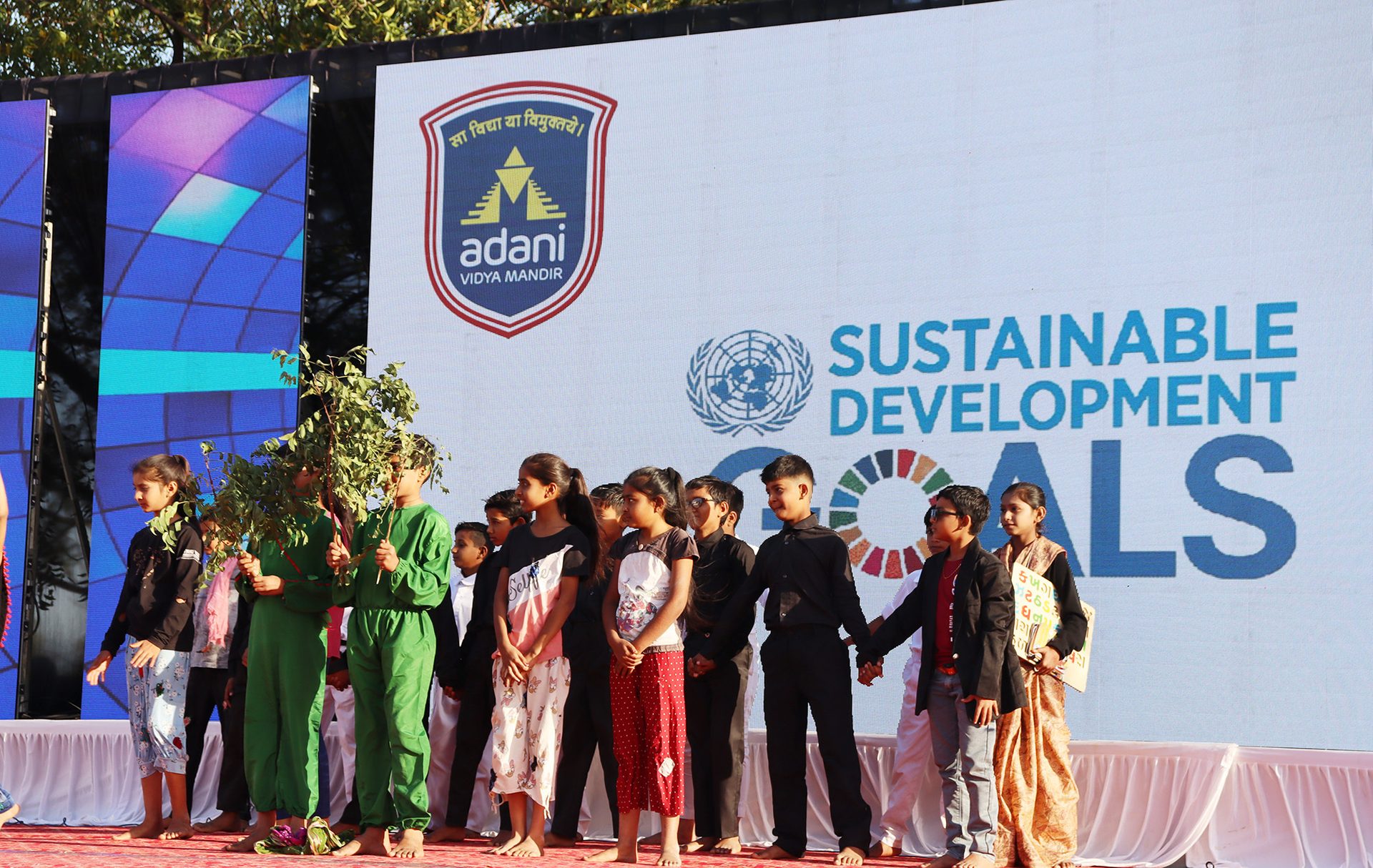
A Kaleidoscope Of Wonders And Flavours
travel
Discover the captivating city of Agra, where every step echoes with history and every bite unveils a culinary symphony.
Poonam Advani
I
n the heart of northern India, along the banks of the majestic Yamuna River, lies the captivating city of Agra. It isa place that whispers tales of love, grandeur and a rich history that had shaped the fabric of India. The journey through the bustling streets and ancient monuments of Agra was one of the discoveries waiting to be made.
The adventure began at the break of dawn, as the first golden rays of sunlight gently caressed the iconic silhouette of the Taj Mahal. Standing before this architectural marvel, one could feel overwhelmed by its sheer beauty and the timeless love story that inspired its creation. The Taj Mahal's architectural design was indeed symmetrical, giving it a consistent appearance from all four sides. As the morning mist dissipated, revealing the intricate marble carvings and delicate inlays, one could be transported back in time to an era of opulence and romance.
But Agra is not solely defined by the Taj Mahal; it is a city that pulsates with life and energy at every turn. As one wanders through the bustling lanes of Sadar Bazaar, the air is filled with the intoxicating aroma of spices and the vibrant chatter of eager shoppers. Here, amid the colourful array of textiles and handicrafts, one could lose themselves in a maze of sights, sounds and smells that epitomised the essence of Agra.
No visit to Agra would be complete without sampling its famed street food and the culinary adventure began with Petha. This beloved delicacy offered a variety of flavours, from the refreshing Paan to the fragrant Kesar, each bite a delightful burst of sweetness that left one yearning for more. But the gastronomic journey did not end there. Delving into the world of Bhalla, a local favourite that transformed into crispy Aloo Tikki in other parts of India, is a must. Served piping hot with chickpea curry and chutney, it is a mouthwatering treat that perfectly complemented the stunning view of the Taj Mahal as the evening sun set the sky ablaze with hues of pink and red. And do not forget Bedai, Agra's cherished breakfast staple, served steaming hot with spicy potato gravy and a dollop of curd, tantalising taste buds with its irresistible blend of sweet and tangy flavors.
Yet, Agra's culinary delights extended beyond the sweet and savoury. Indulging in Dalmoth, a dry snack crafted from a medley of nuts, spices, and fried lentils, is ideal for a leisurely winter evening in this historic city.
Beyond its iconic monuments, Agra is a city rich in history and tradition, where every corner held a story waiting to be uncovered. From the ancient temples of Raja Ki Mandi to the bustling markets of Kinari Bazaar, Agra offers a glimpse into India's cultural tapestry. Plan the visit wisely; October through March boasts pleasant weather ideal for exploring historic wonders, while July to September offers a quieter ambiance amid the serenity of rain-washed streets.
Whether marveling at the Taj Mahal's grandeur, haggling in bustling markets, or savouring local cuisine, Agra promises an unforgettable experience. So, pack your bags and immerse yourself in the magic of Agra—a destination embodying India's rich cultural heritage. ●
your corner
Unleash your creativity.
Send in your original contributions to connect@adani.com
Please do not forget to attach relevant details.
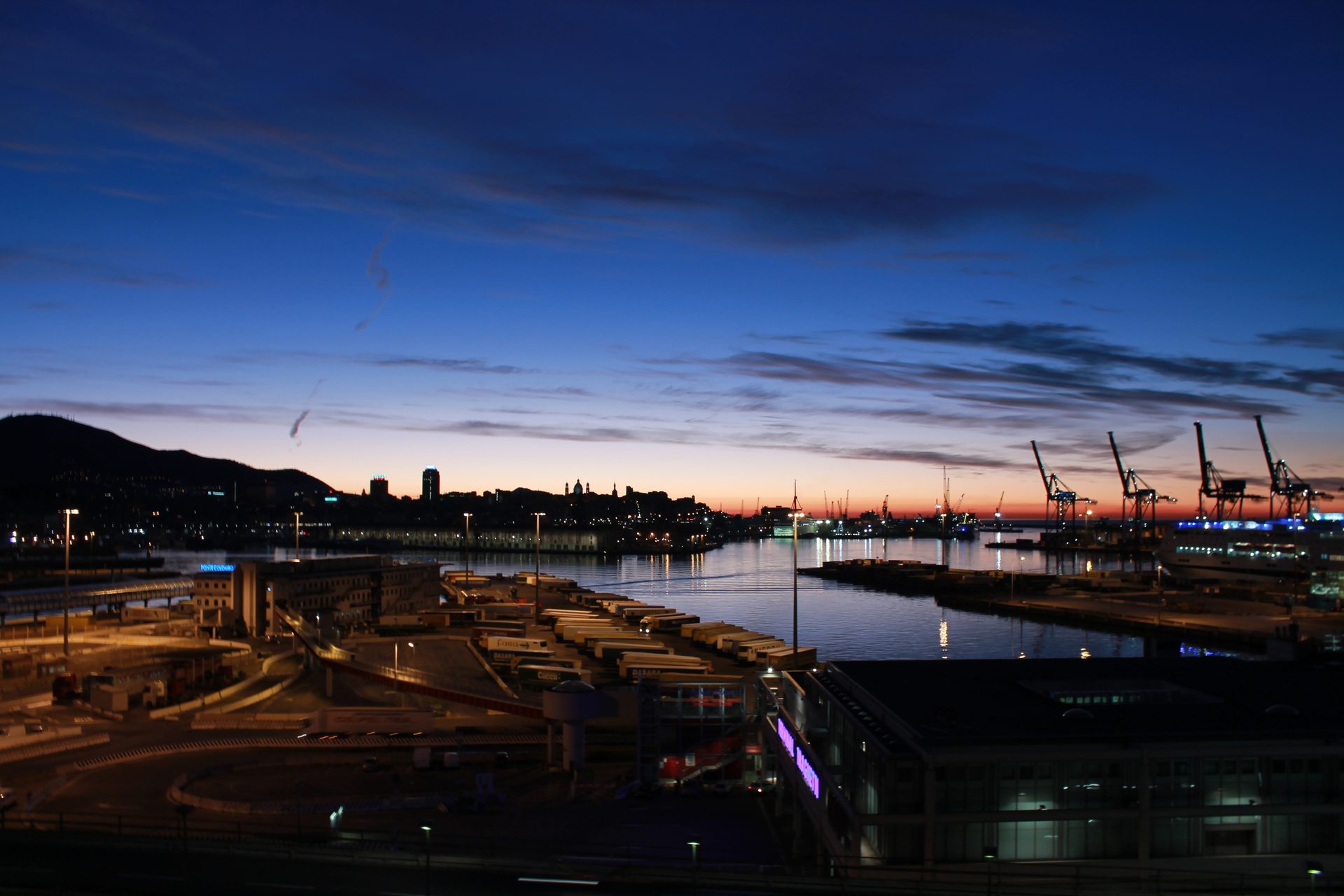
Mundra
Creek’s Edge
Rohit Kumar Srivastava
Mundra Petrochem
Shantivan Colony, Mundra
Timelapse Marvel
Manish Jain
Adani Ports & SEZ

Enveloped In The Untamed Wilderness
Monisha A
Adani Power

The Arc Of Joy
Kinnari Vyas
Adani Realty
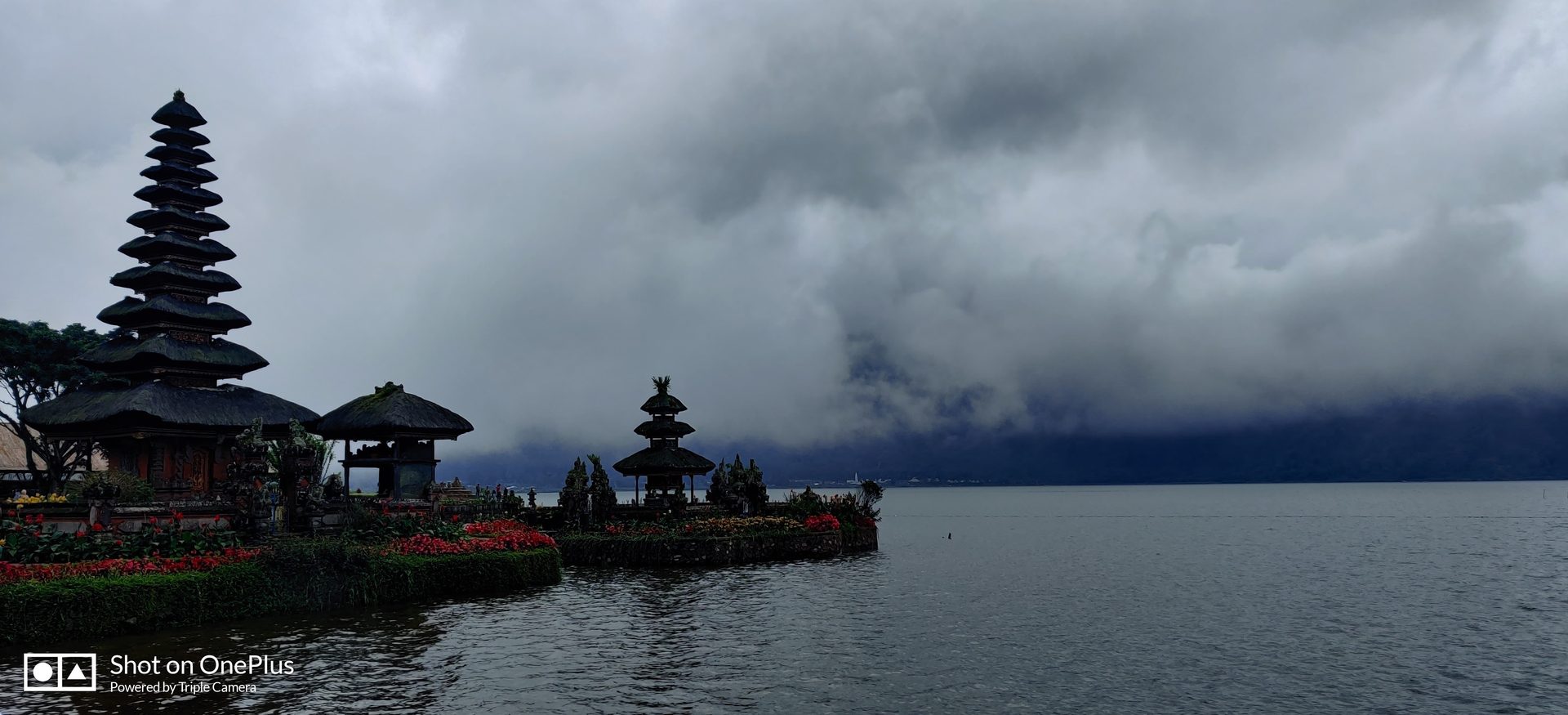
Bali, Indonesia
Escape To Paradise
Bhoomij Kansara
Adani Enterprises

Bharatpur bird sanctuary
Green Vibes And Canal Delights
Yashansh Vijay
Adani Power
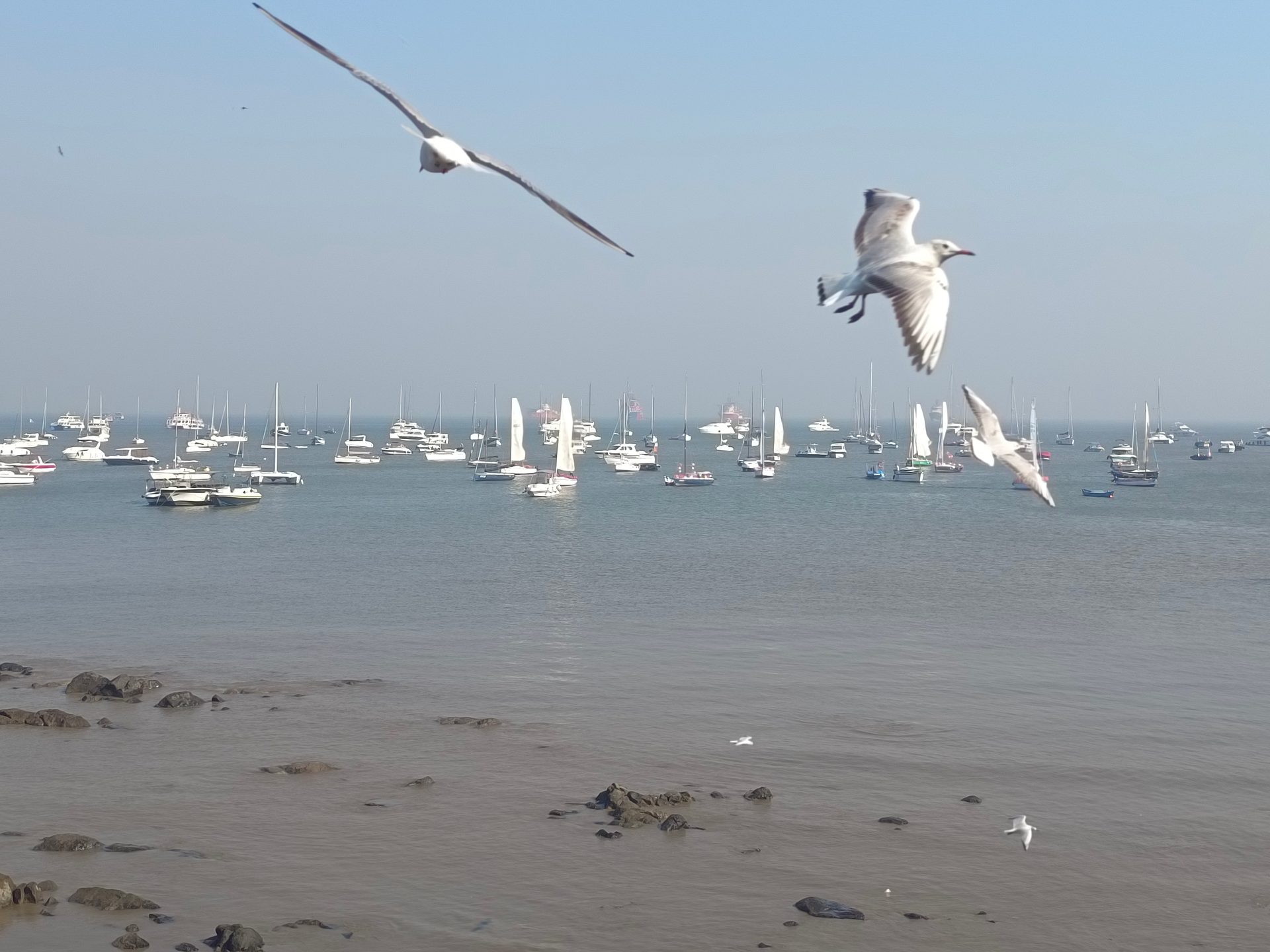
Gateway Of India, Mumbai
Life’s Odyssey: Some Sail, Some Soar
Parul Patel
Adani Ports & SEZ
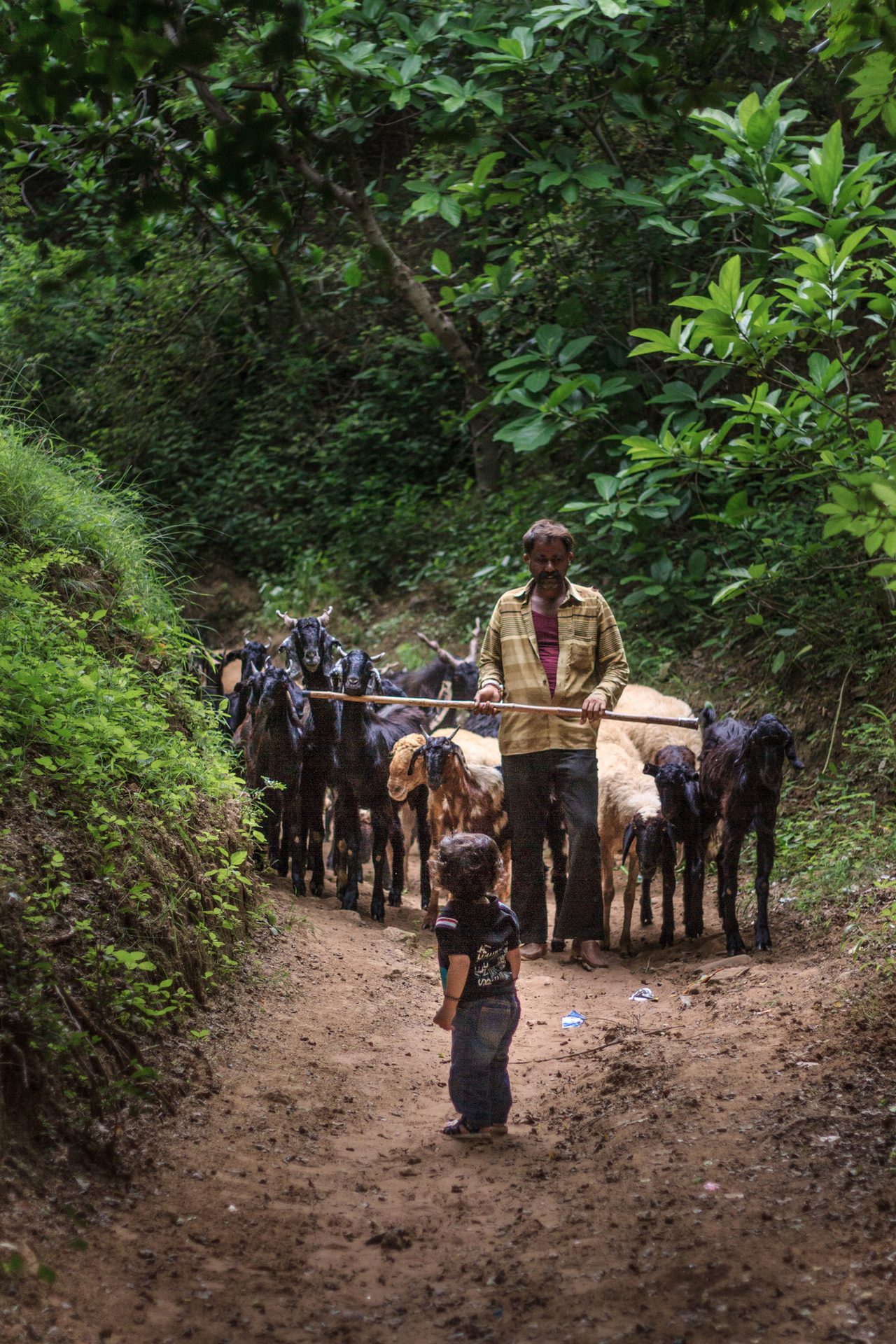
Bharatpur bird sanctuary
The Good Shepherd
Biren Brahmbhatt
Adani Ports & SEZ
Vibrant & Inclusive Platform
a-connect is super cool and colourful, keeping us in the loop with everything happening in the organisation. It's been a hit, giving us a sweet spot to share our wins, thoughts and opportunities with everyone. Shoutout to the awesome a-connect team for making sure no one feels left out.
Vanshika Jain
Corporate Legal, Adani Enterprises
Bridge to (a)Connect
Even though I'm not at the main office in Ahmedabad, a-connect keeps me in the know and connected. It gives a quick snapshot of all the cool stuff the Group is up to, helping me stay connected with the Head Office vibe.
Dipak Kalekar
Sales & Marketing, Adani Logistics
Feel-Good Read!
The Feb a-connect issue is full of uplifting tales, like how Adani bounced back and Amir Hussain Lone's inspiring journey. It also talks about staying healthy, fit and explores the lively community of Dharavi in Mumbai. It's a feel-good read that leaves you inspired and hopeful about life.
Varun Israni
Legal, Adani Ports & SEZ
Reflection Of True Values
Huge shoutout to the a-connect team for putting together such an awesome magazine! It is not just informative but also looks super slick, totally reflecting the Adani Parivar values. Each edition celebrates us in different ways, fostering that sense of community and giving us a peek into company decisions.
Bhavika Jaichandani
Group HR, Adani Enterprises
Unlocks The Essence Of Adani!
a-connect is like a window into the heart of the Adani world. The stories are touching, inspiring, and make us even more committed to the Adani vision!
Amartya Shrivastava
Legal, Adani Enterprises
Telling True Stories!
a-connect facilitates cross-departmental connections and highlights business initiatives, inspiring other departments to take similar steps. It serves as a motivational beacon, acknowledging and celebrating the efforts of individuals or groups who have initiated impactful projects. The magazine's role is pivotal in encouraging a culture of innovation and collaboration within the organisation. Cheers to a-connect for fostering a dynamic and proactive community!
Vinay Nair
Human Resources, Adani Enterprises
letters

Keep the feedback flowing. We value every letter from you.
We’d love to hear More from you!
a-connect is your magazine.
We are committed to providing you informative and engaging content through a-connect. To do this, your insights and feedback are crucial.
As we strive towards excellence, we value your inputs. We want to know what you liked, what you did not, and how we can improve.
We would love to keep hearing from you on what more we could cover, explore or highlight in a-connect. Are we missing something? Is there a particular topic you would like to learn more about? Are there any trends you would like us to follow?
Your suggestions will help us to deliver the content most relevant to you. Please connect with us. We will publish a selection of the comments we receive.

